- The Most Visited Tourist Attractions In Italy
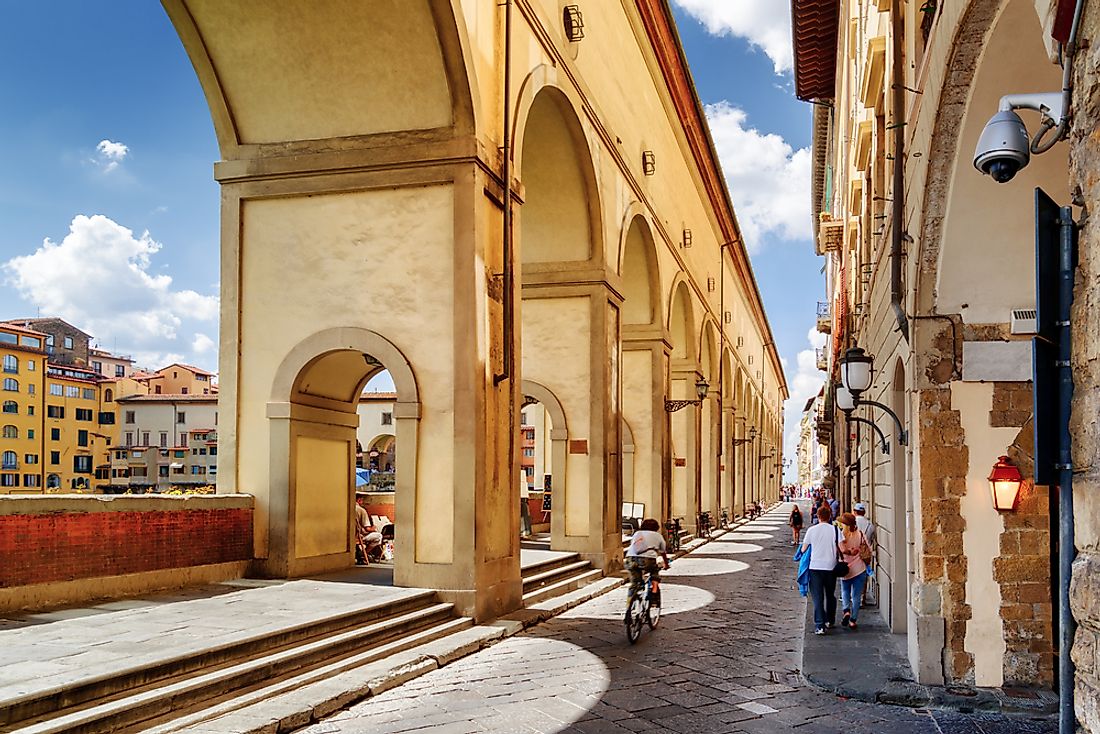
Italy is one of the world’s most desired tourist destinations. The country is renowned for its historical and cultural attractions. Tourists from across the globe visit this country every year to explore its numerous cities and their attractions. The most visited tourist attractions in Italy are mentioned below:

10. Colosseum, Palatino, and Roman Forum
The Colosseum symbolizes Roman culture and history. It is an oval amphitheater that is located in Rome and is the biggest amphitheater to be ever built in the world. It was built between AD 72 and 80. Although now only a tourist attraction, the Colosseum formerly hosted mock sea battles, animal hunts, public executions, and other events. The Colosseum’s massive size can be estimated from the fact that it has 80 entrances and could seat 50,000 spectators at one time. Located nearby is the Palatine Hill or the Palatino, one of the city’s oldest parts overlooking the Roman Forum that is located about 40 m below. The area has giant pine trees and ancient ruins. It offers majestic views of the surrounding city. The rectangular Roman Forum was formerly a marketplace in ancient Rome. The ruins of ancient government buildings surround this forum. The area hosted many important events of the ancient Romans like the triumphal processions, gladiatorial matches, and the trials of the criminals. The above three historical sites located close to each other constitute the most visited destination in Italy.
Pompeii is the second most visited place of interest in Italy. It is located close to Naples. The site has been declared as a UNESCO World Heritage Site. It hosts the ruins of an ancient Roman city that was destroyed nearly completely due to the eruption of the volcano Mt. Vesuvius in AD 79. A tour through Pompeii gives an insight into the ancient Roman way of life and culture. There are several attractions in the area like the Thermal Baths that represent ancient health clubs, the Forum where gatherings of the top officials and priests of the ancient city would take place, the Theatre where plays were staged out in the ancient times, and so on.
8. Uffizi Gallery and Vasari Corridor
Both of these attractions are located in the Historic Centre of Florence. The Uffizi Gallery is an art museum which hosts famous artwork from the Renaissance period. It is the most visited art gallery in the country. The Vasari Corridor is an elevated passage running between the town hall and the Palazzo Pitti. This enclosed passage is also connected to the Uffizi Gallery. A part of the passage runs over the River Arno. The corridor was built in the year 1565 by the then ruler of the region to move in a secure manner between his residence and the government palace.
7. The Accademia
Located in Florence, this is one of Italy’s most visited destinations. The most famous exhibit here is the sculpture of David by Michelangelo. Others works of this great artist, as well as other artists of Florence, are displayed here. Most of the artwork here date to the period between 1300 and 1600.
6. Castel Sant’Angelo National Museum
The fifth most popular attraction in Italy is the Mausoleum of Hadrian which is located in Rome’s Parco Adriano. The towering cylindrical building was built under the instructions of Hadrian, a Roman Emperor, to serve as a mausoleum for him and his family. The ashes of Hadrian and his family members and those of subsequent emperors till 217 AD were stored in this tomb. Later, in 401, the mausoleum was converted to a fortress and castle and finally, in modern times, it has been declared a museum.
5. Boboli Garden
This tourist destination is located in Florence and houses several sculptures dating between the 16th and 18th centuries. The Boboli Gardens represent some of the earliest Italian gardens built in the formal style. It is adjacent to the Pitti Palace that was the residence of Tuscany’s Medici grand dukes. In the past, the gardens could be accessed only by the members of the Medici family but are now open to the public for visits. The total area occupied by the gardens is 45,000 square meters.
4. La Venaria Reale
The palace is located in Venaria Reale in the Metropolitan City of Turin. It is part of a UNESCO World Heritage Site and one of the former royal residences of the Royal House of Savoy. The palace was commissioned by Charles Emmanuel II to serve as a base for his hunting expeditions. It was constructed in the late 17th century.
3. The Egyptian Museum
The Egyptian Museum of Italy is the eighth most visited attraction in the country. It is located in Turin, Piedmont. The museum hosts exhibits of Egyptian anthropology and archeology. The museum has some of the richest collections of Egyptian antiquities in the world. Three different versions of the Book of the Dead are present here.
2. Borghese Gallery
A Roman art gallery, the Galleria Borghese is located in the Villa Borghese Pinciana. It is located adjacent to another tourist attraction, the Villa Borghese gardens. The gallery exhibits a collection of paintings, sculptures, and antiquities collected by the Borghese family, a princely family of Italy.
1. The Royal Palace Of Caserta
Located in Caserta, southern Italy, the Royal Palace served as the residence of the Bourbon kings of Naples in the past. The palace was established in the 18th century. The UNESCO inscribed it as a World Heritage Site in 1997. The palace that spreads out across 235,000 square m, is regarded as the world’s largest royal residence. It is the tenth most visited destination in Italy.
More in Travel
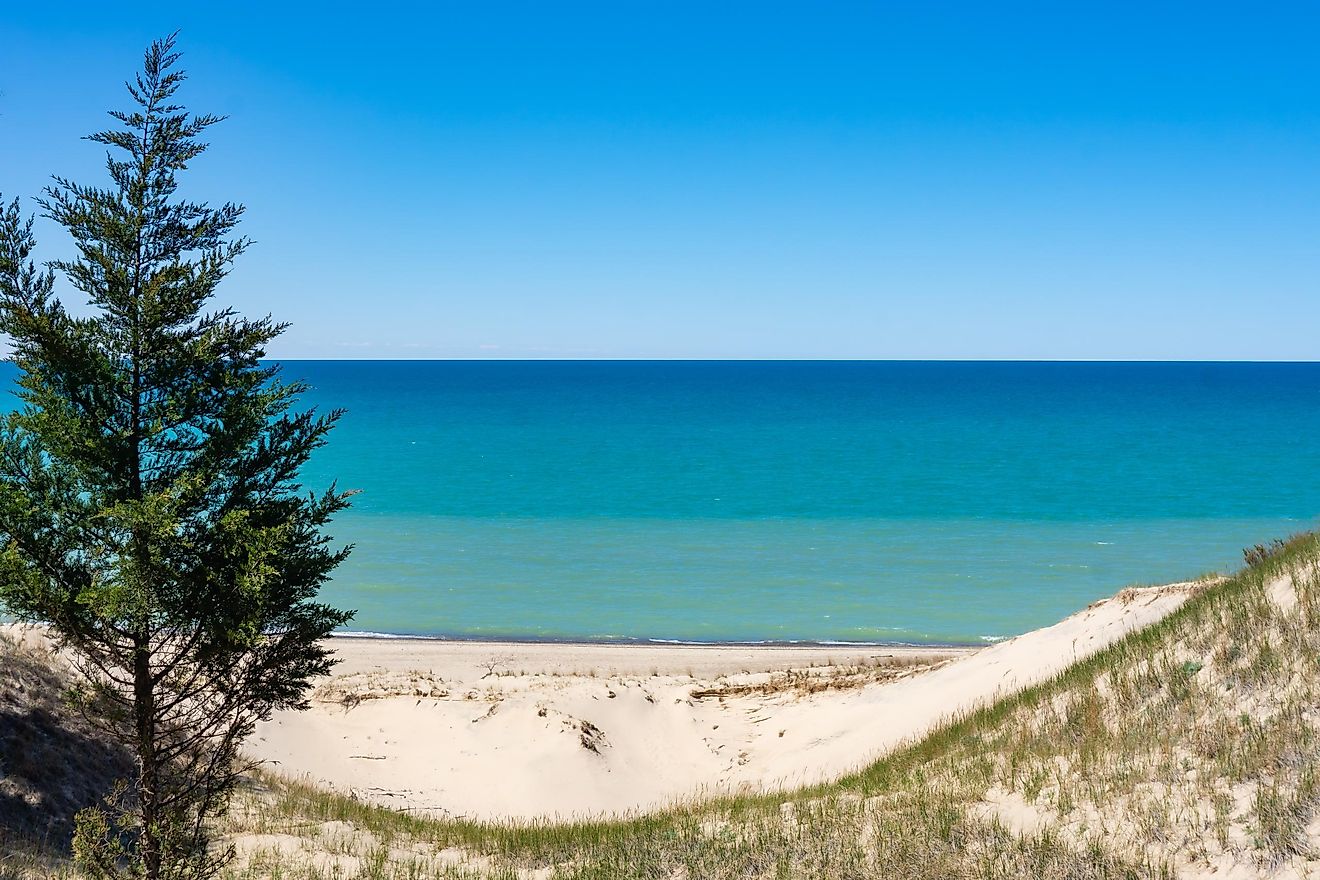
Indiana Dunes vs Warren Dunes: Comparing Two Lake Michigan Parks

13 Most Underrated Towns In New York To Take A Trip To

Tales in Transit: The Twists & Turns of World Travel

13 Most Underrated Towns In Massachusetts To Take A Trip To

9 Most Underrated Towns In Washington To Take A Trip To

Riding The Rails Across Europe: A Haphazard Adventure

An American's Guide for the Camino de Santiago

13 Most Underrated Towns In Upstate New York To Take A Trip To
Protect Your Trip »
Best places to visit in italy.
Tourists and travel experts have long agreed that Italy is a special place, so much so that the country has become a de facto bucket list destination for just about everyone. Famous for its incredible food, rich historical sites, highly regarded art, charming small towns and picturesque cities, countrysides and coastlines, it's safe to say Italy's offerings are unmatched. U.S. News rounded up the best places to visit in Italy considering a number of factors, from affordability and seasonality to sights and crowds, to help you decide exactly where to go. Have a favorite destination in Italy? Cast your vote below to influence next year's ranking.
Amalfi Coast
Cinque terre, tuscany, italy.

A standard stop on many European vacation itineraries , Rome is not to be missed. Italy’s capital city is a globally renowned cultural and historical powerhouse, boasting everything from ancient ruins and tranquil parks to Michelin-starred restaurants. Here, you'll find the most important relic from the Roman Empire (the Colosseum), some of Michelangelo's greatest works (in the Sistine Chapel), an 18th century Baroque-style fountain (the Trevi Fountain) and, of course, the center of Catholicism (Vatican City). Other can’t-miss tourist attractions in the Eternal City include the Pantheon, the Roman Forum and St. Peter’s Basilica, the world’s largest church.

Situated in the scenic Tuscan valley, Florence woos travelers with old-world avenues leading to picturesque piazzas big and small. While you're soaking up the city's splendor, make sure to stop by the Piazza del Duomo, where the breathtaking Santa Maria del Fiore Cathedral is located, and the romantic Ponte Vecchio, a 14th century bridge overlooking the Arno River. Once central to the Renaissance movement, Florence also offers art aficionados the opportunity to see famous pieces by Michelangelo and other iconic artists of that period. As an added bonus, Florence is ideal for a daytrip to the Chianti wine region.

The journey to the cliff-side Amalfi Coast involves heart-stopping, hairpin turns on narrow roads, but travelers agree this is part of the fun. The region covers more than 30 miles of coastline and is home to 13 colorful seaside towns, each with its own story. Positano and Amalfi are the most popular, housing numerous hotels and sights. While here, hike, relax on the beach and eat to your heart's content (there are multiple Michelin-starred restaurants along the Amalfi Coast). For something more off-the-beaten-path, set your sights on Atrani. This humble fishing village boasts medieval whitewashed architecture, winding alleys and authentic Italian charm.

There are few destinations in the world that are quite like Venice. Its uniqueness can largely be attributed to the canals that run through this northern Italian city like roads, carrying water taxis and buses in addition to its fleet of famous gondolas. As such, there is a palpable bustle here that may surprise some first-timers. For a relaxing Venice vacation, seek out the smaller streets and canals away from the busy Grand Canal and St. Mark's Square. Just be sure to stroll across Rialto Bridge and tour the grand St. Mark’s Basilica at least once.

Cinque Terre, located on Italy's northern Ligurian coast, is made up of five picturesque towns – Manarola, Monterosso, Vernazza, Corniglia and Riomaggiore. Manarola, the region’s oldest town, boasts scenic vineyards, olive groves and a centuries-old bell tower. Meanwhile, Vernazza, often considered one of Italy’s most beautiful villages, is well-known for its picture-perfect houses and grand medieval castle. The Cinque Terre offers an abundance of exciting activities, from boat tours and hiking to cooking classes and wine tastings. While here, don’t forget to save time for exploring the cliff-side Footpath Monterosso trail, a beautiful hiking path connecting Vernazza and Monterosso.

For centuries, this small island off the coast of southern Italy has attracted plenty of famous faces, from emperors to movie stars, due to its gorgeous scenery. Some of Capri's most amazing sights are best seen by boat, including the Faraglioni rock formations and the Blue Grotto, where sunlight turns the water into an unbelievably vivid shade of blue. On land, the Gardens of Augustus and Villa Jovis, an imperial palace, also provide spectacular views. Meanwhile, in the town center, visitors will find high-end shops and restaurants where they can relax after a long day of sightseeing.

Considered the land of the sirens in Greek mythology, Sorrento continues to lure people with its charm and stunning views. Here, vacationers can explore enchanting piazzas or relax near the water before watching the sun set behind the cliffs. Plus, lemons are big in Sorrento – both in size and in popularity – and the area is known as one of the best places in the world to taste authentic limoncello, a lemon-flavored liquor. It's also the perfect base for daytrips and boat tours to nearby Capri, the Amalfi Coast, Pompeii and other popular Italian locales.

Italy's second-largest city is best known for its high fashion, playing host to Milan Fashion Week each winter and home to iconic fashion houses including Giorgio Armani, Prada and Versace. Visitors can peruse such high-end brands at the dazzling Galleria Vittorio Emanuele II shopping arcade. But Milan's architecture (including the Gothic Milan Cathedral and grand Teatro alla Scala opera house) and sites like Castello Sforzesco (which holds nearly 10 museums and exhibitions) are worth a visit on their own. What's more, the city is incredibly walkable, so feel free to explore on foot – with or without designer stilettos.

Located about 30 miles from Verona, Lake Garda tends to be more approachable and wallet-friendly (if a bit more touristy) than Lake Como. Activities in this recreational hot spot include swimming and windsurfing, as well as hiking and taking a funicular to Mount Baldo. Lake Garda also attracts families with Gardaland Resort, which includes themed hotels as well as an amusement park, water park and aquarium. If you're looking to get away from the crowds, go beyond the main tourist sites to the quieter northern side of the lake, where you'll find the highest mountains and tucked-away towns.

If you're looking for Italy without the crowds, Tuscany is really all it's cracked up to be. Italy's famous countryside offers travelers spectacular landscapes dotted with romantic villas and castles equipped with wineries and superb restaurants. Don’t miss out on a visit to the walled city of San Gimignano, a UNESCO World Heritage Site famous for its medieval towers. What's more, Tuscan locales like Pisa (which offers much more than its leaning tower) and Siena are an easy drive from top destinations such as Bologna and Cinque Terre, perfect for daytrippers who don't want to stay in one place for too long.

Assisi, a medieval town with religious connections, sits on a hilltop in the lush landscapes of Umbria, just more than 100 miles north of Rome. This peaceful town's biggest draws are its sights dedicated to Saint Francis of Assisi, one of Italy's patron saints, including the Basilica of San Francesco, which houses his tomb as well as colorful frescos, and The Woods of San Francesco. Beyond its religious heritage, Assisi is worth a visit for its picturesque streets and sweeping views, while its location also makes it ideal for a truffle hunting excursion or wine tasting tour.

As the location of several ancient Greek legends, Sicily has an almost mythical quality. Once you visit for yourself, you'll see why so many writers were inspired by this island, which happens to be the largest in the Mediterranean. Be enchanted by Sicily's crystal-clear waters and golden beaches. Marvel at Mount Etna, the highest active volcano in Europe, or try hiking up it in summer or skiing down it in winter. Also save time for taking in the many cultures that have called this island home at its various cathedrals and archaeological sites.

This former Roman city in southern Italy is equal parts chilling and impressive. Pompeii was left almost completely intact after it was buried in ash after the eruption of Mount Vesuvius in A.D. 79. Its astonishingly well-preserved ruins now provide present-day visitors a glimpse into what life was like during ancient times. True history buffs might also enjoy a trip to nearby Herculaneum, another city that was preserved by the same eruption, while more adventurous explorers should consider hiking to the top of Mount Vesuvius for jaw-dropping panoramas of the Bay of Naples and the Sorrento Peninsula.

Best known for its Shakespeare ties, Verona appeals to fans of "Romeo and Juliet" with themed tours of the sights that allegedly inspired the play. But there is more to this city than its literary link. Verona, located about 15 miles east of Lake Garda, is also home to several impressive attractions and historic buildings (the whole city is a UNESCO World Heritage Site, after all). Travelers won't want to miss the Arena di Verona, a first-century Roman amphitheater that is still in use, and Giardino Giusti, a beautifully sculpted Renaissance garden.

Sardinia provides the best of both worlds. Costa Smeralda is all about luxury, with its lush beaches and coves overlooking yacht-filled waters. And away from all of the glitz and glamour of Costa Smeralda, you'll find a more laid-back side of the island, including small medieval towns where Sardinians still practice sheepherding and wear traditional clothing. What's more, Sardinia features several ancient ruins, such as UNESCO World Heritage-listed Su Nuraxi di Barumini.

If you really want to treat yourself on your next vacation, Lake Como is where you want to be. Here, opulent villas and hotels line the shores and sandy beaches beckon to sun seekers. You'll see sleek sailboats and speedboats coasting in the middle of the lake, which is the perfect place to admire the region's surrounding hills. Meanwhile, for a lesson in luxury, tour one of the region’s grand villas; top picks among travelers include Villa Melzi d’Eril, Villa Carlotta and Villa Balbianello. Later, check out the Como Cathedral, a magnificent structure boasting Gothic, Renaissance and Baroque architectural styles.

The small, crescent-shaped village of Portofino is known as a vacation hot spot for the rich and famous. The water surrounding Portofino is often filled with yachts and is great for swimming and diving. Plus, the area's beauty and tranquil atmosphere make it an excellent place to unwind. When travelers need a break from relaxing, they can venture just outside of Portofino to check out historical sites like Castello Brown, an ancient military fortress with incredible views of the Marina di Portofino, and Abbazia di San Fruttuoso, a 10th century monastery that can only be reached by foot or ferry.

Thought to have been inhabited 12,000 years ago, Matera is one of the world's oldest continually occupied towns. Located in the Basilicata region in southern Italy, just west of Puglia, Matera's distinguishing features are its sassi (cave dwellings), which were inhabited until the 1950s. While here, look out for the many viewpoints, called belvederes, for a glimpse of the breathtaking cliffside. Visit Sasso Caveoso for the Casa Grotta cave house (inhabited until 1957) and the Santa Maria de Idris, a rupestrian church carved from the rocky landscape. Meanwhile, in Sasso Barisano – the oldest part of the city – you'll find modern comforts like hotels, restaurants and shops.

There are several reasons why Bologna, the capital of northern Italy’s Emilia-Romagna region, is often called "la dotta, la grassa e la rossa" ("the learned, the fat and the red"). For one, it's home to the oldest university in Europe, the University of Bologna. The city is also a food lover's dream thanks to its world-renowned cuisine, which includes Italian staples like tortellini and lasagna Bolognese. Bologna even features a gelato university and the food-themed amusement park, FICO Eataly World. Plus, the city boasts an array of terra cotta-roofed medieval buildings, including a pair of leaning towers.

Located in the northwest corner of Italy, Turin is the perfect city break brimming with grand architecture, museums and delightful cuisine. Must-visit attractions include Mole Antonelliana (a former synagogue turned into a cinema museum), the 16th-century Royal Palace of Turin and the Museo Egizio (Egyptian Museum). Once you've toured the top sights, settle into local life by enjoying the city's riverside parks, street markets, football games and historic cafes. At the latter, you'll find unique coffee blends and decadent chocolate, as well as elaborate aperitif hours. On the long list of things Turin does right, you can find these three items at the top.
Vote to Add these Destinations to the Rankings

Naples, Italy

Burano Island

The Dolomites
You may be interested in.

Best Beaches in Italy

Best Places to Visit in Spain

Best Places to Visit in France
Best places to visit in europe for 2023-2024.

Best Cheap European Vacations for 2023-2024

Best Beaches in Portugal
If you make a purchase from our site, we may earn a commission. This does not affect the quality or independence of our editorial content.
Recommended
The 18 Best Napa Valley Wineries to Visit in 2024
Lyn Mettler|Sharael Kolberg April 23, 2024

The 25 Best Beaches on the East Coast for 2024
Timothy J. Forster|Sharael Kolberg April 19, 2024

The 50 Best Hotels in the USA 2024
Christina Maggitas February 6, 2024

The 32 Most Famous Landmarks in the World
Gwen Pratesi|Timothy J. Forster February 1, 2024

9 Top All-Inclusive Resorts in Florida for 2024
Gwen Pratesi|Amanda Norcross January 5, 2024

24 Top All-Inclusive Resorts in the U.S. for 2024
Erin Evans January 4, 2024

26 Top Adults-Only All-Inclusive Resorts for 2024
Zach Watson December 28, 2023

Solo Vacations: The 36 Best Places to Travel Alone in 2024
Lyn Mettler|Erin Vasta December 22, 2023

26 Cheap Beach Vacations for Travelers on a Budget
Kyle McCarthy|Sharael Kolberg December 4, 2023

The 50 Most Beautiful White Sand Beaches in the World
Holly Johnson December 1, 2023

The 15 best places to visit in Italy, from Venice to the Cinque Terre

Nov 19, 2023 • 11 min read
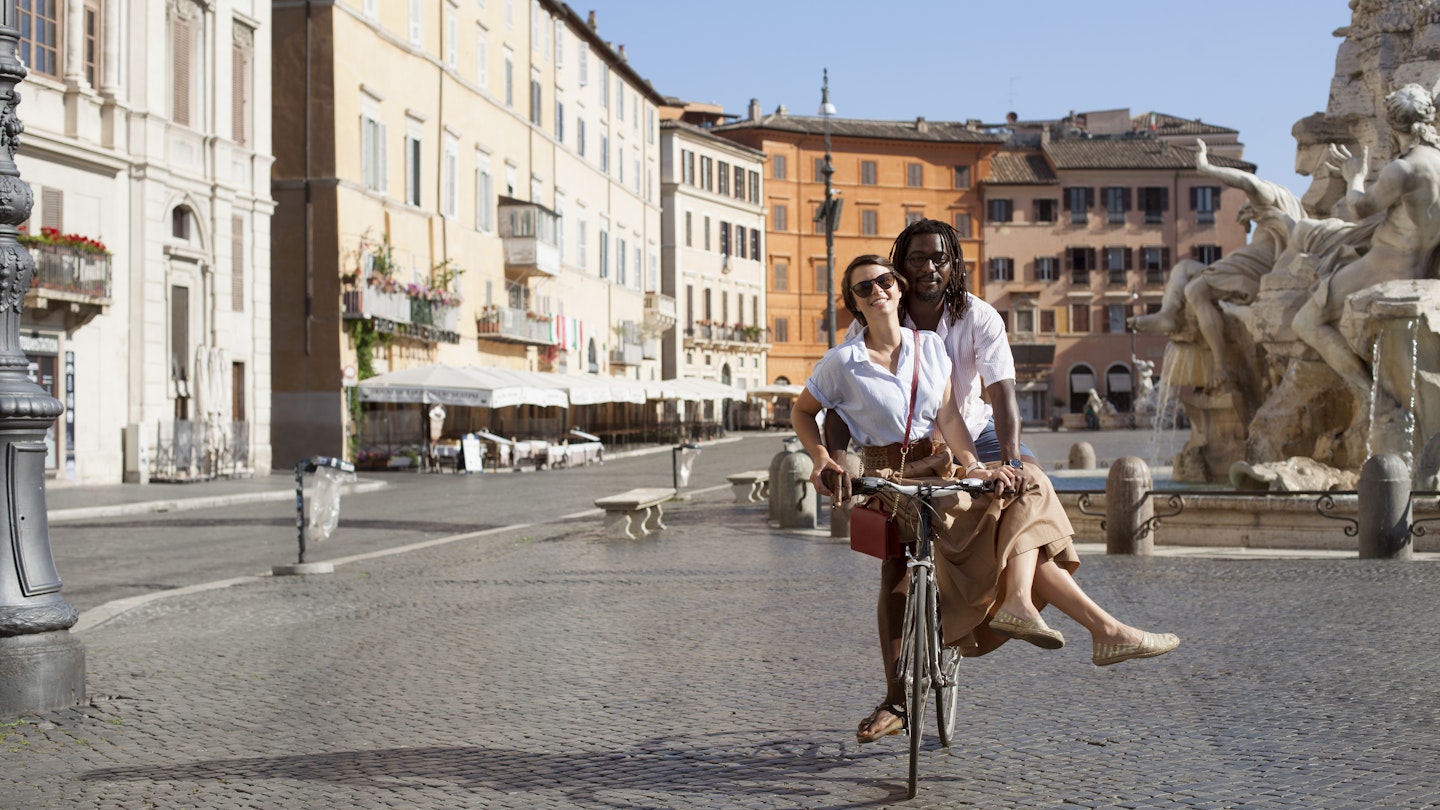
Rome should be the centerpiece of your trip if you’re going to Italy for the first time © Kathrin Ziegler / Getty Images
Home to some of the greatest artworks, historical monuments and food on the planet, and with the kind of varied landscapes that you often have to cross continents to see, Italy elates, inspires and moves its visitors like few other countries.
From its art- and architecture-stuffed cities to its astonishing diversity of natural landscapes – dramatic coastlines, serene lakes, pristine mountains, and those famous rolling hills – picking just a handful of destinations to visit in this wonderful country is no easy task.
So how do you decide where to go? It all depends on what you’re looking for in your Italian odyssey, whether that’s history, art, beaches, hiking or even food. No matter your passion, our list of 15 must-see places in Italy should be your starting point.
Best for history
Once caput mundi (capital of the world), Rome was legendarily spawned by a wolf-suckled boy, developed into a vast empire, rooted itself as the home of the Catholic church, and is now the repository of more than two millennia of art and architecture.
Rome should definitely be the centerpiece of your trip if you’re going to Italy for the first time, but there's simply too much to see in one visit, from the Pantheon and the Colosseum to Michelangelo's Sistine Chapel and countless works by Caravaggio. So do as countless others have done before you: toss a coin into the Trevi Fountain and promise to return.
Planning tip: There’s an overwhelming amount to see here, and with limited public transport in the city center, your choice of hotel can be crucial. Map out the sights you’re most interested in before you book – if you want to be at the Vatican at opening time, for example, don't stay near the Colosseum.
Read more: Italians reveal their under-the-radar vacation spots in Italy
Best for a Renaissance fix
From Botticelli’s Venus , emerging coyly from the water in the Uffizi Gallery , to the mind-boggling dome of its cathedral, Florence is a feast for the eyes. This was, of course, the seat of the Renaissance, and there are knock-out names at every turn – Michelangelo in the Accademia, Donatello in the Bargello, Leonardo and Raphael in the Uffizi.
Further afield in Tuscany – Italy's most romanticized region – is an undulating landscape of sinuous cypress trees, olive groves and coveted regional treasures. Glory in the Gothic majesty of Siena and the Manhattan-esque skyline of medieval San Gimignano before exploring the vineyards of Italy's most famous wine region, Chianti , and the rolling, cypress-studded hills of the Val d’Orcia.
Planning tip: You’re best off without a car if you’re sticking to major towns and cities since Tuscany has a good rail network. But if you want to explore the countryside, you’ll definitely need a car.
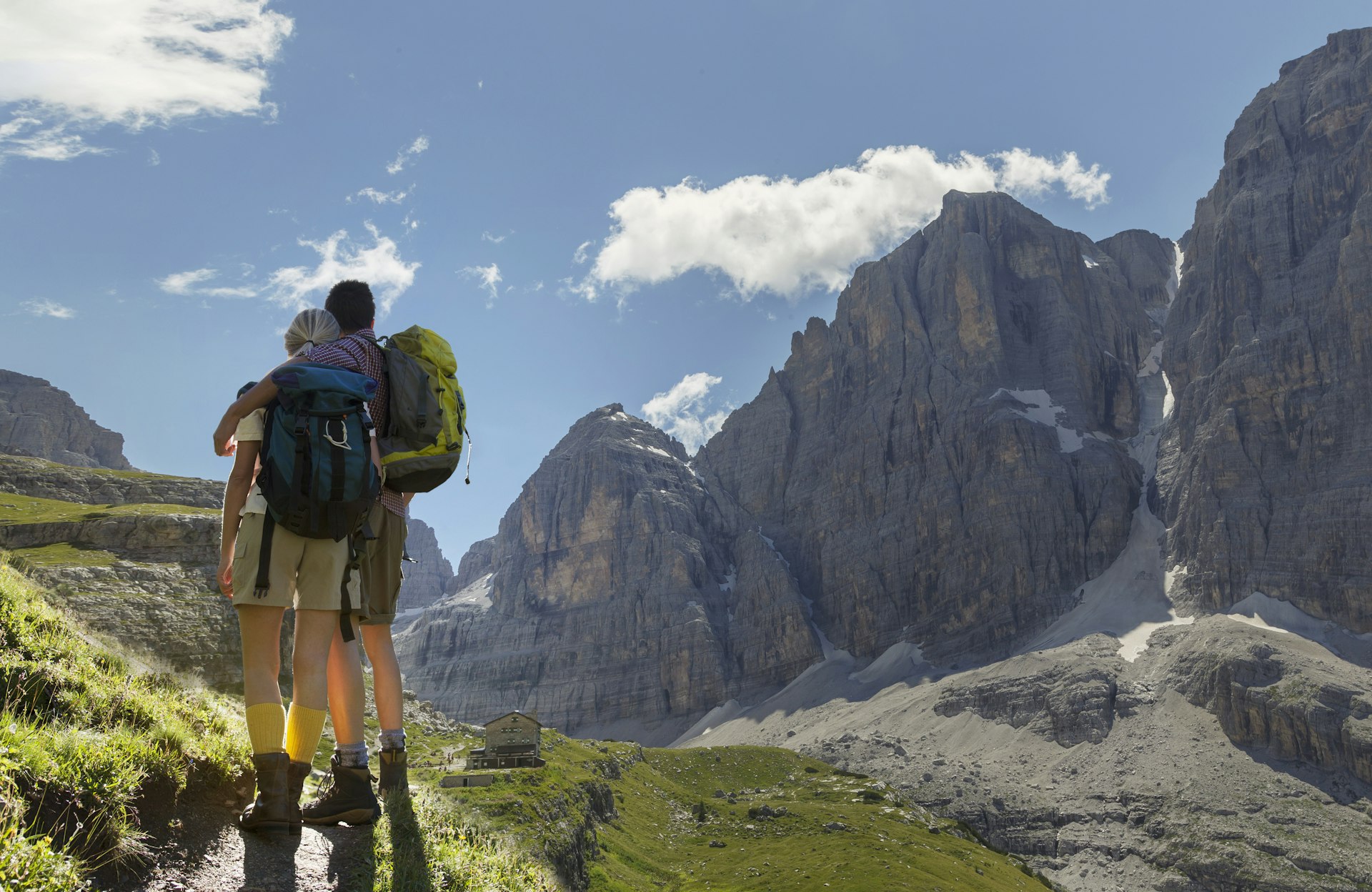
3. The Dolomites
Best for dramatic mountains
Scour the globe, and you'll find plenty of taller, bigger and more geologically volatile mountains, but few can match the romance of the pink-hued granite Dolomites .
Maybe it's their harsh, jagged summits, the vibrant skirts of spring wildflowers, or the rich cache of Ladin legends. Then again, it could just be the magnetic draw of money, style and glamor at Italy's most fabled ski resort, Cortina d'Ampezzo , or the linguistic curiosity of picture-postcard mountain village Sappada . Whatever the reason, this tiny pocket of northern Italy takes seductiveness to dizzying heights.
4. Amalfi Coast
Best for classic beauty
Italy's most celebrated coastline is a gripping strip: coastal mountains plunge into the piercing blue sea in a prime-time vertical scene of precipitous crags, sun-bleached villages and cliffs rearing up behind. Between sea and sky, mountaintop hiking trails deliver Tyrrhenian panoramas fit for a god.
While some may argue that the peninsula's most beautiful coast is Liguria's Cinque Terre or Calabria's Costa Viola, it is the Amalfi Coast that has seduced and inspired countless greats, from Tennessee Williams and DH Lawrence to Elizabeth Taylor, Virginia Woolf and Jackie Kennedy. Of course, its staggeringly romantic looks also make it one of the best places in Italy for couples.
Planning tip: Yes, driving along the Amalfi Coast is one of the world’s most famous road trips, but often it feels like everyone else on the planet has the same idea as you. Traffic can be nose-to-tail, and parking is effectively nonexistent. Instead, take the ferry between towns or travel by public transport .

Best for stepping back in time
Frozen in its death throes, the time-warped ruins of Pompeii hurtle you 2000 years into the past. Wander through chariot-grooved Roman streets, lavishly frescoed villas and bathhouses, food stores and markets, theaters, and even an ancient brothel.
Then, in the eerie stillness, your eye on ominous Mt Vesuvius, ponder Pliny the Younger's terrifying account of the town's final hours: “Darkness came on again, again ashes, thick and heavy. We got up repeatedly to shake these off; otherwise, we would have been buried and crushed by the weight.”
Planning tip: If you have time, the other major city destroyed by the eruption, Herculaneum, is also worth a visit. Much smaller than Pompeii, its buildings are better preserved, and the location – surrounded by its modern descendant, Ercolano – makes the site even more piquant. Like Pompeii, it’s easily reached on the Circumvesuviana train.
6. Emilia-Romagna
Best for foodies
In a region as overwhelmingly foodie as Emilia-Romagna , it's only natural that its capital, Bologna , is dubbed “La Grassa” (the fat one). Many belt-busting Italian classics hail from here, including mortadella, tortellini and tagliatelle al ragù. Shop in the deli-packed Quadrilatero district – home to food stalls since medieval times – then hop on the train for an afternoon in Modena for world-famous aged balsamic vinegar.
Leave room for Parma , hometown of parmigiano reggiano cheese and the incomparable prosciutto di Parma. Wherever you plunge your fork, toast with a glass or three of Emilia-Romagna's renowned Lambrusco – a world away from the sickly sweet wine that was exported in the past.
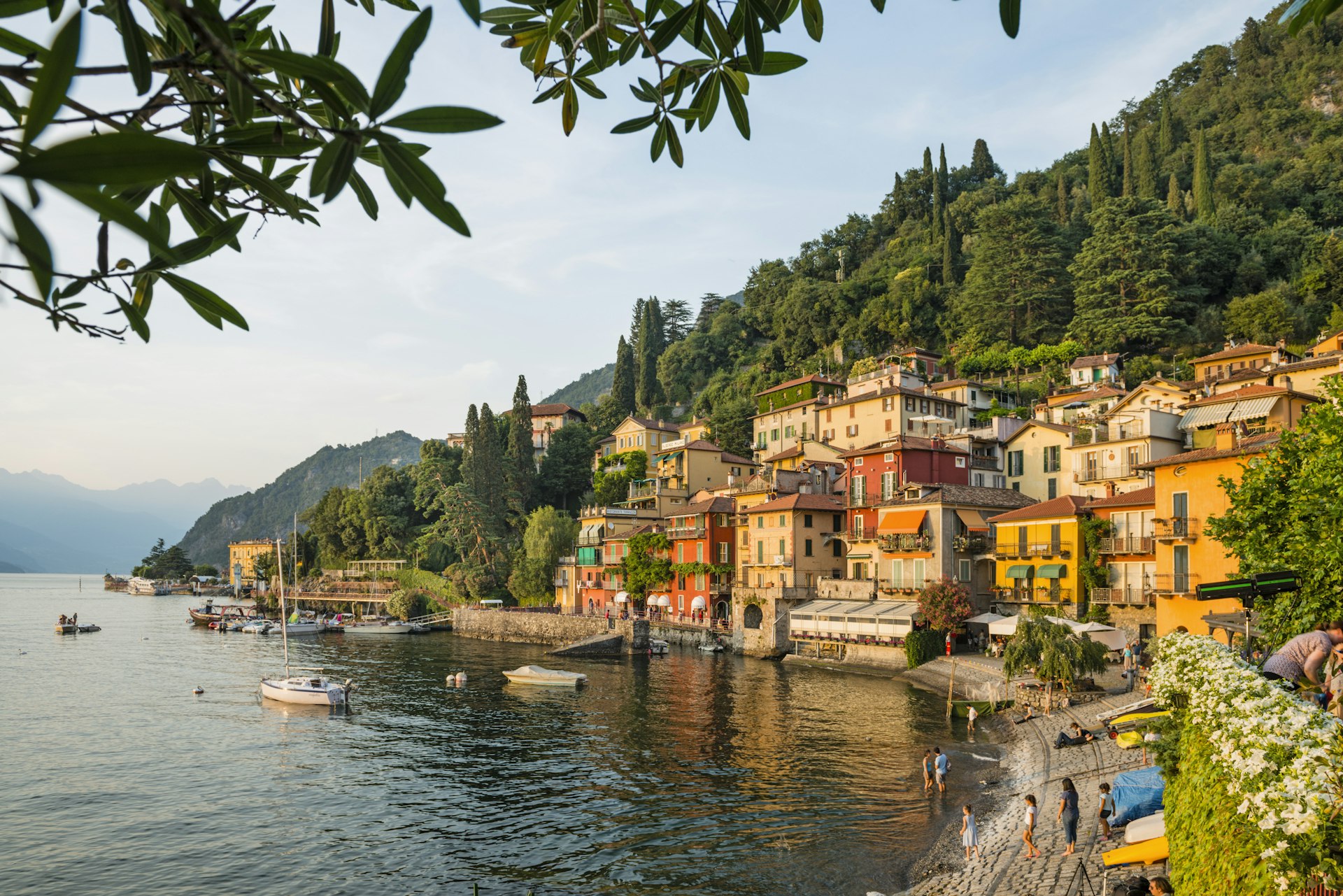
7. Lago di Como
Best for a slice of luxury
If it's good enough for the Clooneys and vacationing Obamas, it's good enough for mere mortals. Nestled in the shadow of the Rhaetian Alps, dazzling Lago di Como is Lombardy's most spectacular lake. Its lavish Liberty-style villas are home to movie moguls, fashion royalty, and literal royalty, while the lake's siren calls include gardens at Villas Melzi d'Eril , Carlotta , and Balbianello that blush pink with camellias, azaleas and rhododendrons in April and May.
The city of Como itself is a hotbed of arresting architecture, from the Gothic cathedral to Palazzo Terragni – built by the Fascists as their party headquarters, it’s a classic example of Italian 1930s Rationalism and a striking reminder of the atrocities committed by the regime.
Planning tip: Como is like the Amalfi Coast – the roads are clogged, and parking is a huge problem. Instead of driving, use public transport; there’s an excellent ferry and bus network, as well as a train line along the eastern edge of the lake.
8. Sardinia
Best for beaches and coastline
The English language cannot accurately describe the varied blue, green and – in the deepest shadows – purple colors of Sardinia’s seas. While models, ministers and perma-tanned celebrities wine, dine and sail along the glossy Costa Smeralda , much of the island – the Med’s second largest after Sicily – remains a wild, raw playground.
Explore its rugged coastal beauty, from the tumbledown boulders of Santa Teresa di Gallura and the wind-chiseled cliff face of the Golfo di Orosei to the windswept beauty of the Costa Verde's dune-backed beaches.
But spend time inland too, and you’ll find some of Europe’s finest prehistoric remains: mysterious nuraghi (megalithic buildings), burial sites so grand they’re known as “giants’ tombs,” and the mountain villages of Barbagia, where locals still practice centuries-old traditions.

Best for sheer italianità
Pompeii, pizza and a whole lot of panache – Naples is a city like no other. Layered like lasagna, each strip of history on top of the last, this is a place where (underground) you can walk along ancient Greek and Roman roads, while at street level there are sumptuous churches, baroque palaces and Maradona – Maradona everywhere .
Outside the city, Vesuvius looms over the time capsules of Pompeii and Herculaneum, while in town, living in the shadow of a volcano gives life a sense of urgency. All that makes for a place like nowhere else .
Planning tip: Naples becomes less chaotic from the water. Taking the ferry isn’t only an option if you’re going to islands like Ischia and Procida – you can also take a boat from the city to Sorrento , Positano and the Amalfi Coast.
Best for a fairytale city
“Unique” is an overused word, but in the case of Venice , there’s no better description. This really is a dreamscape of intricately carved palazzos, gilded churches and world-class museums, all floating on water and crisscrossed by quiet canals.
Avoid the temptation to do a quick drop-in visit to see the main sights – the real Venice is in the silent canals and narrow alleyways, which cast a spell on all who move through them. Tick off the Rialto Bridge and Piazza San Marco , but then stay on to experience this most precious, and precarious, of cities.
Local tip: This is not the place to run a tight schedule. Leave time to wander the alleys , look inside the churches and artisan shops you pass, and hop on a vaporetto that’ll chug through the islands of the lagoon.

11. Parco Nazionale del Gran Paradiso
Best for hiking
If you're pining for a mind-clearing retreat, lace up your hiking boots and explore over 500km (310 miles) of marked trails and mule tracks traversing “Grand Paradise.”
Part of the Graian Alps and one of Italy's very first national parks, Gran Paradiso's pure, pristine spread encompasses 57 glaciers and alpine pastures awash with wild pansies, gentians and alpenroses, not to mention a healthy population of Alpine ibex, for whose protection the park was originally established. At 4061m (13,323ft), the eponymous Gran Paradiso is the park's only peak, accessed from tranquil Cogne.
12. Mount Etna
Best for thrill seekers
Known to the Greeks as the “column that holds up the sky,” Mt Etna is not only Europe's largest volcano, it's one of the world's most active. The ancients believed the giant Tifone (Typhoon) lived in its crater and lit the sky with spectacular pyrotechnics; today they simply call it idda , or “her.”
At 3326m (10,912ft), she literally towers above Sicily's Ionian Coast . Tackle the climb on foot, on a guided 4WD tour, or stick to the lower slopes, where you’ll find some of Italy’s most exciting wines being grown in the uber-fertile volcanic soil. Sicily is one of the nicest places in Italy to visit, thanks to its extraordinary wealth of history and architecture, its jaw-dropping coastline and, of course, the ever-welcoming Sicilians.
13. Cinque Terre and the Liguria coast
Best for classic coastline
Liguria’s remote Cinque Terre area is coastal Italy at its most spectacular. Five seaside villages wedged between cliffs, encircled by a national park and connected by clifftop footpaths, this is a place where humanity has lived in symbiosis with nature for thousands of years. People have chiseled terraces into the steep cliffs and grown wine here since Roman times; until the 20th century, the locals got about by sea or footpath.
The villages themselves are gorgeous, but spare some time for a hike along the Sentiero Azzurro, the most popular of the paths connecting them. Cinque Terre may be the best known, but Liguria’s coastline is one showstopper coastal village after another – additional highlights include Portofino , Portovenere and Santa Margherita Ligure .
Planning tip: This is another area where it’s not worth driving – there are ferry services, but our favorite option is the train, which runs along the coast and stops at each of the villages.

14. Valle d’Itria
Best for picture-perfect villages
They look like hobbit houses – small conical-roofed cottages, often stitched together to form a bigger home but always fairytale pretty, whatever the size. Puglia, the heel of Italy’s boot, is famous for its trulli, but you won’t find them all over the region.
Head south of Bari, in from the coast and up onto the high karst plateau, and you’ll find the Valle d’Itria , where the green fields around towns like Cisternino and Locorotondo are dotted with trulli. Alberobello is the center of it all – the centro storico of the town is nothing but streets of them. This is one of the prettiest parts of Italy – truly.
Best for a real city break
Italy’s fashion capital often gets a bad rap – too international, too organized, not chaotic enough. Don’t believe it. Where else can you go from a Gothic-style cathedral, started in the 14th century, to masterpieces by Leonardo (his Last Supper fresco in the church of Santa Maria delle Grazie is a showstopper, but so is the Sala delle Asse in the Castello Sforzesco , which he painted as a trompe l’oeil forest bower)?
Milan's restaurants pull together the best food from the Italian peninsula, it’s home to one of Italy’s rare cocktail scenes, and its fashion houses are transforming the city’s modern art scene with venues like Fondazione Prada , an old distillery now housing works by the likes of Jeff Koons and Damien Hirst, as well as putting on top-notch temporary exhibitions.
Planning tip: Milan doesn’t really have high and low seasons like the rest of Italy does; instead, its hotel rates rocket up and down depending on whether there’s a major event in town. Avoid Design and Fashion Weeks if you're traveling on a budget .
This article was first published Jun 3, 2021 and updated Nov 19, 2023.
Explore related stories
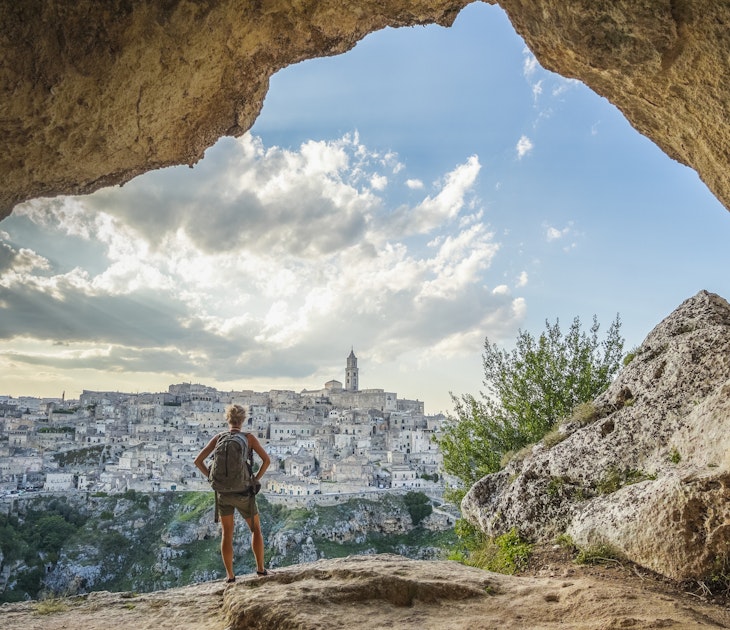
Tips & Advice
May 4, 2024 • 4 min read
You're finally taking that trip to Italy! But now the panic over what to pack starts. Don't worry, I've got all the tips and tricks you need.

Apr 27, 2024 • 5 min read

Apr 25, 2024 • 6 min read
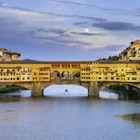
Apr 21, 2024 • 7 min read

Apr 19, 2024 • 10 min read

Apr 17, 2024 • 6 min read

Apr 15, 2024 • 10 min read
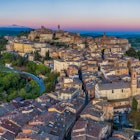
Apr 7, 2024 • 11 min read

Apr 5, 2024 • 5 min read
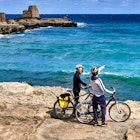
Mar 30, 2024 • 4 min read
- Skip to primary navigation
- Skip to main content
- Skip to primary sidebar

Destinations.ai
We make it easy to find the perfect travel destination
33 Top Tourist Attractions in Italy to Add to Your Bucket List
Author: Destinations.ai · Updated on: May 6, 2024
Italy’s distinction as the world’s cultural epicenter can’t be overstated. This nation holds the accolade for the highest concentration of UNESCO World Heritage Sites globally, a testament to its historical and artistic wealth. Renowned cities such as Rome, Venice, and Florence resonate with centuries of heritage, their artistic and architectural wonders drawing admirers from every corner of the globe to these amazing tourist attractions in Italy.
Equally enchanting is Italy’s natural beauty—from the sun-kissed coasts to serene alpine lakes and majestic mountains. Unsurprisingly, Italy is affectionately known as ‘Bel Paese,’ which translates to ‘beautiful country.’
It’s a place where the splendor of nature and the richness of culture blend seamlessly, creating a tapestry of experiences that attract more than 40 million foreign tourists annually.
1. Trulli of Alberobello
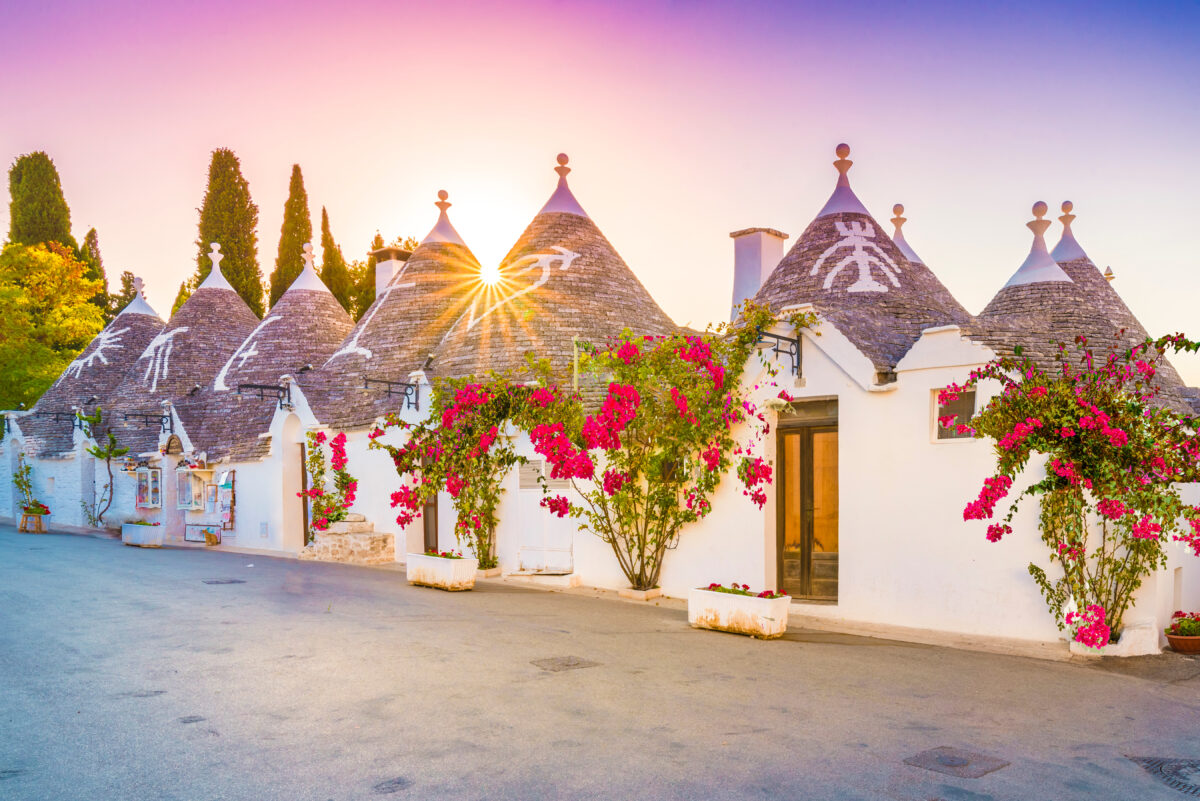
When you stroll through the enchanting town of Alberobello in Italy’s Puglia region, your eyes will be captivated by the whimsical sight of the Trulli houses.
These stone dwellings, distinct with their pointed roofs, evoke a sense of walking through a storybook village—a testament to 14th-century ingenuity. Constructed skillfully from local stone, these icons are assembled meticulously, layer upon layer, eschewing mortar for a pure, dry-stone technique.
- Construction : 14th-century dry-stone
- Location : Alberobello, Puglia, Italy
- Unique Feature : Conical roofs made from flat stones
Designated in 1996 by UNESCO as a testament to human creativity, the Trulli preserves history and hosts a vibrant community. Their current reincarnation sees them as cozy holiday homes, boutique stores, and eateries, immersing you in this celebrated aspect of Apulian heritage.
See Related : 27 Top Tourist Attractions in Germany
2. Island of Procida
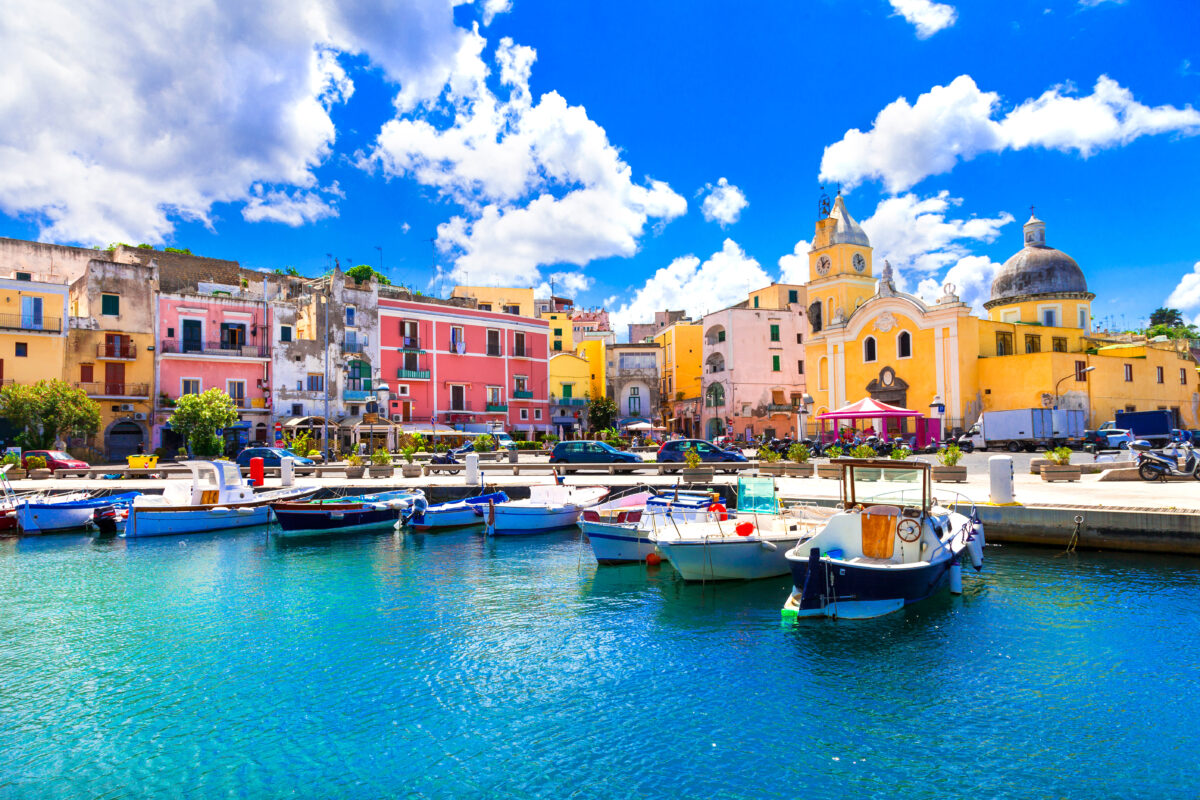
Nestled within the Bay of Naples, Procida greets you with a symphony of colored facades and a tranquil ambiance that starkly contrasts the bustling shores of the Amalfi Coast. As you wander through the charming streets lined with fishing villages, you’re greeted by a vibrancy that extends beyond the visual spectacle—an invitation to partake in a culinary journey, where each seafood dish tells a story of the Mediterranean’s bounty.
Highlights:
- Visit Terra Murata, an architectural marvel steeped in history.
- Partake in authentic local festivals—Festa di Sant’Antonio Abate and Festa di Santa Maria delle Grazie.
- Enjoy the calm atmosphere away from the usual tourist paths.
To reach this serene escapade, board a ferry from Naples, Ischia, or the Amalfi Coast and prepare to immerse yourself in the simplicity and beauty of island life, a rich tapestry woven with tradition and local lore.
See Related: 25 Top Tourist Attractions in Vietnam
3. Ponte Vecchio in Florence

Steeped in tales of commerce and survival, your journey through Florence would be incomplete without a stroll across the storied Ponte Vecchio. This enduring medieval structure forges a path over the Arno River, beckoning with its picturesque presence and the allure of glittering gold jewelry from the shop fronts that line its walkway.
Key Highlights:
- Known as the oldest bridge in Florence, dating back to at least the 13th century.
- Famous for its continuous line of shops, historically decreed by the Medici to be goldsmiths and jewelers.
- A living monument to Florence’s perseverance and its survival during WW2 made it a symbol of the city’s unyielding spirit.
As you traverse the bridge, you’re walking in the footsteps of ages. The chatter of excited sightseers and the melody of the Arno’s flow amplify the vibrant atmosphere. Despite the bustle, there lingers an unspoken reverence for the bridge’s storied past, a silent respect for its legacy of resilience.
See Related: 22 Top Tourist Attractions in Miami
4. Verona’s Ancient Amphitheater

In the heart of Verona, a city clasped in the embrace of the Adige River and immortalized by Shakespeare’s star-crossed lovers, stands a monumental testament to Roman architectural mastery—the Verona Arena. Remarkably enduring through the centuries, this colossal structure has passed two millennia since its creation.
Originally built to regale over 30,000 onlookers, the amphitheater still captures audiences’ imaginations worldwide, serving as one of the globe’s premier open-air opera venues. Imagine the echoing arias and powerful orchestras beneath the stars as Verona’s ancient stones come alive to the sound of timeless operatic masterpieces like “Aida” and “La Traviata.”
Visitor Highlights:
- Performances: Engage in the grandeur of live opera in a setting unchanged by time.
- Ambiance: Stroll among nearby eateries and boutiques after an evening performance.
Your cultural journey continues amidst Verona’s modern vibrancy and rich historical tapestry, where every step near the arena is a dance through past and present.
See Related: 25 Top Tourist Attractions in San Diego
5. Herculaneum

In the shadows of Mount Vesuvius lies a forgotten Roman city, Herculaneum, swept away by the same fateful eruption that overtook Pompeii. Unlike its larger neighbor, this hidden gem slumbered under a dense cover of ash and stone, emerging with an astonishing degree of preservation that offers a striking window into antiquity.
Fascinating Sites at Herculaneum:
- Ancient Dwellings: Explore residences that once echoed with the footsteps of Roman life, adorned with vibrant frescoes that speak of their resilience against time.
- The Baths: Visit the communal baths, marvels of Roman engineering, a testament to ancient societies’ ingenuity.
- Theatre Remains: Stand before the theatre, envisioning performances that captivated audiences under the Mediterranean sky.
Preservation Insights:
- Concrete and Waterproofing: Herculaneum unveils pioneering Roman construction, from sturdy concrete to early waterproofing methods.
- Incredible Condition: With a more intimate scale than Pompeii, the city’s alleyways and structures reveal details oft missed in grander ruins.
During your journey, you’ll tread along original streets and pass by shops that once buzzed with commerce, each corner narrating a story etched in the volcanic remnants. Your visit isn’t merely a tour; it’s a passage through time, where every sense is engaged, and the past’s heartbeat is felt beneath your feet.
See Related: 26 Top Tourist Attractions in Greece

As you set foot on the shores of Elba, you find yourself tracing the steps where ancient civilizations, from the Ligures Ilvates to the Romans, once roamed. This Tuscan gem, embraced by the Tyrrhenian Sea, is more than just its sprawling beaches with shimmering, transparent waves – it is a haven steeped in a rich tapestry of history.
- Historical Residences : Wander through the historical abodes of Napoleon, Elba’s most eminent temporary resident. These preserved houses, once serving as his winter and summer quarters, now invite you to glimpse into his life during exile.
- Accessibility : Reach this island sanctuary, the largest of the Tuscan Archipelago, with a simple, scenic ferry ride.
- Natural Splendor : Surround yourself with a landscape dotted with lush vineyards, ancient olive groves, and rolling hills that paint the vibrant backdrop of Elba.
- Medieval Towns & Fortifications : Take time to meander through the medieval towns and explore the enduring fortifications, each telling stories of bygone eras.
- Adventurous Undertakings : For your active spirit, Elba offers an array of outdoor pursuits. Hike the trails, cycle the paths, or dive into water sports.
- Culinary Journey : Indulge in the local gastronomy, where fresh seafood pairs exquisitely with homegrown olive oil – a true delight for your palate.
Your journey through Italy’s marvels is enriched by every authentic experience Elba offers, echoing the allure of a land where history and modern relaxation converge seamlessly.
See Related: 25 Top Tourist Attractions in Boston
7. Gran Paradiso National Park

Located in the heart of the Graian Alps, Gran Paradiso National Park serves as a sanctuary for the majestic ibex and many other wildlife, from the elusive lynx to over a hundred avian species that soar through its skies. Access to this alpine haven is a mere drive from neighboring towns, making its natural splendor readily available for exploration.
- Peak Ascent : The park’s crowning glory, Gran Paradiso Peak, stands as the tallest mountain solely within Italy’s borders, offering climbers breathtaking panoramas.
- Summer unveils perfect trails for hiking.
- Autumn swathes the landscape in vibrant hues.
- Winter opens up lanes for cross-country skiing.
- Spring dots the terrain with vibrant flowers.
As you traverse the park, the tapestry of nature unfolds before you, where each path leads you to scenic vistas and a deeper connection with the land’s living heritage.
See Related: 27 Top Tourist Attractions in New York City
8. Palazzo Ducale in Urbino

When you stroll the cobbled streets of Urbino, a gem in the crown of Italy’s Marche region, you are drawn to the Palazzo Ducale , a testament to the Renaissance’s architectural grandeur. Dreamt up by Luciano Laurana, the palace whispers tales of its past when dukes roamed its corridors. As you enter, allow the central courtyard—quite the marvel with its harmony of light and shadow—to transport you to a bygone era.
- Architectural Splendor: Gaze upon the impressive staircase, balconies, and loggias as you wander.
- Artistic Legacy: Embrace the artistry of myriad maestros—Piero della Francesca and the celebrated Raphael once graced these halls.
Currently serving as a museum, the palace invites your curiosity, extending an ongoing exhibition of Renaissance marvels. Visualize Raphael sketching within these walls, gifting the world with creations now immortal. Here, you become part of the living tapestry, walking amidst history’s embrace.
9. Trevi Fountain in Rome

Stepping through the bustling streets of Rome, you find yourself in the presence of the majestic Trevi Fountain. Completed in 1762 by Nicola Salvi, it captures Neptune’s grandeur amidst a tumult of ocean denizens, carved with exquisite detail. The tradition here is more than just a spectacle:
- Toss one coin: Secure another Roman holiday.
- Toss two coins: Stir the waters of romance.
At night, this baroque masterpiece is a beacon, its stone figures dancing in the play of light. It’s a favored spot for evening promenades and whispered proposals. Close to the heart of Rome, let the Trevi Fountain enchant you under the cloak of darkness and perhaps, start a love story of your own.
- Evening visits are highly recommended for the illumination.
- Respect local customs and the environment when partaking in coin-throwing.
10. Santa Maria delle Grazie in Milan
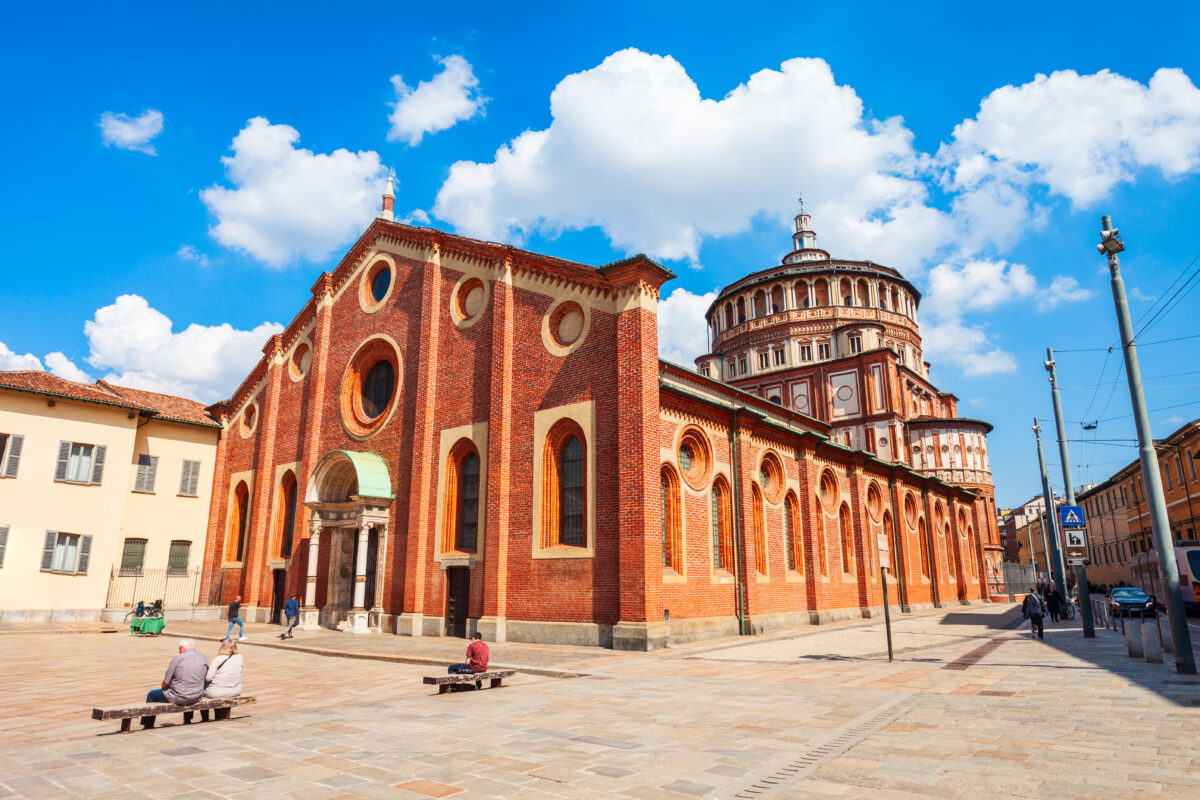
Nestled in the heart of Milan, the Santa Maria delle Grazie stands as a monument to Renaissance beauty and religious history. Constructed in the 15th century, this church and Dominican convent capture the imagination with its elegantly designed structure and the sacred art it houses.
At the core of this awe-inspiring venue, ensconced within a refectory, lies Leonardo da Vinci’s The Last Supper . This iconic mural artfully freezes the poignant moment of Jesus announcing his forthcoming betrayal to his disciples. As a site that draws countless visitors each year, the revered painting stands among the most influential and meticulously examined artworks globally.
Santa Maria delle Grazie has been honored as a UNESCO World Heritage Site, offering a tranquil haven for reflection and exploration beyond the masterpiece it safeguards. For an optimum visit, consider arriving early or just before closing time to quietly enjoy the serenity and splendor unfettered by the day’s usual throngs.
Opening Hours :
- Morning : 7:00 AM – 12:00 PM
- Afternoon : 3:00 PM – 7:15 PM
- Arrival : Early morning or late afternoon for a more personal experience.
- Stay : Recommendations available for cozy accommodations in Milan’s vicinity.
Discover the enchanting ambiance and captivating history that envelop Santa Maria delle Grazie on your journey through Milan’s cultural heritage.
11. La Pelosa
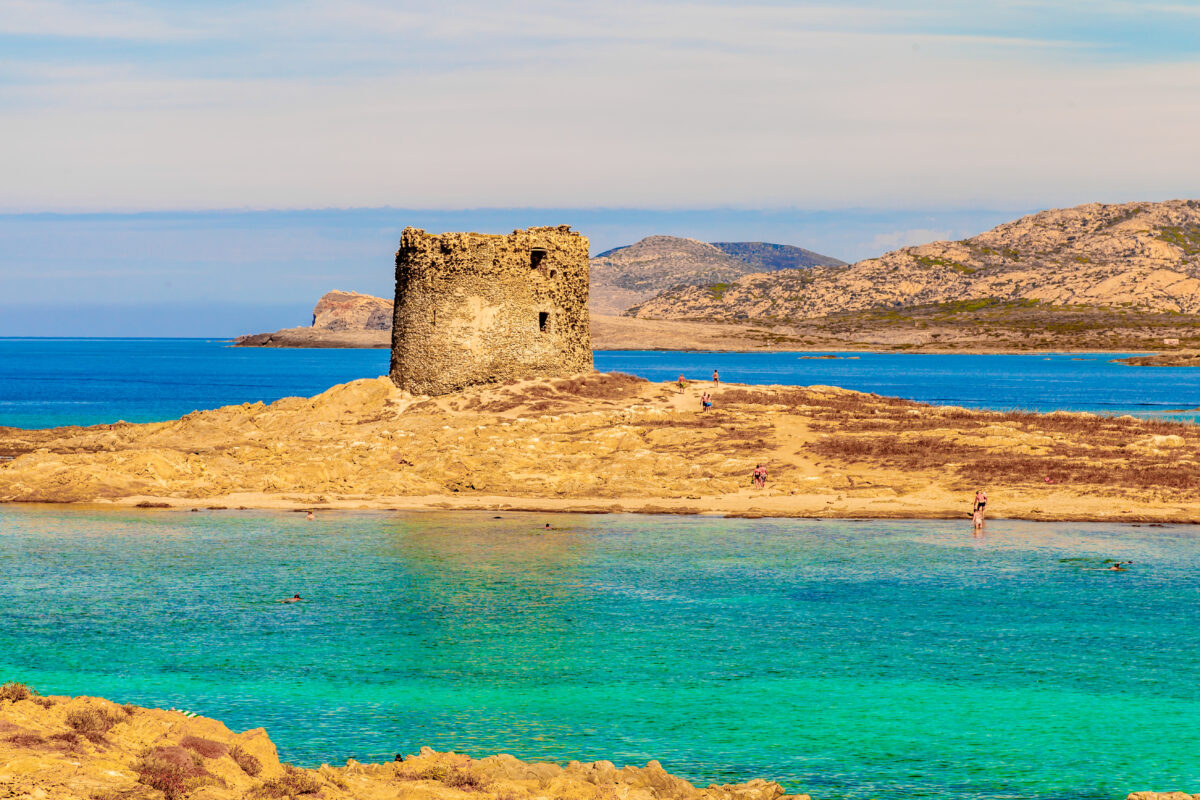
This Sardinian gem, La Pelosa, invites you with its tender sands and translucent, shallow waters where one can gaze upon the seabed’s mysteries. Often likened to the Caribbean’s allure, it imports a touch of the tropics to the Italian shoreline. Here, you can engage in wave-riding, paddle through serenity in a kayak, or delve beneath the sea’s skin—each activity framing La Pelosa as not merely a beach, but a multifaceted adventure.
See Related: Most Romantic Getaways in the World: Destinations for Couples
12. Ravenna’s Mosaic Marvel: The Basilica of San Vitale

Constructed in the 6th century, Ravenna’s Basilica of San Vitale stands as a testimony to the splendor of Byzantine artistry. As you step inside, your gaze is inevitably drawn upwards to the intricate mosaics that cloak the dome, walls, and floors, depicting Biblical narratives with stunning clarity and color.
Highlights of the Basilica:
- Circular Design: Distinct amongst early Christian churches with its central dome.
- Mosaic Art: Vibrant scenes enliven the interiors, illustrating stories from scripture.
- Architectural Grandeur: The dome soars, a centerpiece of the interior’s magnificence.
Declared a UNESCO World Heritage Site, this monument affords you a glimpse into early Christian and Byzantine brilliance. To truly grasp its nuances, consider engaging with a guided tour, enriching your visit with insights into its storied past.
13. Dolomites

Nestled in the northern Italian Alps, the Dolomites boast a unique skyline, with dolomite rock forming sharp, rose-hued peaks. Your adventure spirit will be stoked here, with a plethora of activities like:
- Trekking: Traverse lush trails.
- Climbing: Scale natural rock formations.
- Cycling: Pedal along scenic routes.
- Winter Sports: Ski on powdery slopes or board across fresh snow.
Beyond the thrill of outdoor sports, you’re enveloped by serene alpine vistas, from verdant valleys to translucent lakes. In every direction, a postcard-worthy scenery unravels.
Charismatic villages dot the landscape. In places like Castelrotto, Cortina d’Ampezzo, and Selva Val Gardena, you’ll immerse in Italy’s alpine heritage, encountering timeless traditions and local warmth.
14. An Ode to Saint Francis: The Two-Tiered Marvel of Assisi

Nestled in the heart of Umbria, your pilgrimage to the Basilica di San Francesco beckons with a harmony of contrasts. Here, the austerity of Saint Francis aligns with the grandeur of a sanctuary that serves as a canvas to Renaissance masterminds.
Upper Church:
- Frescoes : A visual feast where biblical tales and slices of Saint Francis’ life are captured by the brushes of Giotto, Simone Martini, and Pietro Lorenzetti.
Lower Church:
- Architecture : You’ll find profound peace in the understated elegance that grounds the spiritual atmosphere.
Below, the hallowed crypt houses the Saint’s earthly remains, inviting contemplation. As you wander through this dual-layered historical jewel, the interplay of solemnity and artistic exuberance crafts a narrative befitting a saint known for his love of the smallest of creatures and the grandest of ideals.
15. Sassi di Matera

Journey through Matera’s heart and discover the Sassi di Matera, a labyrinth of ancient cave abodes etched directly into limestone. These structures are not only an architectonic wonder but are also considered to be among Italy’s earliest settlements, dating back an estimated 9,000 years.
- Residential Caves : Today, many are still used as homes and shops.
- Business in the Rocks : Cafes and businesses thrive within these ancient walls.
- Walking Tours : Experience the blend of past and present as you explore.
- Local Wines : End your exploration in a cave bar, savoring regional wines.
These dwellings offer a rare opportunity to walk the same paths as the earliest Italians, with modern comforts interspersed.
16. Mount Etna

Rising above the eastern shores of Sicily, Mount Etna beckons intrepid explorers to its dramatic slopes. As Europe’s most vibrant volcano, it stages numerous eruptions throughout the year, each a testament to nature’s fiery vigor.
- Elevation: Approximately 3,329 meters
- Location: Parco dell’Etna, Sicily
Embarking on a journey here offers a fusion of adventure and academic lure. Etna is not merely a mountain; it’s an open-air classroom where the Earth divulges its volcanic secrets, offering valuable insights into our planet’s geological artistry.
Your path winds through a landscape dotted with deep craters, ancient lava flows, and plumes of steam that testify to the mountain’s restless soul. Stride through verdant forests and across weathered terrain where the fruits of volcanic soil – notably, sumptuous grapes – tempt the palate with their robust flavors. Here, the wines are as rich as the scenery, each sips a homage to Etna’s generous yet unpredictable nature.
As you stand amidst Etna’s craggy domain, gazing out over the expansive Sicilian panoramas, you find yourself amidst one of Italy’s most spectral displays of earthly power.
17. The Cathedral of Orvieto

Nestled in the heart of Umbria, the Cathedral of Orvieto stands as a testament to the grandeur of Italian Gothic architecture. Consecrated to the Assumption of the Virgin Mary, construction of this monumental edifice began in the 13th century. As you approach, the façade captivates with a display of biblical tableaus and sculpted figures that come to life in the stone—an enthralling chronicle of sanctity and lore.
Upon entry, the interior reveals its own splendors. Here, masterful frescoes painted by Luca Signorelli narrate apocalyptic visions and profound revelations with striking vitality. These artworks not only embody the religious fervor of the period but also stand as a tribute to the cathedral’s pivotal role in the cultural tapestry of Orvieto. As you wander the aisles, the sheer dedication it took to create this masterpiece over centuries is palpable in every intricate detail.
18. Pizza Napoletana

In the heart of Naples, the original pizza thrives with tradition and taste that’s unparalleled. Here, Neapolitan pizza showcases a delicate balance, with a thin crust and a generous layer of sauce, each pie an art form meant to be savored in one sitting.
Those in search of authenticity will find pizzerias brandishing the “Vera Pizza Napoletana” seal—a badge of honor signifying adherence to the precise artistry dictated by The Naples Pizza Association.
In Naples, pizza isn’t just a meal; it’s a cultural heritage, one that commands respect and offers an insight into the city’s soul.
19. Portofino

Nestled along the Italian Riviera, within a short journey from Genoa, lies the enchanting village of Portofino. Its harbor, a vibrant canvas of aquamarine waters, sets the backdrop for terraced homes in a symphony of rich colors. Here, the passage of time is marked not by the ticking clock but by the gentle ebb and flow of the sea.
- Historic Sites: Explore the well-preserved Castello Brown from the 16th century and reflect on maritime sagas at the St. Martin Church dating back to the 11th century.
- Leisurely Walks: Embrace the laid-back atmosphere with a leisurely stroll along the Ligurian coast, an immersion in pure serenity.
- Local Shopping: Hunt for handcrafted glass jewelry, embodying the soul of Portofino in each delicate piece.
- Culinary Delights: Relish the Italian fare, where each meal is artfully accompanied by the region’s crisp Pinot Grigios.
In the heart of Portofino, life’s simple pleasures become your compass to la dolce vita.
20. The Majesty of Venice’s Saint Mark’s Basilica

As you wander the iconic Piazza San Marco, the heart of Venice unfolds, anchored by the remarkable Saint Mark’s Basilica. Built in the 11th century, its architectural grandeur is adorned with over 500 pillars and crowned by magnificent domes.
- Features : Over 500 columns, several domes, extensive gold mosaics
- Historical Artifacts : Bronze Horses of Saint Mark dating from antiquity
- Not-to-Miss : Treasury and Museo Marciano with their collection of precious objects
Indulge in the basilica’s gleaming gold mosaics, a testament to Byzantine influence. Witness the storied Bronze Horses surveilling from above, silent guardians through the ages. The treasury, a trove of opulent gifts, and the Museo Marciano, housing timeless jewels, sculptures, and tapestries, await your exploration. Make sure not to bypass these troves, rich with historical and cultural significance.

Nestled in the Tyrrhenian Sea, Capri bewitches visitors with its dramatic cliffs and sapphire waters. Your steps might lead you through the legendary Blue Grotto, where sunlight dances on the cavern walls, painting everything with a surreal azure glow.
In the heart of Capri, Piazzetta awaits with its cozy cafés where you might savor a rich espresso and partake in the refined art of people-watching. The echoes of history resonate at the Villa Jovis, once the domain of Emperor Tiberius, perched on a cliff with commanding views of the sea.
Embrace Capri’s opulent side with its array of high-end boutiques and restaurants, or seek out the island’s rugged beauty with a swim in the clear sea. Capri’s winding trails entice adventurers eager to discover secluded spots offering peace and panoramic vistas.
- Attractions : Villa Jovis, Blue Grotto, Piazzetta
- Activities : Boating, Hiking, Swimming
- Vibe : Luxurious, Historic, Picturesque
See Related: Best Places to Visit in the World
22. St. Peter’s Basilica in Rome
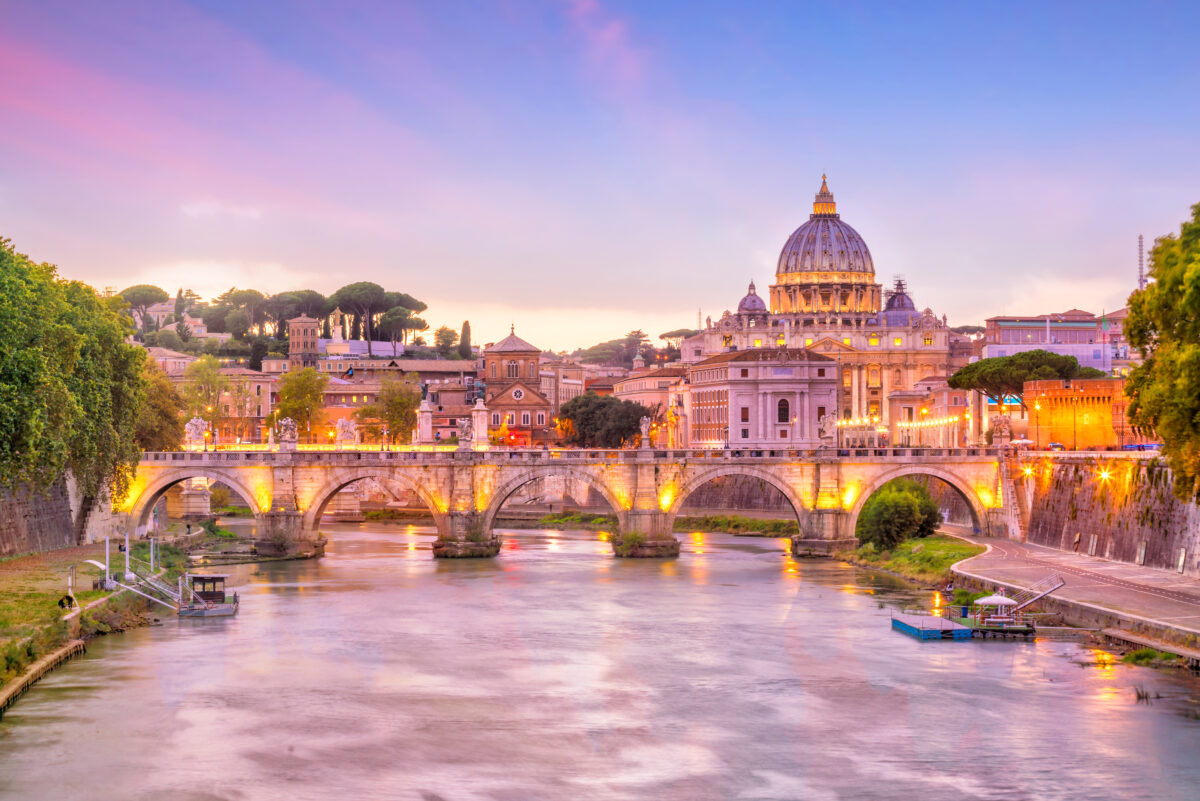
Nestled in the heart of Vatican City, this iconic basilica stands as a monumental tribute to faith and artistry. Dedicated to St. Peter, one of Jesus’s closest followers, it is believed that his final resting place lies beneath the grand altar.
Size and Structure:
- Completed in 1626 after 120+ years of labor
- Capable of accommodating a space shuttle with booster rockets
Architectural Splendor:
- Harmonizes Renaissance and Baroque styles
- Boasts a dome shaped by the visions of Bramante, Michelangelo, and Bernini
Artistic Offerings:
- Home to Michelangelo’s sculptures, one being the poignant ‘Pietà’
- The central dome itself, is an artwork that draws eyes heavenward
Whether attending mass or simply basking in the art, this basilica rewards visitors with an ambiance of awe. It’s not merely a church, but a canvas displaying humanity’s devotion to beauty and the divine.
23. Valley of the Temples

Journey into the heart of Sicily and encounter the sublime Valley of the Temples , a testament to ancient magnificence. Here, you’re surrounded by the echoes of the 5th century BC, as you wander amongst the Doric pillars that pierce the sky like timeless sentinels.
- Temple of Hera : Once dedicated to the Greek goddess of marriage and birth, offering picturesque ruins that invite contemplation.
- Temple of Concordia : One of the best-preserved temples, standing as a grand symbol of enduring beauty and architectural might.
- Temple of Heracles : Celebrating the mythic hero’s strength, its remnants inspire awe with their formidable history.
Your exploration grants panoramic vistas that blend the ancient silhouettes with Sicily’s natural splendor. Recognized by UNESCO for its pivotal reflection of Greek art and construction, this landmark is more than history—it’s a narrative woven into the very fabric of Sicilian heritage.
24. San Gimignano

Nestled in the rolling Tuscan hills, San Gimignano stands as a testament to medieval prosperity, with its skyline punctuated by 14 surviving towers. These stone sentinels, once numbering over 70, served as both fortresses and emblems of affluent family legacies.
- Medieval Architecture : Visit the town’s historical center where the architecture encapsulates its storied past.
- Towers : While exploring, observe the impressive towers that symbolize San Gimignano’s former might.
- Vernaccia di San Gimignano : Indulge in the locale’s signature white wine, a product of the region’s rich vinicultural tradition.
- Events : Partake in the spirited festivals that animate the town throughout the year, reflecting its communal heartbeat.
Travel from Florence or Siena brings you into the embrace of a community where celebrations are as timeless as the towers themselves. Experience San Gimignano, where history breathes through the cobblestones under your feet.
25. Manarola
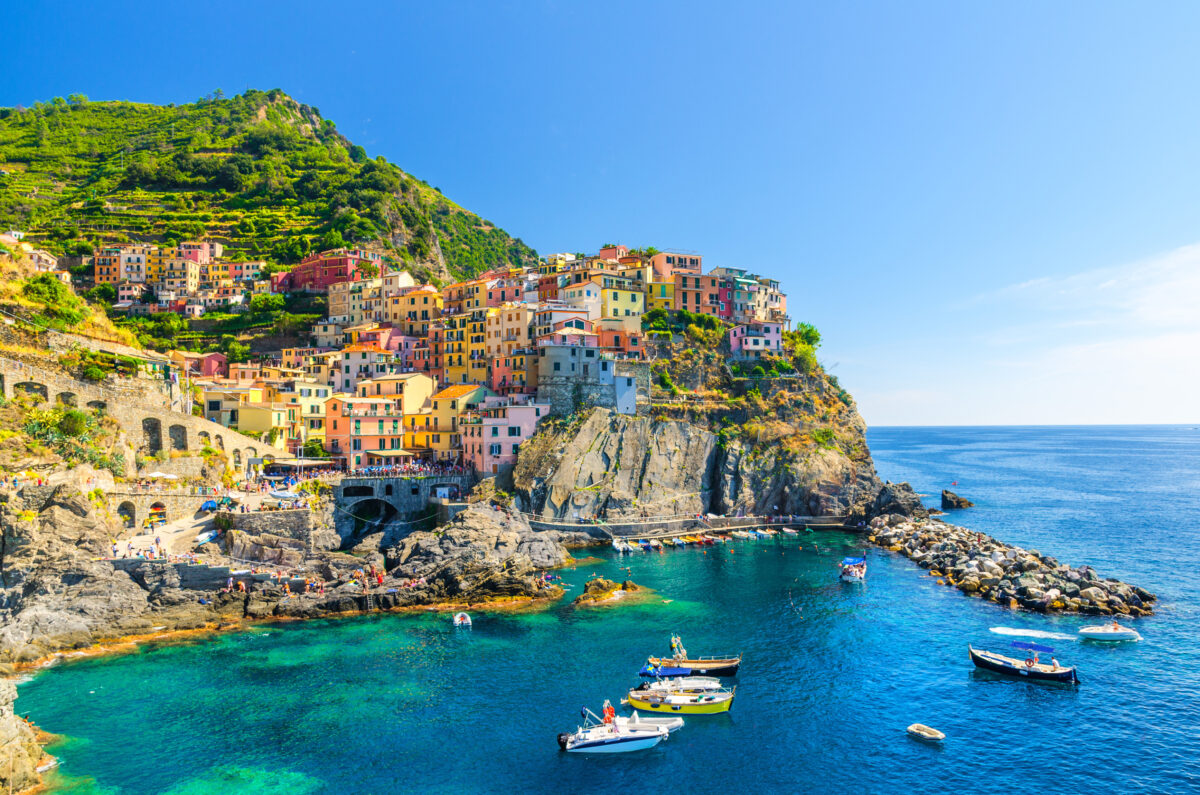
Manarola, nestled in the heart of La Spezia’s rugged coastlines, blooms with an array of pastel houses that seem to ascend from the Ligurian Sea. Renowned for its splendiferous panorama, this hamlet captivates shutterbugs and artists alike.
- Photographic Haven : Capture the vibrant architecture against the backdrop of steep cliffs.
- Culinary Delights : Indulge in local specialties at charming eateries.
- Hiking Escapades : Traverse the scenic trails connecting Cinque Terre’s quintet.
- Seafaring Adventures : Embark on a nautical journey, with boats bobbing along the serene waters.
- Convenient Access : A train voyage offers a scenic route into the heart of Manarola’s allure.
Your visit to Manarola is more than just sightseeing—it’s an enchanting dive into the Ligurian lifestyle, where every path and plate is steeped in rich tradition.
26. Leaning Tower of Pisa

As you set foot in the city of Pisa, the gravity-defying marvel that is the Leaning Tower beckons. Born in the 12th century, this freestanding bell tower began to slant early on due to an inadequate foundation. It stood unfinished for nearly 100 years before architects resumed with a clever twist—literally.
- Date begun: 1173
- Floors above ground: Slightly taller on one side to counter-lean
- Steps to top: 296
After a long restoration, since 2001, you’ve been able to ascend its winding staircase, where each step takes you deeper into history. Lean into the experience; it’s worth every step.
27. Lake Como

- The captivating Lake Como mirrors the shape of an inverted ‘Y’
- Branches spring from Como and Lecco, uniting halfway to stretch north to Colico
Villas and Gardens:
- Time-honored villas, dating back to Roman times, embellish the lake’s edge
- Gardens flourish in the mild climate, boasting both tropical and temperate flora
- The region is renowned for a fusion of salubrious air and agreeable weather
Lake Como beckons travelers with its blend of serene waters, alpine elevations, and a landscape teeming with verdant gardens. Embrace the enchantment of centuries-old villas, where history quietly whispers through the halls. Each visit promises a breath of fresh air under the Italian sun, amidst the opulence of nature and the grandeur of architectural heritage, offering a luxurious respite that has charmed visitors for generations.
28. Positano

Discovery awaits you in the cliffside splendor of Positano, a gem nestled along the Amalfi Coast. This seaside retreat cascades with charm from its lofty perches down to the sapphire waters below.
- Historic Evolution : Once a medieval trading power, Positano faced a stark decline, dwindling to a modest fishing village by the 1800s.
- Cultural Renaissance : The 20th century heralded a transformation, influenced by literati like John Steinbeck, capturing the world’s imagination with its breathtaking vistas.
- Must-Visit Locale : Today, Positano enchants visitors with its vibrant architecture and serpentine streets, commanding a spot as a premier Italian coastal destination.
29. Pompeii

In the embrace of Italy’s rich tapestry lies Pompeii, entombed by Vesuvius’s wrath in 79 AD, yet eternally captured in time. This Roman city offers a rare window into an epoch long passed, where cobbled streets and the remains of daily life whisper tales of yore.
- Public Spaces : Venture into the heart of the forum, chart a course through ancient temples, and rejuvenate in the skeletal remains of Roman bathhouses.
- Domestic Art : Inhabit private abodes adorned with vivid frescoes and intricate mosaics that once echoed with the laughter and whispers of Pompeian life.
As you traverse Pompeii’s open-air reliquary, the sun may kiss your skin or rain may seek company—arm yourself with an umbrella or don a hat as needed, and become a part of the city’s ever-unfolding story.
30. The Heart of Siena: Piazza del Campo

Imagine yourself standing in one of medieval Europe’s grandest squares, the central stage of Siena – the iconic Piazza del Campo. Its beauty and architectural authenticity have captivated visitors from around the globe.
Encased by the imposing Palazzo Pubblico and its storied tower, as well as opulent palaces owned by Siena’s elite, this fan-shaped plaza is a testament to the city’s grandeur.
Twice a year, the thunderous excitement of the Palio di Siena race engulfs the square. The plaza morphs into a racetrack with a thick dirt layer, where the famed horses power through in a gripping 90-second dash. This electrifying spectacle embodies the vibrant spirit of this Tuscan treasure.
See Related: Best Tours in the World for Avid Travelers
31. Santa Maria del Fiore in Florence

Nestled at the heart of Florence, your eyes will behold the Santa Maria del Fiore, affectionately known as the Duomo. This emblematic cathedral unveils a pink and green marble tapestry on its facade—an enduring sentinel of Gothic splendor.
- Construction Span : Over 140 years
- Consecration : 1436 by Pope Eugene IV
- Architectural Highlight : Brunelleschi’s Dome, a marvel of its time
The vast nave enfolds you as you step inside, a canvas of intricate frescoes narrating tales lost to time. Venture further, and discover ornate side chapels encircling the grand high altar, each a sanctum of devotion and artistry. Behold, for the Duomo’s dome, an ingenious creation of Brunelleschi, looms above, synonymous with Florence’s skyline and Renaissance innovation.
32. Grand Canal in Venice

Embark on a voyage along Venice’s main artery, the Grand Canal. This waterway is a mirror reflecting centuries of opulent history, winding from the lagoon towards Saint Mark Basin. Immerse yourself in the narrative of Venice from a vaporetto, the robust water buses traversing the canal, or choose the intimate embrace of a gondola for a touch of romance under starry skies.
As you glide across the gentle ripples, each palace facade tells a tale, each bridge a chapter in Venice’s storied past. Relinquish the paths traveled on foot; the waters here are your guide, leading you through a living canvas of architectural marvels that span eras of wealth and grandeur.
Transport Options:
- Vaporetto: The local water bus, practical for longer journeys
- Water Taxi: A private, more intimate form of travel
- Gondola: Ideal for a traditional, romantic experience
Discover the city’s heartbeat by water, and understand why Venice reigns as an enduring emblem of beauty and intrigue.
33. Experience the Grandeur of Rome’s Colosseum

Nestled in the heart of Italy’s capital, the Colosseum stands as a testament to Roman grandiosity. This architectural marvel was inaugurated in 80 AD, welcoming up to 50,000 spectators who reveled in its spectacles, from gladiatorial clashes to extravagant displays featuring exotic beasts. Despite the wear of time, earthquakes, and human intervention, its essence stands resilient, inviting admiration.
As a revered UNESCO World Heritage treasure, you can explore its depths on your own or with the insight of a guided tour. To fully embrace the atmosphere of the Colosseum, consider timing your visit to capture the changing light of day – the structure bathed in sunlight transitions into a silhouette against the hues of dusk before illuminating under the night sky, showcasing its enduring splendor.
Related Resources:
- Best Travel Sites for Hotels: Find the Cheapest Deals
- Best Travel Sites to Save Money and Travel More
- Best AI Travel Tools & Resources to Plan Your Trip
- How to Find the Perfect Travel Destination

Related Posts
- 10 Most Amazing Destinations in Northern Spain
- 15 Best Cities to Visit in Morocco
- 10 Top Destinations in Southern Spain
- Cox’s Bazar Tour Packages: Discover Affordable Beach Getaways
- Bhutan Tour Packages: Discovering the Dragon Kingdom’s Hidden Gems
- 12 Best Places to Visit in Oregon
Our local experts can design your trip based on your preferences
Warning - You are using an outdated browser. Please upgrade your browser to properly view this website.

- Destinations
- Top attractions
Top attractions in Italy

From majestic Roman ruins to breathtaking Renaissance masterpieces, and landscapes of equal magnitude – mountain ranges, lakes, volcanic islands, vineyards and glorious beaches – here is our selection of the best that Italy has to offer.
Famous tourist attractions in Italy
1. ancient rome.
Rome really does have it all. This is a city of contrasts, bathed in sunlight at any time of year. History is on every corner and you can glory in the sights of Ancient Rome, on the Palatine Hill and at the Colosseum, the Forum, the Pantheon and in the Capitoline Museums.
A visit to the Palatine to explore its pastoral ruins is arguably one of the best introductions to Rome. Traditionally associated with Romulus – the legendary founder of Rome – remarkably, his presumed cave dwelling has recently been identified. Decorated with seashells, mosaics and pumice stones, the grotto was discovered near the ruins of the palace of Emperor Augustus.
In Roman times the Palatine Hill was celebrated for the splendour of its palatial dwellings, the preferred home of the emperors. The earliest was the Domus Augustana. A portion of it, known as the Casa di Livia (Livia was Augustus’ second wife), is renowned for its wall paintings and floor mosaics. Best of all is the section known as the Casa di Augusto. The emblematic ruins reveal colonnaded gardens and the emperor’s frescoed quarters, including his study.
During the Renaissance building boom, Cardinal Alessandro Farnese bought a large part of the Palatine and in 1625 laid out the world’s first botanical gardens on the slope overlooking the Forum. The lush Orti Farnesiani are delightful, with their formal landscaping, fountains, and sweeping views over Rome.

Roman Forum
The Clivus Palatinus leads from the domestic extravagances of the emperors down into the Roman Forum, the civic centre of Ancient Rome. This area, once a swamp between the Capitoline and Palatine hills, used as a burial ground by the original inhabitants of the surrounding hills, was drained by an Etruscan king in the 6th century BC. Until excavations began in the 19th century, the Forum – buried under 8 metres (25ft) of debris – was known as the ‘ Campo Vaccino ’ (Cow Field) because smallholders tended their herds among the ruins. Today it reveals a stupendous array of ruined temples, public buildings, arches and shops.
The Capitoline Hill
From Capitoline Hill the Temple of Jupiter Capitolinus (509 BC) watched over the city. Throughout Rome’s history, hopes for Italy’s future have centred on this hill. In 1300, the poet Petrarch was crowned laureate here; in 1347 Cola di Rienzo roused the Roman populace to support his short-lived attempt to revive the Roman Republic; in the 16th century Michelangelo planned the elegant Campidoglio, thus restoring the Capitoline’s status as the architectural focal point of the city.
If you are feeling energetic, climb the 124 steps to the 7th-century Santa Maria in Aracoeli. The weak-kneed will probably prefer Michelangelo’s regal staircase (known as the cordonata ), flanked at the top by monumental statues of Castor and Pollux. In the back of the Campidoglio, Palazzo Senatorio (closed to the public) surmounts the ancient Tabularium, dating from Republican times. On the right of Palazzo Senatorio rises Palazzo dei Conservatori, and on the left, the Palazzo Nuovo. Together they make up the revamped Capitoline Museums, an imposing collection of classical art and statuary. Highlights include the Etruscan bronze she-wolf nursing Romulus and Remus and, in the new wing, a bronze of Hercules and a monumental statue of Marcus Aurelius. Escape to the café-terrace for panoramic views.

Within easy reach of the Roman Forum’s ruined splendour rises the iconic Colosseum. In 2016, this symbol of the Eternal City was substantially restored and has partially reopened to visitors, who can now explore the third tier as well as the hypogeum (underground chamber), which gives you a behind-the-scenes glimpse into the preparation of gladiatorial combat.
The Colosseum was begun in AD 79 when the Emperor Vespasian drained the lake of Emperor Nero’s Domus Aurea. The message was clear: where Nero had been profligate, emptying the imperial coffers to construct his own pleasure palace, the Colosseum’s creator built a public monument.
2. Lake Como
Sheltered by the Alps, most of the Italian Lakes benefit from a superb microclimate, allowing for that perfect combination – a Mediterranean lifestyle in a mountainous landscape. And Lake Como is the most dramatic of them all. It is almost 50km (30 miles) long and up to 5km (3 miles) across. At many points the shore is a sheer cliff, and the Alps (providing year-round skiing on the glaciers, although they are receding) loom like a wall at the northern end of the lake.
Como itself is a historic yet thriving town. Silk-weaving, a traditional craft, is still significant, with Como supplying up to 70 percent of the silk in Europe, including the majority of that used by most of the big fashion designers.
Como’s peaceful gardens, the Giardini Pubblici , are home to the Tempio Voltiano , a classic rotunda dedicated to Alessandro Volta, who gave his name to the volt. Many of the instruments he used in his electrical experiments are on display.
It can take an hour of driving on narrow, twisting roads to reach the village of Bellagio, ‘the jewel of the lake’, from Como. Going by public boat from Como’s pier is a more pleasant way of getting there. Bellagio sits on the point of land that divides Lake Como into three parts, affording a spectacular view of the Alps.

3. The Dolomites
Framing an area of castles and lakes with its own distinctive mix of Italian and Germanic culture, the majestic limestone peaks of the Dolomites mountain range tower over forests, pastures and vineyards – or the ski slopes. Southeast of Bolzano awaits the rugged landscape around Cavalese, the chief resort for the Val di Fiemme. Both a ski resort and a delightful summer retreat, Cavalese has a sumptuously frescoed medieval town hall. Further north, Canazei is the centre of the Val di Fassa, and another popular ski and summer destination.
4. Cinque Terre
Along the steep rocky coast on the Italian Riviera north of La Spezia, the cluster of five little fishing villages that make up Le Cinque Terre were described by Lord Byron as ‘paradise on earth’. Monterosso al Mare, Vernazza, Corniglia, Manarola and Riomaggiore cling perilously to the rugged coastline and are best reached by train. This 16km (10-mile) stretch of protected parkland is laced with cliffside walking trails which offer vertiginous views over terraced olive groves. Hikes usually end over a plate of pesto pasta accompanied by a glass of aromatic white wine. Rumours have been circulating about limiting the number of annual visitors to Le Cinque Terre in order to preserve the site, however no restrictions have been imposed to date.

5. Amalfi Coast
On the south of the Sorrentine Peninsula, the Amalfi region features some of Italy’s most breathtaking coastline, with pastel-coloured houses perched on steep slopes and tiered gardens descending to the sea, making it one of Italy’s top attractions. Every twist and turn produces yet another spectacular view: the truly charming town of Sorrento, the first glance of colourful Positano tumbling down the cliff side, and lovely Ravello that unveils perhaps the finest views of the coast.
Sorrento is a peaceful and sedate retreat that caters supremely well to visitors, unlike much of south Italy. There’s not much more to Sorrento than aromatic lemon groves and sipping Limoncello in cafés while savouring sea views, but that sounds perfectly acceptable from our point of view.
Positano and Amalfi
Positano's considerable appeal has secured its status as the most fashionable resort along the coast, but a stroll down the beach here reveals that the town is not fully focussed on providing upmarket tourism: among the rows of elegant sun loungers for hire, locals continue to spread out towels with their families on which to enjoy picnic lunches.
Nestled in an expansive ravine in the cliffs, the pleasant resort town of Amalfi has a cathedral, attractive alleys and a lively seafront. From the main piazza, a flight of steps leads up to the town’s Romanesque Duomo, which has an ornate interior complemented by Saracen-influenced cloisters. From the adjacent museum displaying religious artefacts, steps lead down to a crypt housing the remains of St Andrew, the Christian apostle.

Arguably the prettiest town on the coast, Ravello offers sweeping views from its elevated location amid lush gardens high above Amalfi. The town's duomo is known for its fine bronze Romanesque doors and ornate marble pulpit, which was a 13th-century gift from the Rufolo dynasty, who also built the Moorish-influenced Villa Rufolo opposite. Its leafy gardens overlooking the sea are the summer setting for the annual musical celebration of the Ravello Festival .
There is nowhere in the world quite like Venice. Despite problems with too many visitors, the threat of flooding and crumbling buildings, it is still a magical place that is home to some of the leading tourist attractions in Italy. First on the itinerary is surely St Mark’s Square, the iconic Basilica and the grandiose Doges’ Palace. Cruise down the Grand Canal to take in sights such as the Guggenheim Gallery and the Gallerie dell’Accademia , both with world-class art collections. Along the banks is a procession of stunning palaces, including the Ca’ d’Oro. Back on dry land visit the six different districts, including laid back Dorsoduro, bustling San Polo and unspoilt Santa Croce. And there’s nothing like an island trip to Murano, Burano or Torcello.
Built on more than 100 islets, supported by millions of wooden piles and linked by around 400 bridges, Venice is the only city in the world which is built entirely on water. The sense of precariousness, associated with the city for centuries, inevitably adds to its fascination.

St Mark’s Square
The heart of Venice is the vast Piazza di San Marco – the city’s great architectural showpiece. With its café bands and elegant shops under its arcades, the square is also one of Italy’s major points of interest – only late at night does it revert to a semblance of solitude. At one end of the piazza, the great Basilica di San Marco (St Mark’s Basilica) invites you to explore its mysterious depths.
Named after the Evangelist St Mark, its sumptuous portals are decorated with shimmering mosaics. The only original mosaic – in the doorway to the far left – gives a good idea of how the basilica would have appeared in the 13th century. Above the main portal are replicas of the famous bronze horses, thought to be Roman or Hellenistic works of the 3rd or 4th century AD and looted by the Venetians from Constantinople in 1204. The Basilica’s interior, in the shape of a Greek cross, exudes a luxurious atmosphere enhanced by walls with marble slabs covering the lower and golden mosaics adorning the vaults, arches and domes, all of which make it one of the most famous Italian landmarks.
Among the many gems housed in the church are the Pala d’Oro, a jewel-studded gold and enamel altarpiece dating from the 10th century. The Treasury also houses a priceless collection of gold and silver from Byzantium.
The Doge’s Palace
The Palazzo Ducale flanks the eastern side of the Piazzetta and is the grandest and most conspicuous example of Venetian Gothic in the city. The official residence of the doge and the seat of government during the republic, it stands today as eloquent evidence of the power and pomp of Venice in its heyday.
Inside, the three wings of the palace reveal a seemingly endless series of grandiose rooms and halls. The art collection here gives a foretaste of the countless artistic treasures scattered throughout the city, and includes works by the two Venetian giants – Tintoretto and Veronese. Tintoretto’s Paradise (1588–92) was for many years the largest painting in the world (7 metres by 22 metres/23ft by 72ft). In the same room, Veronese’s Apotheosis of Venice is another compelling masterpiece.
Adjoining the palace is the former prison. Once tried and convicted in the palace, prisoners were led across the slender covered bridge to their cell. Since the windowed bridge offered the captive his last glimpse of freedom, it was called Il Ponte dei Sospiri (The Bridge of Sighs). However grim its original purpose, it has a romantic air, and is favoured today by young lovers who believe that if they kiss under the bridge in a gondola their love will last.

Panoramic view of famous Grand Canal in Venice, Italy. Photo: Shutterstock
The Grand Canal
The Canal Grande winds for 3.5km (2 miles) through the city. This splendid shimmering thoroughfare is flanked by pastel-coloured palaces in a mixture of Byzantine, Gothic, Renaissance and Baroque styles, built mostly between the 13th and the 18th centuries.
The best way to see the canal is from a boat. If you are feeling flush, hire a gondola from the San Marco waterfront. Far cheaper, but equally engaging, is the No. 1 waterbus ( vaporetto ), which plies the length of the canal at frequent intervals. Alternatively, the faster No. 2 service makes fewer stops along what is easily one of Italy’s top places to visit.
Starting from San Marco, the canal is overshadowed by the great Baroque church of Santa Maria della Salute, designed by the 17th-century architect Baldassare Longhena, and erected in thanks for the city’s deliverance from the plague of 1630.
Read more from the travel guide to Italy
- Historical highlights
- Cultural features
- Plan your trip
- Top restaurants
- Top cafes and bars
- Useful phrases


The most popular tourist attractions in Italy
Between the monuments, castles, museums, and natural parks there are plenty of attractions to choose from in Italy. Find out which is the most popular tourist attraction in Italy in each region here.
Everywhere you go in Italy there is something beautiful and unexpected to see. Of course, some areas of the country are more famous than others, however, each region is rich in monuments, museums, architectural works and natural beauty that will leave you speechless.
But what is the most popular tourist attraction in each region of Italy? Musement decided to find out, creating a map that reveals, region by region, the most visited points of interest. To conduct the analysis, about 2,000 tourist attractions were considered – excluding squares and attractions shared by one or more regions. For each region, the attraction with the most Google reviews was deemed the most popular. *
Think you know the most-loved attraction in Lazio? Or the one in tiny Molise? Take a look at the map, you will surely find some interesting travel ideas:
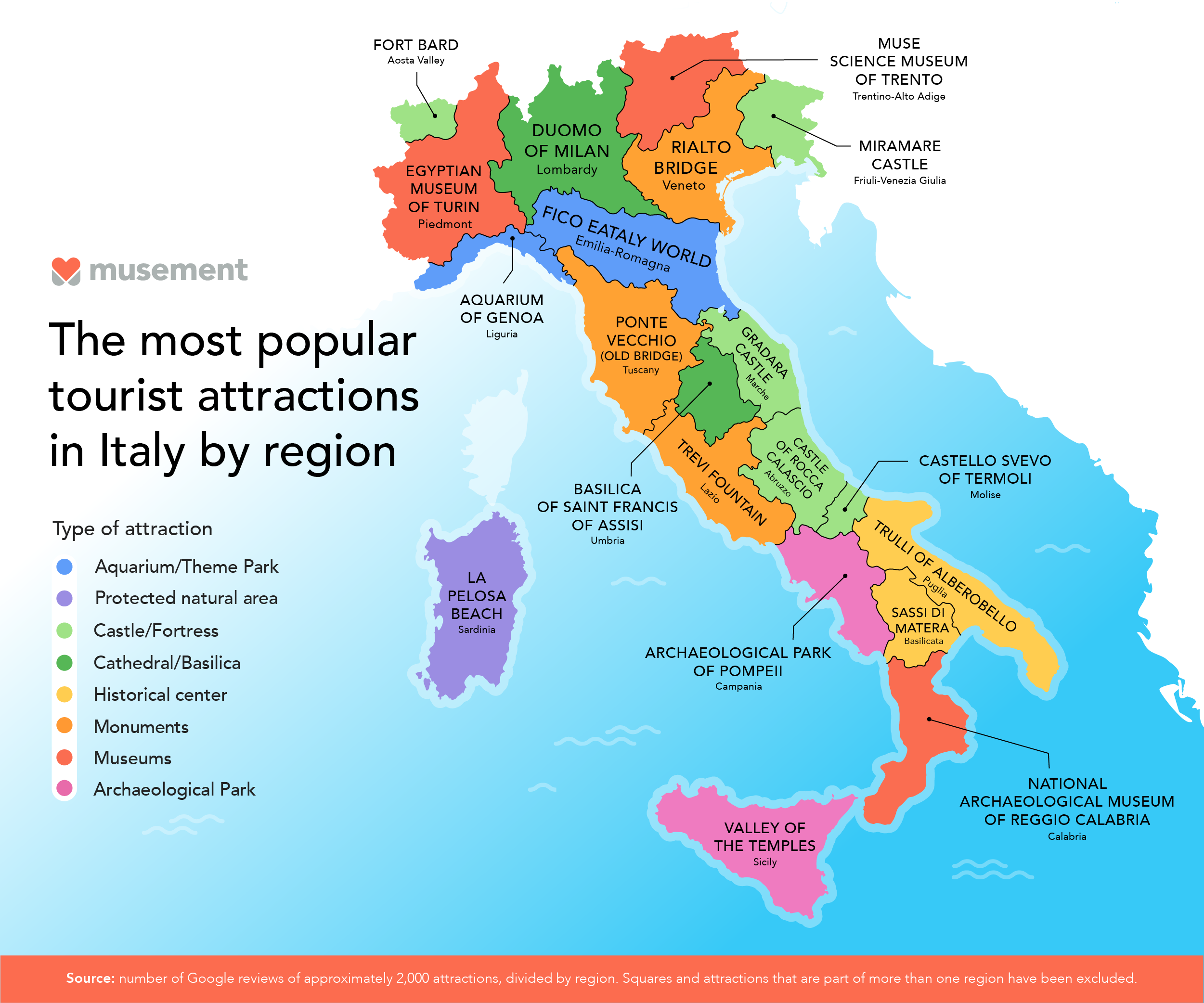
North Italy
Fort bard, aosta valley – 11,611 reviews.
Located in the town of the same name in the province of Aosta, Fort Bard was rebuilt at the beginning of the 19th century as a barrier fortress . Its construction on three separate levels makes it a fascinating and easily recognizable attraction. The ascent from the picturesque village of Bard to the last level of the fort can be done on foot, or by taking advantage of one of the panoramic lifts. A curiosity: the fort was chosen as the film set for the Hydra headquarters in the movie “Avengers: Age of Ultron”.
View this post on Instagram A post shared by Grazia Battezzato (@vercegraz)
Egyptian Museum of Turin , Piedmont – 34,730 reviews
Although the mysterious Mole Antonelliana is the symbol of the Piedmontese capital, the most visited tourist attraction is the Egyptian Museum of Turin. It’s easy to see why: the museum, founded in 1824, boasts one of the largest and richest Ancient Egyptian collections in the world . The possibility of joining a group tour, guided by an Egyptologist, makes the museum experience even more engaging.
View this post on Instagram A post shared by Creafilm.net (@vince_crea)
Duomo of Milan , Lombardy – 106,747 reviews
“Oh mia bela Madunina” sang Giovanni D’Anzi in the 1930s, and the echo still resonates today. So much so that the Duomo of Milan is one of Italy’s most visited attractions ever . The marvelous Gothic spires , the grandeur of the cathedral that dominates Piazza Duomo, crowned by one of the symbols of Milan, the Madonnina , attracts crowds of visitors every year. And if you are a true Milanese but have never walked up to the terraces, there is no time to waste.
View this post on Instagram A post shared by Duomo di Milano (@duomodimilano)
MUSE – Science Museum of Trento, Trentino-Alto Adige – 15,880 reviews
Trentino-Alto Adige is a particularly popular destination for mountain vacations. However, the MUSE – Science Museum of Trento is the most visited tourist attraction, beating the Tre Cime Natural Park. The exhibition’s floor plan is similar to the territory, spread over several levels as if you were on top of a mountain and had to descend towards the valley. The museum tells the story of human evolution. There is a fascinating greenhouse of tropical plants in the museum’s basement that is worth visiting.
View this post on Instagram A post shared by inTrentino (@intrentino)
Rialto Bridge, Veneto – 120,953 reviews
Between the sea, mountains, and historical monuments, Veneto has it all. With its unique charm and romantic views, Venice is the main attraction of the region. A perfect example of Venice’s beauty is the Rialto Bridge . Crossing the Grand Canal, the 48-meter long bridge was inaugurated in 1591 to replace the previous floating bridge. The Rialto Market , one of the most characteristic and colorful markets in Italy, is found at the foot of the bridge.
View this post on Instagram A post shared by Salvatore Matrisciano (@salvatore.matrisciano)
Miramare Castle , Friuli-Venezia Giulia – 18,490 reviews
With a scenic view of the Gulf of Trieste and a 22-hectare park, the Miramare Castle also houses a historical museum inside. The palace was built by Maximilian of Hapsburg in the second half of the 19th century. Today, in addition to a permanent collection of sculptures and paintings of the 19th century, the castle also hosts temporary exhibitions and events.
View this post on Instagram A post shared by mauro (@mauro.d.63)
Aquarium of Genoa , Liguria – 47,897 reviews
The Aquarium of Genoa attracts adults and children every year, thanks to its 12,000 animal specimens from all over the world and 200 plant species. Considered the largest aquarium in Europe, it manages to double the number of visits every year with its continuous renovations and innovations. In addition to the seventy exhibition tanks, the Biosphere created by Renzo Piano is another major attraction. Overlooking the port of Genoa , the sphere features a recreation of a tropical forest inside.
View this post on Instagram A post shared by Acquario di Genova (@acquariodigenova)
FICO Eataly World , Emilia-Romagna – 38,918 reviews
FICO’s uniqueness and Eataly’s reputation make this theme park extremely popular. Opened in 2017, FICO Eataly World is one of the largest agri-food parks in the world. Just outside of Bologna and including more than 150 made-in-Italy stores and eateries , an educational farm, and five multimedia rides, this attraction has a lot to offer.
View this post on Instagram A post shared by FICO – Il Parco da Gustare (@ficoeatalyworld)
Central Italy
Ponte vecchio, tuscany – 104,854 reviews.
Ponte Vecchio is one of the most special and symbolic monuments in Florence . Straddling the Arno River, it has a very ancient history and was the only bridge in Florence that crossed the river until 1218. It survived the bombings of the Second World War as well as the flood of Florence in the sixties. Crossing it you can admire the 16th century Vasari Corridor , the time when all of the butchers were replaced by the goldsmiths’ shops. These shops are still located here today.
View this post on Instagram A post shared by Elena & Jacopo |Travel Couple (@roadmindtrip)
Gradara Castle, Marche – 19,252 reviews
This impressive castle, built-in 1150, is perched atop a hill in Italy’s Marche region. Gradara Castle , as well as the fortified village, is often labeled as one of the best-preserved medieval architectural examples in Italy. The castle has also been chosen as the setting for many film sets.
View this post on Instagram A post shared by e-borghi (@eborghicom)
Basilica of St. Francis of Assisi , Umbria – 30,346 reviews
A pilgrimage destination for the faithful and lovers of art and architecture, the Basilica of St. Francis of Assisi was built in 1228. It has been recognized by UNESCO as a World Heritage Site since 2000 . The exterior of the basilica is built of Subasio stone and shows characteristics of the French Gothic style . The interior is divided into the Lower Church and the Upper Church, whose transept is decorated with Cimabue frescoes. A real jewel immersed in the heart of Umbria.
View this post on Instagram A post shared by Tiziana Banchetti (@tizianabanchetti)
Trevi Fountain, Lazio – 294,024 reviews
Thinking that the Trevi Fountain has the most reviews ever might not be so hard to believe. But what is more surprising is the fact that it beats the Colosseum , the symbol of the capital. Thanks to the romantic atmosphere, the magnificence of the monument, its prime location, and the hope that it makes wishes come true, the Trevi Fountain is the most visited attraction in all of Italy .
View this post on Instagram A post shared by Ya Ferreira | Pelo Mundo 🌎 (@yapelomundo)
South Italy and islands
Castle of rocca calascio, abruzzo – 8,344 reviews.
Rocca Calascio lies 1,460 meters above sea level on one of the slopes of the Gran Sasso whose main attraction is the majestic Norman-style castle. This Italian fortress, The Rocca, is located at the highest point in the region and has a landscape that seems to have come straight out of a fantasy film. The nature is lush and the view you can enjoy from the fortress is breathtaking. For those who love trekking, it is possible to reach the castle by following the path of the shepherds.
View this post on Instagram A post shared by GiorgioTeti_Ph (@giorgioteti)
Castello Svevo of Termoli, Molise – 1,522 reviews
Molise is the smallest and least populous region in Italy. For this reason, it is not particularly affected by mass tourism phenomena, another good reason to put it on your bucket list. The Castello Svevo of Termoli looks bizarre and seems to be completely out of place. Built-in the thirteenth century, it is situated right next to the sea and is the main subject of the ancient town’s skyline. If you’re in the area on Ferragosto (August 15th), don’t miss the spectacular staging of the castle fire.
View this post on Instagram A post shared by Alexandra (@alexandralleva)
Archaeological Park of Pompeii , Campania – 44,244 reviews
Considered a UNESCO World Heritage Site since 1997, a visit to the Archaeological Park of Pompeii is an incredible dive into the past. The utensils, villas, and temples are so well preserved, making this site an unparalleled example of life in Ancient Rome . You can admire the beautiful frescoes, the Roman baths, the noble villas, and the forum, the center of public life in the city. To fully appreciate the visit, joining a guided tour is highly recommended.
View this post on Instagram A post shared by @scavidipompei
Trulli of Alberobello, Puglia – 31,027 reviews
Trulli can be found throughout the Itria Valley , in the south of Puglia. The largest number of this traditional structure with ancient origins is found in Alberobello. Here, in the historic districts of Monti and Aja Piccola , you can walk through a town with a surreal, timeless appearance. The white of the limestone houses contrasts with the warm and vibrant colors of this beautiful region of Italy. Inscriptions in white ash with mythological or religious significance are often found on the roofs of the Trulli. Rich in history and traditions, this unique place is considered by UNESCO as a World Heritage Site.
View this post on Instagram A post shared by LE MERAVIGLIE PUGLIESI (@pugliaphotos_)
Sassi di Matera , Basilicata – 31,551 reviews
Matera’s historic city center is one of the most fascinating places in the country. The Sassi (rocks) actually have a history of hard work and extreme poverty behind them, a situation that led to their discontinuation in the 1950s. They have been declared cultural landscape by UNESCO since 1993 and ultimately became a part of the World Heritage Site. A unique landscape in the world, made of contrasts, history, beauty, and melancholy.
View this post on Instagram A post shared by IG ⊕ MATERA ® (@ig_matera)
National Archaeological Museum of Reggio Calabria, Calabria – 7,858 reviews
Have you ever heard about the Riace Warriors ? Dating back to Magna Graecia (“Greater Greece”), these two bronze statues were found by pure chance in the middle of the sea. These two iconic sculptures are kept at the National Archaeological Museum of Reggio Calabria, one of the most important archaeological museums in the world. The institution offers a journey through the art of Magna Graecia from the eighth century BC, displayed on four different floors in more than 200 showcases.
View this post on Instagram A post shared by Bronzi di Riace 🇮🇹 (@bronzidiriace.official)
Valley of the Temples , Sicily – 35,160 reviews
Another UNESCO World Heritage Site, the Valley of the Temples in Agrigento is an archaeological park of extraordinary historical and cultural interest. The area covers over 12 square kilometers where you can find eight excellently preserved Doric-style temples . The oldest temple in the park is the famous Temple of Heracles , but the most impressive is the Temple of Juno , a monumental structure with 30 columns still standing today.
View this post on Instagram A post shared by Parco Valle dei Templi (@valledeitempliofficial)
La Pelosa Beach, Sardinia – 12,810 reviews
Located in the Gulf of Asinara , this beach and nature reserve looks like a Caribbean paradise. Surrounded by Mediterranean shrubs, La Pelosa Beach offers you picture-perfect views of the famous Faraglioni rocks and the Falcone tower with its unique characteristics. It is hard not to visit one of the best beaches in Sardinia.
View this post on Instagram A post shared by Spiaggia La Pelosa (@spiaggialapelosa)
* METHODOLOGY : To conduct the research, approximately 2,000 tourist attractions throughout Italy were considered – excluding squares, which were considered an integral part of a city, and attractions shared by one or more regions (source: https://www.google.com/travel/things-to-do). The attraction with the highest number of reviews in each Italian region was considered the most visited. Data is updated as of January 2022.
You May Also Like
10 best amusement parks in america, 7 former prisons around the world you can visit, 10 instagram accounts that will make you want to visit rome, 5 of the most beautiful botanical gardens in europe, leave a reply cancel reply.
Your email address will not be published. Required fields are marked *
- Challenge me
- Enlighten me
- Take me away
- Uncategorized @us
- Wine and dine me
- Afternoon Tea
- Aix-en-Provence
- Alessandria
- Alnwick Castle
- Amalfi Coast
- Amazon Rainforest
- Adele Barnau
- Alessandro Santoro
- Alex Skinner
- Alyssa Fowler
- Amanda Coletta
- Ana Olivia Fiol
- Andrea Barragan
- Angelo Tarallo
- Anna Boshdemont
- Annalice Furfari
- Arianna Serra
- Bryan Shelmon
It's All About Italy

20 Most Visited Tourist Attractions in Italy [INFOGRAPHIC]
Looking for popular Italian attractions? Italy is, without any doubt, one of the most desired travel destinations. If I were to ask about reasons to go to Italy everyone would agree on food, picturesque landscapes, fashion and – of course – history and art! It’s mind-blowing that 60% of all the art of the world is concentrated in a country slightly larger than Arizona, in fact, we have more masterpieces per square mile than any other country in the world. And, if this weren’t enough, I taly also leads the way in regard to the UNESCO World Heritage Sites , with 51, the most of any country on the World Heritage list.
Italy’s private and public museums and art institutes are about 4,500! Therefore it is no wonder that when it comes to plan a trip to Italy it’s very difficult to decide were to go and what to see. Select Italy decided to help all those lucky travelers who are going to visit Italy by creating The 20 Most Visited Tourist Attractions in Italy I nfographic – based on a statistical survey of the Ministry of Heritage and Cultural Activities – to give you data and insights about tourists’ most visited spots of the Bel Paese . On the list you will find expected names – the Colosseum, the Uffizi Gallery and the Accademia – but there are also some Italy’s hidden gems that are actually not so hidden if you consider the numbers of the annual visitors we report here to you.
Before scrolling down and seeing the ranking, think about which attractions could be in the first three places and see if you guessed right! Whether you are headed north or south, you’ll find among these 20 at least one popular tourist sight to book and include in your next trip. Read on and unearth Italy’s tourists’ choices!
Popular Italian Attractions

So, what’s your take on the most visited t ourist a ttractions in Italy? Did you know them all? Share you thoughts with us!
Why book with Select Italy
We have over 23 years of experience providing luxury vacation destinations throughout Italy.
Our industry expertise, exclusive access to accommodations, handpicked tour guides, and unique vacation destinations differentiates Select Italy and allows us to create the best guest experience for you.
Expert Service | Price Match Guarantee | 100% Peace of Mind
Read more about Why you should book with us.
8 Tourist Attractions in Italy Worth Seeing
Italy’s tourist attractions are spectacular! Here, you’ll find breathtaking historical sites, stunning architecture, and enchanting nature. But what’s really worth seeing? Locals in Italy helped break it down.
For everything from safety tips to restaurant recommendations, work with a local to plan your trip. Locals in Italy can introduce you to a side of their country that most tourists miss. Learn more .
- Uffizi Museum
- Vatican City
- Venice Canals
- Milan Duomo

#1: Colosseum
Once the site of gladiator clashes, Rome’s Colosseum still tingles with the energy of battles past. It’s much quieter today—you’ll see more camera flashes instead of sparks from chariot races—but it’s easy to imagine the arena filled with 80,000 cheering spectators, as it was at its peak.
This site attracts crowds of the curious—so locals tell us it’s a good idea to buy tickets early in the morning to avoid the crowd. And don’t miss out on all that the Colosseum offers! One of our locals notes that your ticket also allows you access to Palatine Hill , one of the most ancient parts of the city.
If you’re looking for a burst of Roman history without the crowds, think about visiting the Verona Arena instead. Constructed in 30 A.D., it’s a well-preserved example of Rome’s legendary might.
#2: Uffizi Museum
Florence is one of our favorite places to visit in Italy . Why? The fantastic Uffizi Museum has a lot to do with it. Locals rave that it’s hard to beat Uffizi’s collection of classical artwork. One of our locals in Italy wrote:
“Among the highlights are the Birth of Venus and Primavera by Sandro Botticelli, the Madonna of the Goldfinch by Raphael, the Bacchus by Caravaggio, and my personal favorite - the Venus of Urbino by Titan (being Venetian, I have a soft spot for Titian!)”
The museum is definitely worth a stop if you’re in Florence. Benefit from local tips once you’re there—another of our locals suggests picking up the audio guide, as it’s “inexpensive” and full of “excellent information.”
How ViaHero Works

Choose a local

Message the local

Get a guidebook
#3: vatican city.
Locals tell us that the Vatican is an excellent place to stop if your travels take you through Rome. Technically its own country (the smallest in the world !) the Vatican is a deeply important religious site. (Locals say this means you should be mindful of how you dress—err on the more conservative side.)
Here, you’ll find iconic sites like Saint Peter’s Basilica, Saint Peter’s Square, and the Sistine Chapel. Like many tourist attractions in Rome, the Vatican can get crowded. For this reason, locals recommend visiting in the morning.
#4: Venice Canals
Full of winding canals, romantic bridges, and breathtaking sunsets, Venice is undoubtedly one of the most beautiful places to visit in Italy . One reason why it’s so magical? No cars are allowed! So, enjoy your Venice strolls. Locals tell us you’ll find lots of fantastic seafood in this seaside city—walk it off by crisscrossing Venice’s famous canals and bridges.
We love Venice, but it’s a destination that should be approached mindfully. Venice is one of the top sufferers of overtourism . How do you avoid being an overtourist ? It’s simple— travel in the offseason , aim to get off the beaten path, and see what locals say about activities that don’t make corporate guidebooks.
#5: Pompeii
Pompeii is a town frozen in time. Destroyed in 79 A.D. after the eruption of Mount Vesuvius, Pompeii today provides a look at life hundreds of years ago. Wander through the ancient ruins. Locals recommend visiting the well-preserved baths and seeing the still-vibrant frescos at Villa of the Mysteries. It’s an eerie (but very cool) thing to do while in Italy .
You can also visit the village of Herculaneum , which was similarly destroyed during Vesuvius’ eruption. Ashes and mud buried the city, leaving an extremely well-preserved record of life at the time.
#6: Lake Como
Where to go in Italy is a tough question. If you dream of sunning yourself in lakeside towns or exploring nearby mountain villages, then locals tell us you’ll love Lake Como.
One of the most enchanting places to visit in Italy , Lake Como is a refreshing change from the high energy of Italy’s cities . (Of course, locals note that it’s possible to have the best of both worlds—Milan is only a 90-minute drive away.)
Go for a relaxing kayak, hike up Brunate, and enjoy all the charms of Lake Como’s lakeside towns.

#7: Milan Duomo
Speaking of Milan...this next Italian tourist attraction is a true wonder. (Locals tell us you’ll find plenty of wonder in beautiful Milano! ). The Milano Duomo is one of the oldest and largest cathedrals in Europe.
Constructed in a decidedly Gothic style—which is different from most cathedrals in Italy—the Duomo looms over the city. Locals say it’s wonderful to look at the church from the Piazza del Duomo, but definitely worth it to buy tickets to climb to the roof. One of our locals wrote:
“I suggest you to go the Duomo Rooftop, you will admire an alternative view of the city, surrounded by majestic spires.
The Florence Duomo is another incredible cathedral in Italy.
If you visit Naples, one of our favorite spots in Italy because of its pizza and ports, locals suggest taking a day trip to the island of Capri.
Locals tell us that you can easily hop on a ferry from Naples . The crossing to Capri is less than an hour and costs about 20 euros.
Once there, enjoy! Locals suggest visiting the island’s famous “Blue Grotto”, hiking Monte Solaro, or checking out the ruins of Villa Jovis (the former home to the Roman Emperor Tiberius).
The “slow” ferry to Capri is a few euros cheaper, but it takes about an hour and a half.
Looking for more info?
And for more on Italy travel, check out:
- Is Italy Safe for Travel in 2023?
- Transportation in Italy: What to Know
- The Best Time to Visit Italy (According to Locals)
- Where to Stay in Italy: 13 Incredible Options
- Italy Travel FAQ 2023

Home » Destinations » Europe » Italy » 31 Beautiful Italy Attractions You Shouldn’t Miss
31 Beautiful Italy Attractions You Shouldn’t Miss
Links in this article may earn us a little money if you book/ order stuff. More here .

Check Out These Top Italy Attractions As Told By Travel Bloggers!
Wondering what is famous in Italy? You are not alone! From Tuscan villas and ageing cathedrals to beautiful lakes, mountains, rich history, food, and coastline – Italy is packed with something for everyone.
The country is full of unique places to visit – and we’ve actually only just scratched the surface!
Funnily enough, we have both been to Italy but it was years ago – well before we were together. We’re sort of planning an upcoming trip back to Italy together – and so we needed advice, too!
So, since there are so many amazing things to do and see in Italy, we asked a few fellow travel bloggers for their input.
The list below is the result of that – and wow has it become a great resource that is sure to help you (and us) trip plan!
Not to mention there are really pretty photos to look at. From the classic Rome tourist attractions to lesser-known towns, here are some of the top attractions in Italy!
Table of Contents
Top Italy Attractions
Okay, so now it’s on to what you’ve been waiting for – the attractions and places to visit in Italy! This list is in no particular order, so have a read through and get planning!
In case you want to just dive in, you can find and book top attractions in the widget below. Oftentimes, booking a line skip ticket in advance pays for itself in time saved once you arrive!
- Roman Colosseum, Forum, Palatine Hill Fast-Track Tour – Get Your Fast Track Ticket for Rome!
- Doge’s Palace Priority Admission Ticket – Experience the Doge’s Palace in Venice!
- Florence Dome Climb Guided Tour – Climb the Famous Florence Duomo for Amazing Views!
The Colosseum in Rome
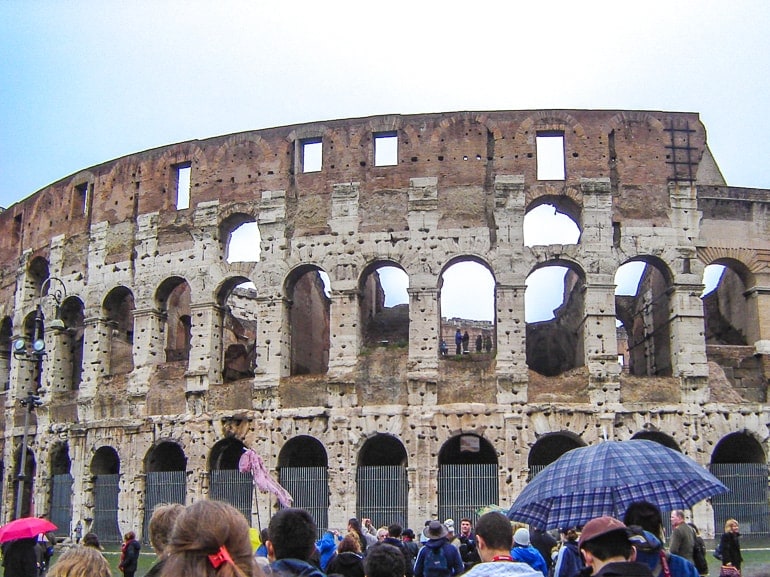
If you are heading to Italy, there’s a good chance you will stop through Rome. If you do, there’s a pretty important attraction people talk about – and you may have heard of it.
It’s this big oval structure that has been standing since the year 70 AD! Of course, the Colosseum in Rome is a stand out attraction.
As the largest amphitheatre ever built, it’s no wonder it still impresses visitors around the world 2000 years later.
Even if history isn’t your thing, a visit to the Colosseum is a must-do. It’s a fascinating feat of architecture and a glimpse into Ancient Roman times.
Eric has visited and to this day he still remembers how neat of an experience it was being inside the Colosseum.
Since it’s so popular, the lines can be pretty long so consider an official skip the line ticket to the Colosseum, Palatine Hill, and Roman Forum !
Rialto Bridge in Venice
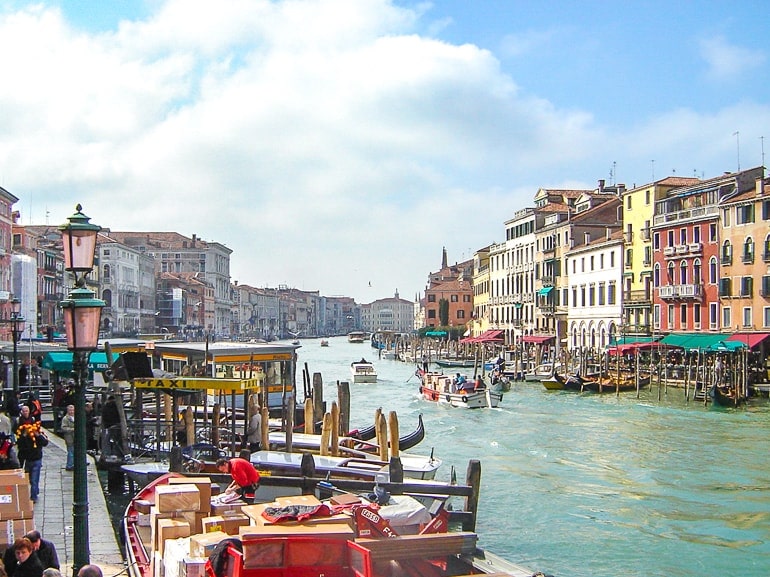
If you are heading to Venice, there are plenty of amazing attractions to explore. From the Doge’s Palace and St. Mark’s Basilica to exploring the alleyways and wandering over canal bridges, there’s so much to experience in Venice.
One of the most famous and the oldest of the four bridges to cross the Grand Canal (the main canal through the heart of the city) is Rialto Bridge.
Built back in 1588, this bridge draws crowds for its stunning views of the canal in either direction (see Eric’s photo above) and for its own architecture.
The bridge can get pretty busy – but it’s a great vantage point and it’s functional to get around Venice, too!
- Venice is a popular place – here’s a great guide on things to do and see in Venice !
- If you only have one day to explore, check out this one day in Venice itinerary .
Duomo di Firenze (Florence Cathedral)
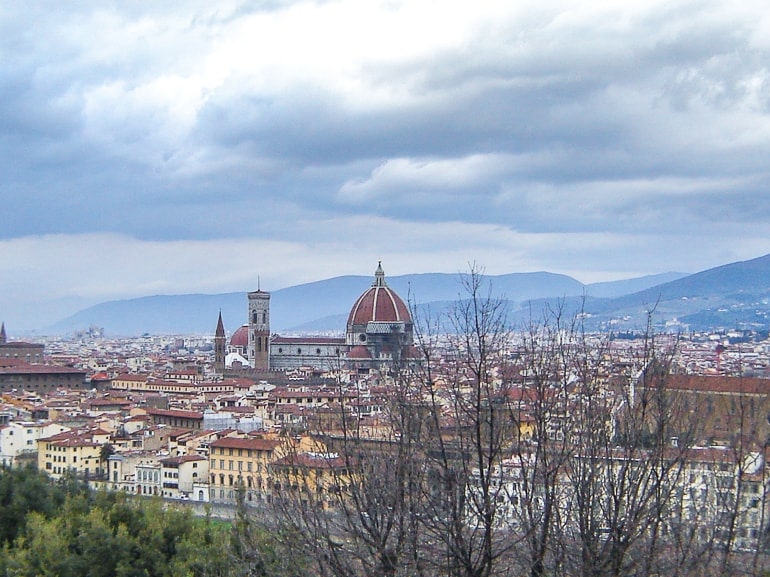
Officially the Cathedral of Santa Maria del Fiore, the Florence Cathedral, or the Duomo di Firenze is a sight to see on any Italy trip.
This popular Gothic structure has been drawing in visitors for centuries. Construction started in 1296 and took around 150 years to complete!
Today, the cathedral and the famous red-tiled dome stand proud among the Florence skyline.
If you are heading for Florence on your Italy trip, you should look into Cathedral tickets in advance since it’s a popular attraction.
But it’s worth it to tour the cathedral and climb the 463 steps for amazing views from the dome !
Cinque Terre
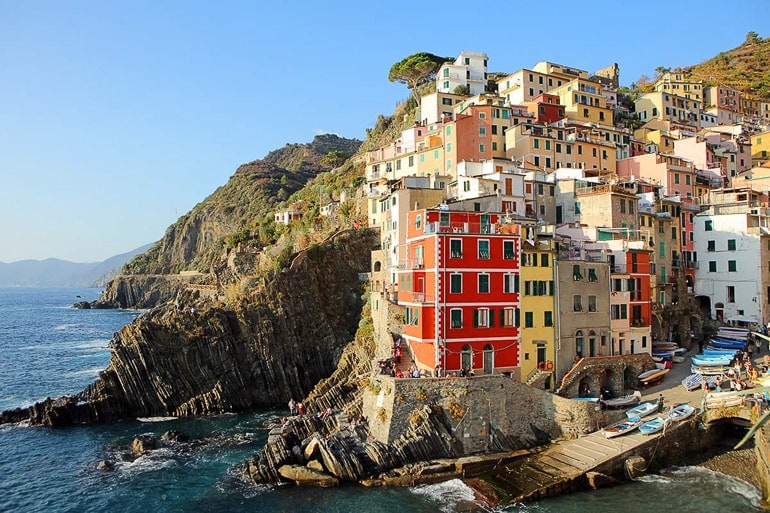
Recommended by Jurga from Full Suitcase
Cinque Terre is a stunning coastal area along the Italian Riviera and definitely one of the must-see places in Italy.
Five little villages perched between the mountains and the sea are incredibly picturesque and, together with the surrounding coastal areas, form a UNESCO World Heritage site.
It’s not easy to get to the villages by car – it’s best to either take a boat, a train, hike, or a combination of the above.
You can visit Cinque Terre in one day or you can spend a few days here. If you have more than a day in this area, don’t miss the nearby Portovenere village – it’s really beautiful and isn’t as overrun by tourists as the five towns of Cinque Terre.
Located within easy reach from the other major tours destinations like Florence or Pisa, Cinque Terre attracts huge crowds.
If you can, avoid visiting in the summer months. Probably the best time to visit Cinque Terre is the shoulder season: March – April or the end of September – October.
Boat service stops in November, so if you come in the winter, you’ll have to take a train.
Book Your Experience – A Cinque Terre Day Trip from Florence
Ostia Antica in Rome
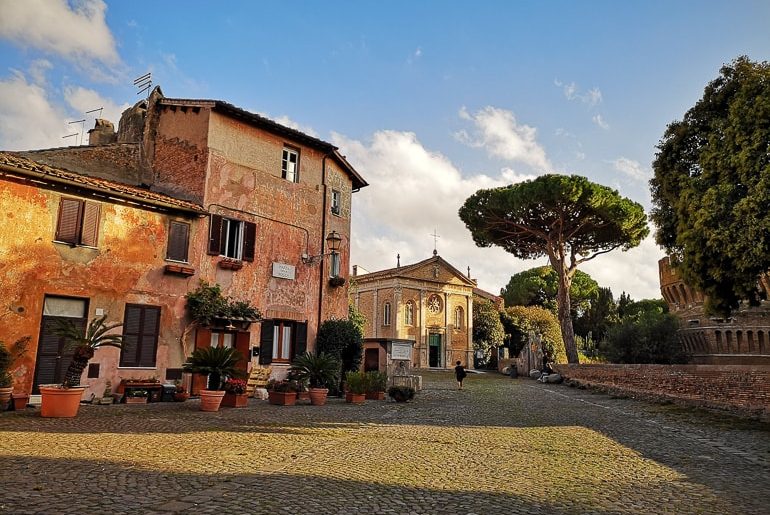
Recommended by Marta from Mama Loves Rome
A wonderful corner of Italy and one I recommend all visitors to add to their Italian itinerary is the gorgeous small village of Ostia Antica.
Located just outside of Rome, Ostia Antica is famous for being the city’s ancient port and is now home to a wonderful archaeological park.
Often compared with Pompei, but smaller and quieter, Ostia is a very well preserved site and one that is easy to enjoy.
Not yet discovered by mass tourism, here you can spend your day wandering around ancient Roman streets and taking in the beauty of Ostia’s old theatre all while being surrounded by the park’s tall pine trees and large open spaces!
It is a great place to escape the busy streets of Rome without having to give up sightseeing.
The park is what attracts most visitors here but just beside it lies what I believe is the real hidden gem of this area: Ostia Antica’s medieval borgo (village).
The borgo is an enclosed square developing around a turreted castle and a small yet impressive church.
The houses opening up onto the square are private homes but they are worth seeing because of the beautiful colours of their walls and the cascading flowers now decorating them.
You can visit both the park and the borgo in the space of an afternoon. I highly recommend coming in spring, when you can finish your day with a meal in the borgo’s tiny and delicious family restaurant!
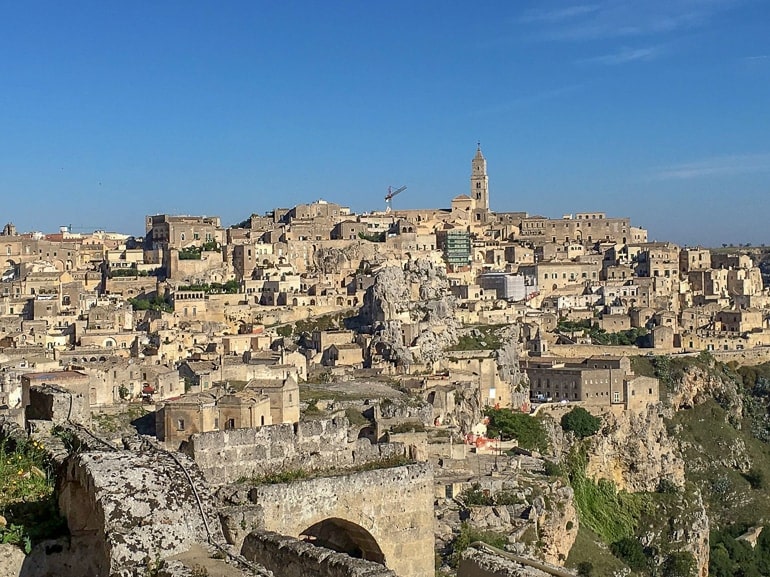
Recommended by Talek from Travels With Talek
A town carved straight out of the mountain, it is known as”la Città Sotterranea” (the Subterranean City).
The city is a UNESCO World Heritage Site. It has been inhabited since prehistoric times and is so surreal and unique that many movies have been filmed there including The Omen, Mel Gibson’s The Passion of the Christ, and most recently, Ben Hur.
So many of Matera’s sites are underground. The caves are used as homes, theaters, restaurants, churches. You can stay in a cave hotel.
There is even an underground museum filled with sad statues depicting dancers and young girls looking wistfully in the distance. Maybe they are sad because they are in an underground cave without sunlight.
Matera is as unusual and unique a city as any I’ve ever been to. Despite its cave dwellings, it can be charming above ground. There are open parks and gelaterias everywhere.
One of the most interesting aspects of Matera is its history. Stop by the local museum and see how such a city developed over the years.
Cagliari, Sardinia
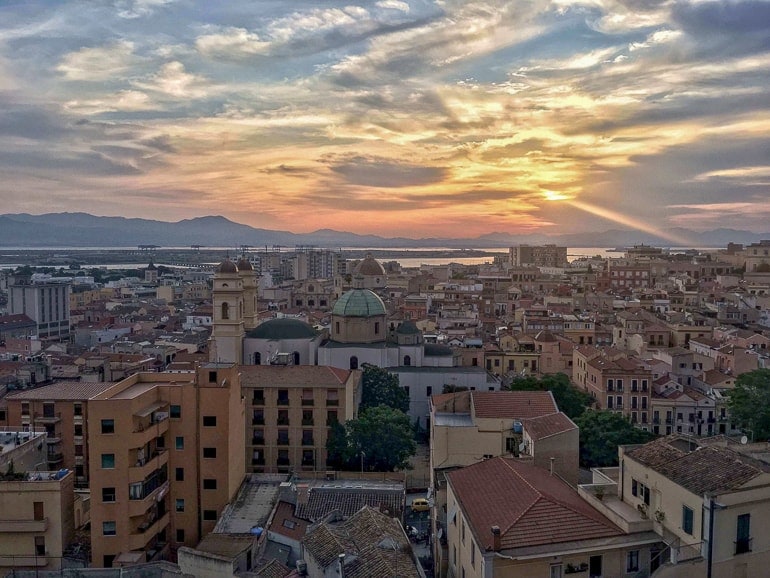
Recommended by Claudia from My Adventures Across The World
Not many people make it to Cagliari during their trip to Italy. They are missing out because the capital of Sardinia is a lovely place to visit in any season.
The center of the city is a maze of narrow cobbled alleys and colorful buildings, with lovely small cafés scattered around.
The city is packed with viewpoints from where you get to enjoy some of the most impressive sunsets in the Mediterranean.
Cagliari has a long history, which can be found in the many churches, archeological sites and museums scattered in the center.
The beautiful urban beaches – Poetto and Calamosca, among others – are perfect places to relax for a few hours and they give easy access to Molentargius, a natural park from where it is possible to admire pink flamingos, and to Sella del Diavolo, a promontory that can be easily hiked for incredible views over the city and the bay.
San Fruttuoso
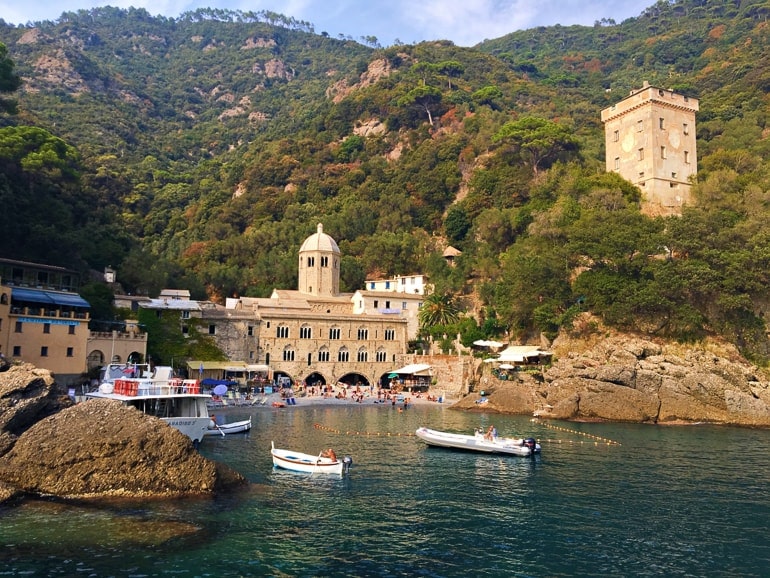
Recommended by James Ian from Travel Collecting
One of the best experiences you can have in Italy is a day trip from Rapallo to San Fruttuoso .
Boats leave frequently from a dock in the middle of town to Santa Margherita and then on to Portofino. This tiny port town is the playground of the rich and famous.
It’s incredibly picturesque – a tiny bay crammed with boats and surrounded by brightly painted houses. Explore a little before taking a path up a long set of steps into the hills above, past lemon trees, tiny olive groves and fields of wildflowers.
Portofino Bay soon becomes a tiny gem shining far below. The Mediterranean sparkles in the sunshine and the fresh air is invigorating.
The main part of the hike is flat, with the sea far below. Eventually, you’ll descend a series of switchbacks through some cooling trees down to a tiny emerald green bay backed by the golden San Fruttuoso Abbey.
The bay is a true hidden gem, accessible only by boat or on foot.
There is a small museum in the 13th-century Benedictine monastery and they are several seafood restaurants overlooking the water.
You can rent deck chairs (the beach is pebbly) and spend the rest of the afternoon cooling off from the hike in the sea.
End this perfect day by taking a boat directly back to Rapallo where you can relax with pizza and a glass of wine at a waterside cafe.
Casa Artusi in Forlimpopoli

Recommended by Megsy from Food Fun Travel
We all know that Italy has amazing food but if you are a lover of cooking then why not do a cooking class at the former home of the man who created Italy’s Bible to cooking at Casa Artusi in Forlimpopoli.
“Science In The Kitchen And The Art Of Eating Well” was published in 1891 by Pellegrino Artusi and since then has been translated into English, French, German, Dutch, Spanish, Portuguese and Russian.
This book contains over 790 traditional recipes and is considered a literary classic – and if you travel to the small town of Forlimpopoli you can visit Artusi’s home and even experience a cooking class.
The best way to get to Forlimpopoli is to visit as a day trip from Bologna in the Emilia Romagna region of Italy.
On the grounds of Casa Artusi you can visit the on-site library that contains over 45 thousand books including many original editions of “Science In The Kitchen And The Art Of Eating Well”.
There is also a restaurant on the grounds with exquisite food but we highly recommend getting your hands dirty and learning to make some of the dishes yourself at the cooking school.
This is actually a cooking school that is attended by both amateurs and professionals wanting to broaden their knowledge of traditional Italian cuisine and learn how to make traditional Romagnolo home cookery, including fresh, homemade pasta and piadina (the local flat bread).
It’s certainly a unique and memorable place to visit in Italy for true lovers of food.
La Pescheria in Catania, Sicily
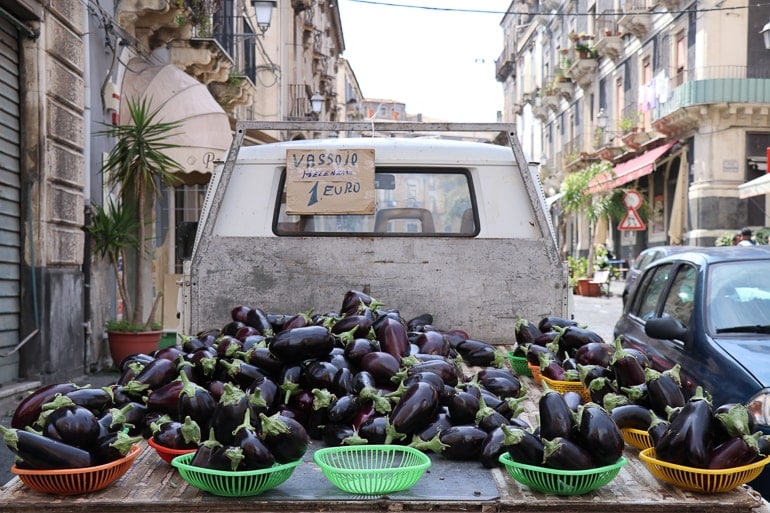
Recommended by Jennifer from The SoFull Traveler
Sicily is home to some of Italy’s most robust Italian culture, especially when it comes to food. Now, many would argue that Italian food is already robust in nature, but Sicilian food is its own genre.
If you want to get a taste, literally and figuratively, of the passionate people of Sicily, your one-stop should be to La Pescheria, the fish market.
La Pescheria is located in the city center of Catania, Sicily where you’ll find all the locals selling their fresh produce and seafood.
The perimeter of the square is lined with vibrant colors of fresh vegetable stands while its center is filled with rough looking fishermen, still in their wellys, spraying down decapitated fish and remaining blood off the table.
It’s a bit chaotic but it’s absolutely lovely in every way. From the quality of the food to the entertainment of the street vendors, you’ll see and taste the best of Sicily at La Pescheria.
Duomo di Milano (Milan Cathedral)
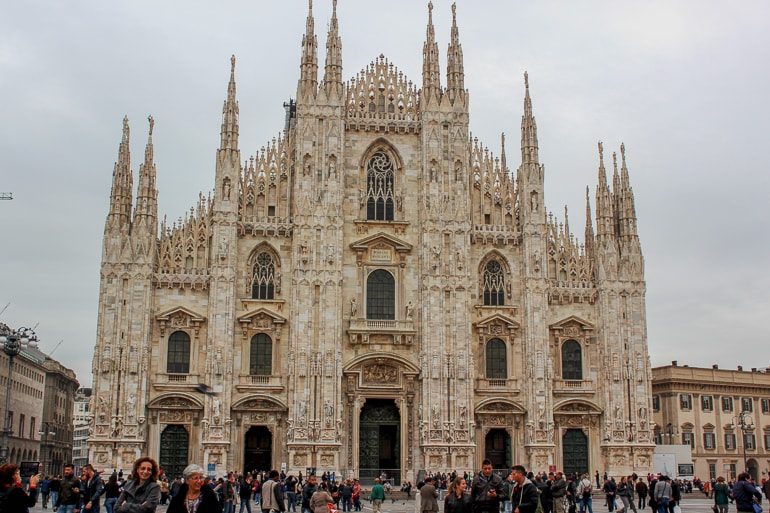
Recommended by Melissa from Parenthood and Passports
The Milan Duomo is one of the most spectacular architectural masterpieces of all time. The gothic cathedral near the city center of Milan, Italy took six centuries to build, and it’s easy to see why with all the intricate spires and pinnacles that make up the church’s exterior.
As the largest cathedral in Italy, the Milan Duomo is definitely one of the best attractions to visit in the country. In fact, it’s worth spending at least one day in Milan just to see the Duomo.
The inside of the cathedral is equally breathtaking with its large, marble pillars and elaborate altars.
For a small fee, you can visit the terrace on the roof of the cathedral where you can see the Duomo’s detailed construction up close.
It’s worth the extra money to visit the terrace and look out over the piazza through the forest of spires.
Roman Forum and Palatine Hill in Rome
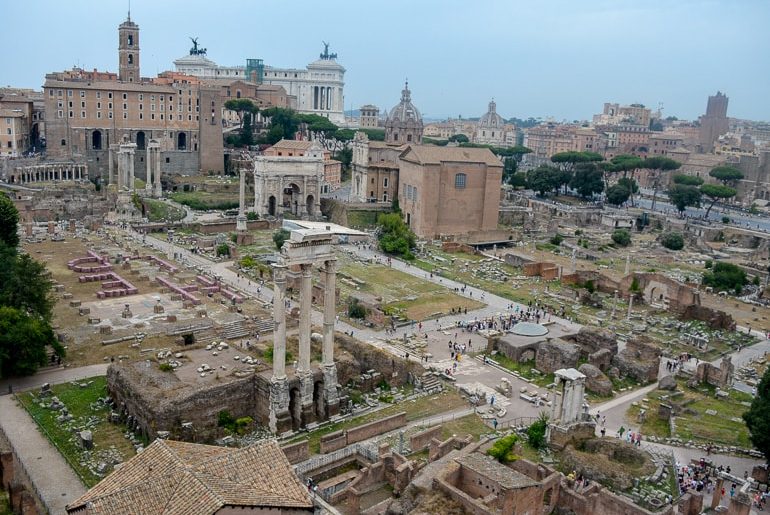
Recommended by Catherine from We Go With Kids
Our visit to the Roman Forum and Palatine Hill allowed us to step back in time and gain a deeper understanding of Roman history.
The Roman Forum and Palatine Hill are located next to the Colosseum in central Rome. Admission to these two interconnected sights was included in our Colosseum tickets .
While most of the remaining structures are in ruins, the remains sparked our imagination of what the governmental, cultural and civic center of Rome looked like thousands of years ago.
Our kids were wowed by the Circus Maximum where the Ben-Hur chariot races took place, the Palace of Domitian and the three columns standing from the Temple of Castor and Pollux.
We also made sure to examine the Arch of Titus, which was an inspiration for the Arc de Triomphe in Paris.
We were glad we had a chance to explore these two sights before our Colosseum tour.
For budget visitors or those with limited time, much of the Roman Forum and Palatine Hill are visible by walking around the periphery, and we wish we had a chance to see it lit up at night.
Courmayeur in the Italian Alps
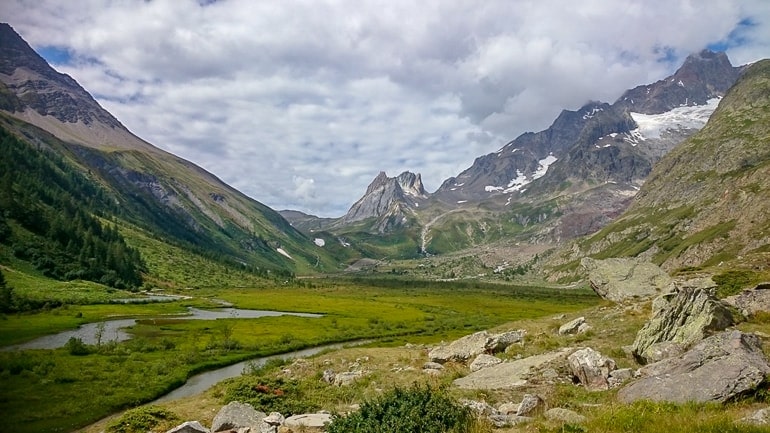
Recommended by Gemma from A Girl & Her Dog On The Road
Courmayeur is in the mountainous northern region of the Aosta Valley in Italy, nestled in the Alps, just on the Border with France.
It is perhaps most famous for its dramatic views of Mont Blanc (or Monte Bianco in Italian), upmarket ski resort status and for being a mecca for mountaineers and hikers.
Even for novice walkers, there are some amazing easy day hikes , those through Val Veny and Val Ferret are breathtaking.
Outwith the winter and summer season, this beautifully preserved and traditional alpine village has a friendly and very sleepy vibe.
If you are not a hiker you can get great 360-degree panoramic views from the uniquely rotating Skyway Monte Bianco Cable Car.
Relax in the luxurious QC Terme Spa in nearby village Pre-Saint-Didier with over 40 de-stressing activities, including a massive outdoor thermal spa area with jaw-dropping outlooks.
Enjoy some local Fontina Cheese and Pan Ner (traditional black bread) at one of the many great bars or restaurants. My favourite is family-run Ristorante Chalet Plan Goret (booking advised).
Marvel at the athletic ability and endurance of the competitors taking part in the Tor Des Geants.
This 330km mountain race takes place in September and competitors run a mountainous route that starts and ends in Courmayeur. The carnival atmosphere in the village is fantastic.
Courmayeur is just half an hour away from Chamonix, an hour and a half from Frances ‘Little Venice’ Annecy, and less than an hour from the historical region capital, Aosta.
Rent a car and enjoy discovering all the characterful mountain villages that surround Courmayeur.
Piazza del Duomo in Parma
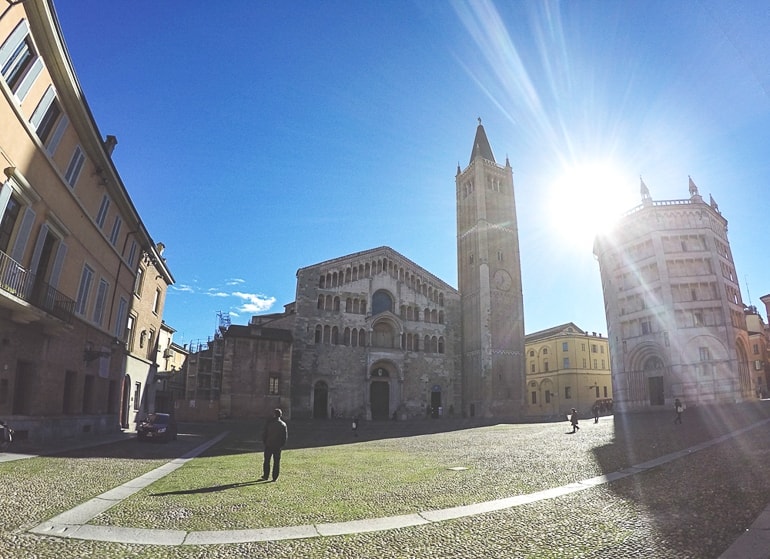
Recommended by Amélie from Mostly Amélie
Parma is not just for ham! The main square, Piazza del Duomo, is a history-dense and intact medieval masterpiece.
Located well outside the bustle of the city, it’s also a very quiet spot to stop by and admire several sights all at once, most notably the beautiful marble Battistero.
Considered by many as one of the most important Medieval monuments in Europe, it’s an impressive octagonal structure made entirely of pink Verona marble.
The imposing structure of Romanesque-Gothic architecture was built between the 11th and 13th centuries and is covered in intricate sculptures.
But of course, that’s not all. There’s the Bishop Palace to one side of the Piazza, the Diocesan Museum to the other side, and the piece de resistance, the main cathedral, or the Duomo, itself. Here, you can lose yourself for hours in art history.
The main fresco inside of the dome, the Assumption of the Virgin by Correggio, is one of the most mesmerizing Renaissance paintings I have ever seen in my whole life.
Definitely, do light it up by feeding the rather gimmicky coin-operated dome light a euro. It’s totally worth it!
The Royal Palace of Caserta
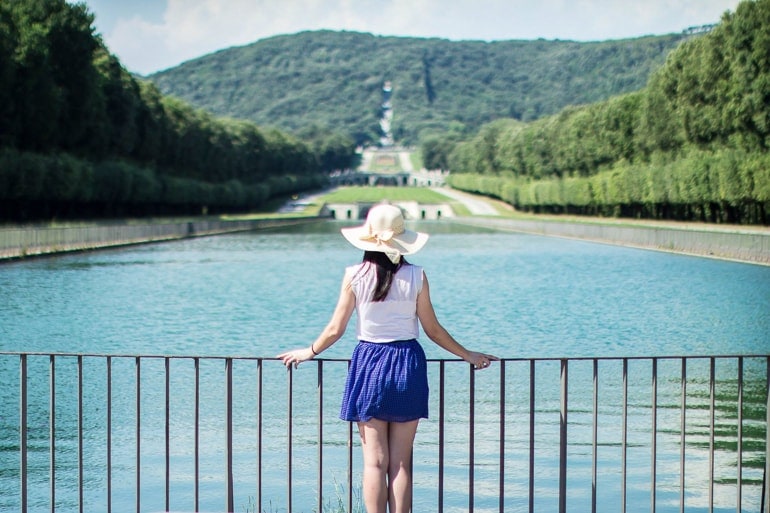
Recommended by Serena from Serena’s Lenses
The Royal Palace of Caserta is a former royal residence located in Caserta in Southern Italy. It’s one of the largest palaces in Europe with 1200 rooms, 5 floors, a library, and a huge garden.
One may find a resemblance between the Royal Palace of Caserta and the Palace of Versailles outside of Paris and it’s because the Palace of Caserta is modelled after the Palace of Versailles!
It is surprising that the Royal Palace of Caserta is an off the beaten path destination in Italy since it is so beautiful and magnificent.
Potentially it’s overshadowed by Pompeii, another popular tourist destination in Italy and a popular day trip from Naples.
It takes about an hour by train to reach Caserta from Naples and there are frequent train services between the two cities. The palace is a few hundred meters from the train station in Caserta making it very easy to visit.
Since the palace is not very well known for many tourists, there generally is not a crowd especially if you visit later during the day.
For most of the afternoon, you may have the gardens to yourself. Note that the palace is closed every Tuesday. Plan at least 2-3 hours to visit the palace and enjoy the trip.
The Aeolian Archipelago
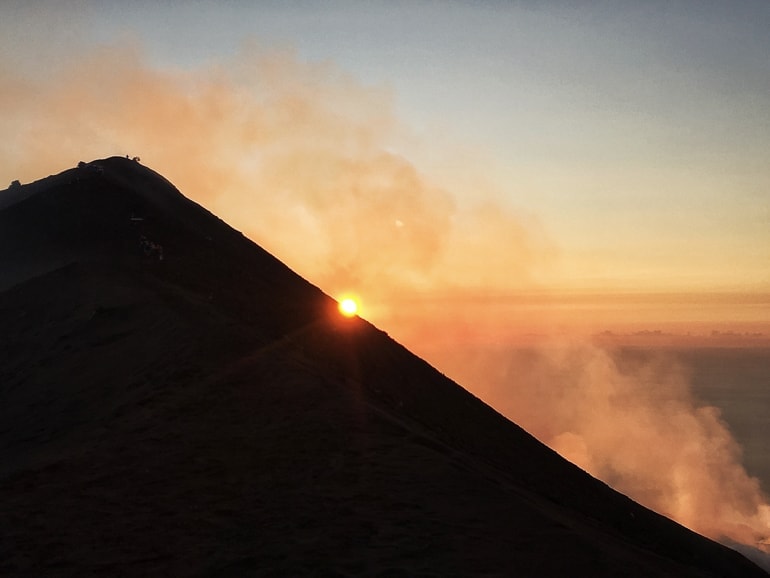
Few places in Southern Italy are as charming as the Aeolian Islands. This archipelago made of 7 volcanic islands off the coast of Sicily is best visited in the summer months.
It can be reached by a hydrofoil ride departing from Milazzo, a small town near Messina.
It’s the perfect place to go on a sailing trip – but if this is not your thing, there is still plenty to see and do. Each island is different and offers a different experience.
If you are looking for luxury and a bit of pampering, Vulcano may be the place for you. There you will find lots of boutique hotels and luxury resorts, and you will be able to visit the mud baths as well.
An easy hike to the Gran Cratere (great crater) will provide incredible views over Lipari – the biggest island in the archipelago.
Adventure lovers should head to Stromboli , home of the most active volcano in Europe.
The tiny village is the perfect departing point for guided hikes to the craters, from where visitors get to enjoy the regular explosions and to admire one of the most beautiful sunsets they will ever see.
Siracusa, Sicily
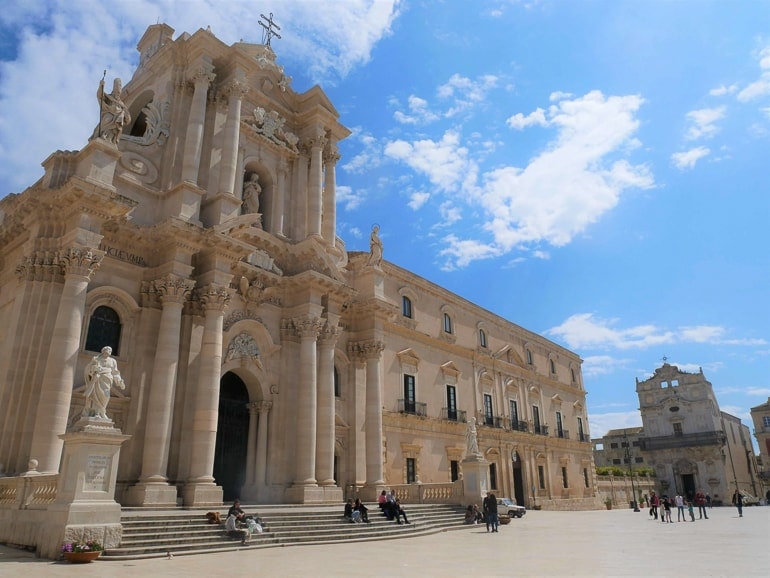
Recommended by Marta from Learning Escapes
One of my favourite places in the whole of Italy is the stunning city of Siracusa. Located on the East coast of Sicily, Siracusa dates back to Greek times and now mixes seamlessly with ancient history, medieval charm, and a modern vibe.
It is a wonderful place to add to your Italian itinerary and one that for many stays as a highlight of their whole trip.
The city has two main areas of interest to the visitor: the old centre, which develops on the small island of Ortigia, and the archaeological park.
Ortigia is small and beautiful. Here you have relatively little traffic and a plethora of small meandering alleys hiding architectural treasures such as the temple of Apollo, the fountain of Arethusa and the impressive duomo.
This one opens up on a large square and is unique as it mixes remains of the ancient temple of Athena with Sicilian baroque style.
The archaeological park has a different vibe from Ortigia but is equally impressive. Here you have Siracusa’s Greek theatre and the infamous Latomie, the quarries where so many prisoners lost their lives when Siracusa ruled the Mediterranean.
The park is a short bus ride away from Ortigia and both can be visited in one day.
If you can, I recommend you visit in spring when the weather is beautiful but not yet too hot and start your day in Ortigia to then see the sunset over Siracusa’s archaeological park.
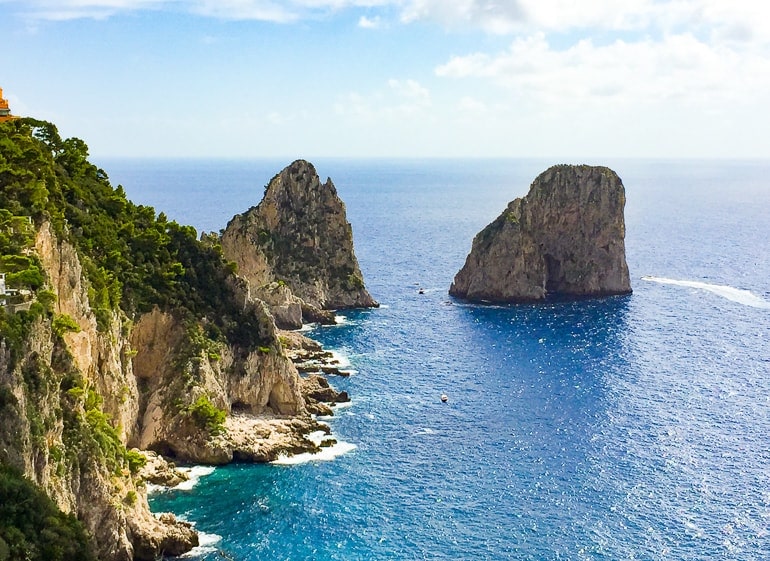
Recommended by Dhara from It’s Not About the Miles
The enchanting Isle of Capri should definitely be on your itinerary for Italy if you plan to visit the southern region of Campania.
Made up of two towns, Capri and Anacapri, the island is located in the beautiful Bay of Naples. It is easily accessed by ferry from Sorrento or Naples.
In fact, Capri is one of the best day trips from Sorrento you can do. Capri’s beautiful blue waters, elegant villas, and gorgeous gardens will captivate you.
Once on the island, do a boat tour that goes around the island . If the conditions are right, you can visit the famous Blue Grotto!
Your boat will pass through the enormous Faraglioni rocks and past the Capri lighthouse. Then take the funicular up to Capri Town, where you can wander the streets, take in the views of the water, and spend some time in the famous main square, La Piazzetta.
Finally, take the bus up to Anacapri, where you can take the chairlift to the top of Mt. Solaro and visit Villa San Michele, with its lovely terraced gardens.
While in Capri, don’t forget to have a panino caprese for lunch and a slice of torta caprese to follow!
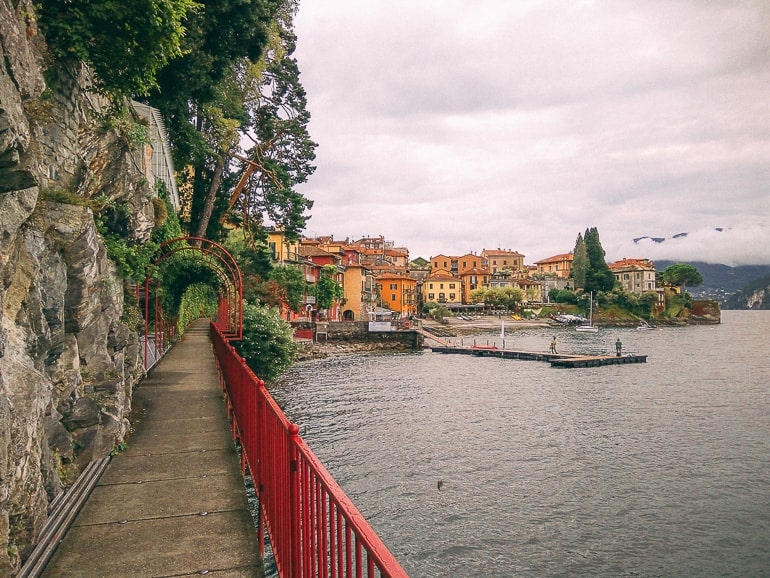
Recommended by Or from My Path In The World
Whether you’re looking for a weekend getaway from Milan or taking a road trip through northern Italy , you have to visit Lake Como, the third-largest lake in Italy.
The lake is famous for its Roman villas (luxurious country houses built in Roman times) like Villa Carlotta, Villa d’Este, and Villa Serbelloni.
Nowadays, the villas around the lake are functioning as luxury hotels, museums, conference centers, etc.
The lake is also home to many beautiful towns and villages that are worth exploring. Bellagio and Varenna are probably the most popular ones, but if you have more than one or two days, you can also visit cities and towns like Como, Lecco, and Menaggio.
To enjoy the best of what Lake Como has to offer, I recommend visiting in early autumn. The weather is much more pleasant than in plain summer and there are a lot fewer tourists.
For these reasons, I believe that late spring would also be a great time to visit the lake.
Explore Lake Como – Take a Lake Como and More Day Trip from Milan
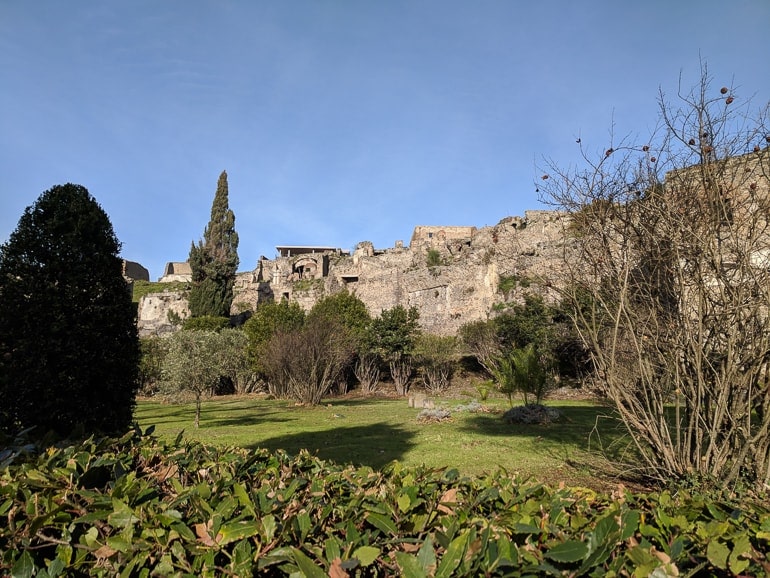
Recommended by Kris from Nomad By Trade
In a country full of historic sites, the Pompeii archaeological site is one of the most unique places you can visit and makes a perfect day trip from Naples or Sorrento.
In AD 79, nearby Mt. Vesuvius erupted and buried the city in ash and pumice stone. The layer preserved the city as it was on that day for centuries before excavations began.
Villas, bakeries, religious sites, baths, and more fill the ancient city. Visitors can explore on their own or take tours to see the excavated buildings.
The amphitheater there even holds concerts because the sound quality in it is so good.
Though most of the frescoes and other décor have been removed to be housed in museums and other collections, some of the buildings still have their original wall paintings from all those centuries ago.
Don’t miss the Forum, which houses some of the most impressive ruins in the city and was a central gathering point for its inhabitants.
The eeriest reminder of the devastation here comes in the form of the plaster casts made of the bodies found during excavations.
Many of the people and animals of Pompeii were buried by the ash and pumice and as their bodies decomposed, they left voids in the stone.
These were filled with plaster by archaeologists and give a heartbreaking insight into what their final moments might’ve been like.
Explore Right – Get a Line Skip Entrance Ticket to Pompeii
Mount Vesuvius
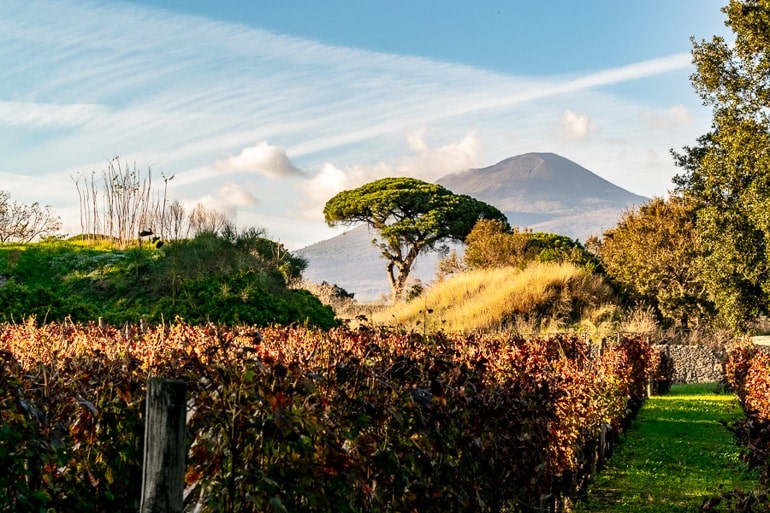
Recommended by Kate from Our Escape Clause
When you peer into the crater of Mount Vesuvius, you’re staring into the eye of a beast that once reshaped life along the coast of Campania: in 79 AD, it was this crater that spewed the lava that buried Pompeii and Herculaneum.
Today, visiting Mount Vesuvius is extremely low-risk–the volcano hasn’t erupted since 1944 – but it’s still a bit thrilling to hike along the edge of an active volcano, especially if you pair it with a visit to Pompeii .
The climb from the parking lot where you’ll arrive at Vesuvius, either by car or bus, to the crater, only takes about 20 minutes, but the views of the Bay of Naples, Capri, the Amalfi Coast, and Pompeii below are pretty magnificent.
If you can, definitely visit Mount Vesuvius on a very clear day, as the views truly are one of the best parts of the experience, and haze can disrupt that.
You can visit Mount Vesuvius either via a tour or simply by taking public transportation. If you have a rental car , you can also drive up.
There is a small shop with coffee, drinks, and snacks located in the parking lot of Mount Vesuvius, but we recommend bringing at least a bottle of water along with you.
Additionally, the loose, volcanic sand and gravel can make the hike a bit uncomfortable in sandals, so consider wearing closed-toe shoes when you visit Mount Vesuvius!
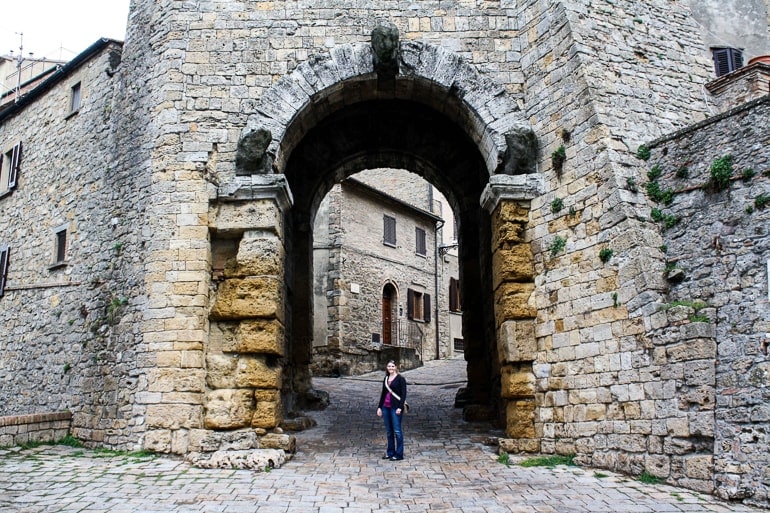
Recommended by Chelsea from Pack More Into Life
Volterra is a small hilltop town located in the Tuscan region of Italy. It is about 1.5 hours southwest of Florence by car.
If you are planning a visit to the Tuscan region and have the bigger cities of Siena and San Gimignano (also lovely) on the list, then be sure to add Volterra.
Volterra is a medieval walled city that dates back to the 7th century BC. It features a Roman theater, town square, city hall, Cathedral with Bell Tower, and Etruscan museum.
The highlight is the shops and craftsmen using alabaster to create a variety of items to sell.
Ask to step inside and watch them work away on a masterpiece or string small beads on a delicate bracelet.
Then continue to wander through the city, exploring the Etruscan gates and linger over a delicious Italian lunch at one of the many amazing restaurants.
Looking for more places to visit in Italy or across Europe? Check out my Europe Guide on my blog .
Murano Island
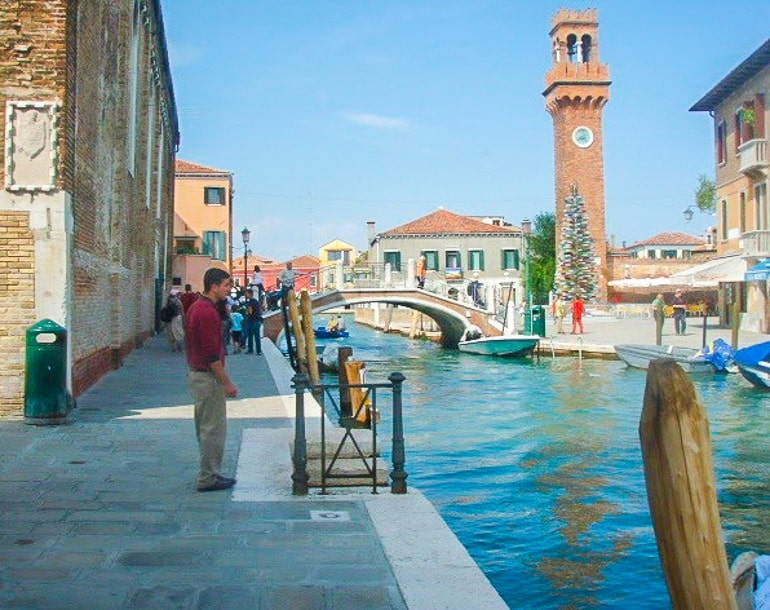
Recommended by Diana from The Elusive Family
As one of the little islands right off the city of Venice, Murano Island is a quaint island, home to the world-famous Murano glass. Hopping on a ferry over to Murano is a quick way to visit the colorful island.
Strolling through the narrow alleys hugging the canals, visitors can pop into one of the numerous shops selling Murano glass.
It comes straight from the source and there is an unlimited assortment of jewelry, wine stoppers, ornaments, and so many other pieces.
Tip: be sure to look for the “Vetro Murano Artistico” trademarks when purchasing authentic Murano glass!
Murano glassmakers have open factory tours where glass blowing demonstrations are common. The history of Murano glass-making is remarkable, as historically, it is one of the most sought after and well-known glass making locations in the world.
Murano glass is found across royal palaces and homes across the world, and its immense beauty and precision making is considered unique to its history and craftsmanship.
Apart from visiting glass making factories, stopping at the Chiesa di San Pietro Martire as well as the Basilica dei Santi Maria e Donato is well worth a visit.
Finally, simply wandering the quiet canals, which differ a bit from Venetian canals, make for a memorable visit to Murano Island.
Explore Beautiful Murano – Take a Boat Tour of Murano and More
The Leaning Tower of Pisa
Recommended by Daisy from Beyond My Border
The Leaning Tower of Pisa is an iconic symbol that represents the century-old architecture of Italy.
Much like the ancient streets of Rome and the water canals in Venice, the Tower of Pisa is a must-visit for anyone embarking on a trip across Italy.
Pisa is an adorable city that lies in Tuscany. It’s an hour and a half away from Florence, making it a great day trip that’s easily accessible with one of the 45 Regionale trains between the two cities.
Between the green fields and the bright blue skies, Pisa lies peacefully amongst the undulating country lanes.
I spent a few days in Florence during my 15-day trip across Italy . Between the gelatos and cheese buns, we managed to squeeze half a day in for a tour around Pisa.
We arrived in the city at around 10 in the morning and saw the crowds of tourists heading towards Piazza del Duomo.
Without a doubt, we should have come at an earlier time to avoid travelers! (This first train from Florence to Pisa leaves at 5:30 am)
Before heading to the main square, we decided to stop at a little shop to grab some bread for lunch.
This turned out to be a great idea, as many people were seen laying around the lawn by the Leaning Tower to enjoy a snack of their own.
Do indulge in the beautiful views of Pisa, wander along the small streets, and catch a bite at one of the many cafes that have a view of the Piazza. It really doesn’t get more beautiful than that!
Explore Pisa Right – Book a Line Skip Ticket to Climb the Tower + Visit the Cathedral
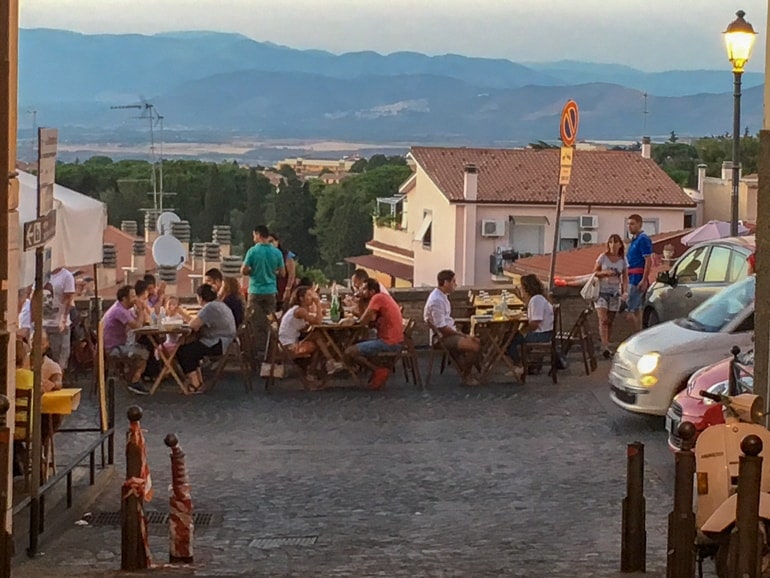
Recommended by Annabel from Smudged Postcard
If you’re visiting Rome in the summertime and you’d like a break from the city heat, hilltop Frascati is a quick and easy day or evening trip by train from Italy’s capital.
In Frascati , once the sun sets (which it does in quite a magnificent fashion), unassuming street corners are transformed into eateries and diners flock in.
Some places serve just food while others, the cantine (wine cellars), serve just wine so you’re welcome to bring your own drinks or your own dinner.
People buy food from one of the many porchetta stalls where all manner of pork products, a regional speciality, are on sale.
Takeaway pizza is also popular and it’s all washed down with litres of the local Frascati white wine.
Hilltop Frascati is buzzing during summer weekends: families and friends come together for an evening passeggiata through the elegant streets: it is the perfect antidote to Italy’s hot and busy capital.
We enjoyed staying in Frascati during the summer and visiting Rome for the day, but plenty of people do the opposite and visit Frascati for dinner before heading back to the city (30 minutes by train).
If you’re visiting Rome in the summer with children, nearby volcanic Lake Albano is the perfect place for a refreshing swim.
The Markets of Palermo
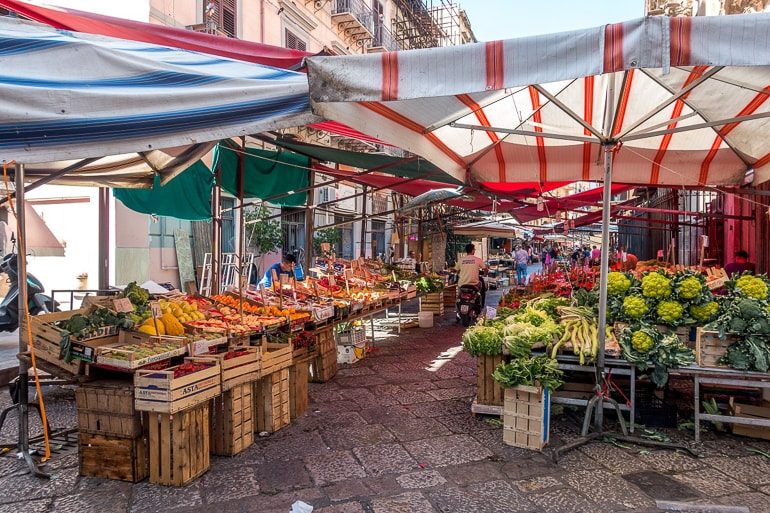
Recommended by Lance & Laura from Travel Addicts
The Italian city of Palermo is the capital of the state of Sicily. It’s also one of the most popular destinations in Italy. With a rich history, beautiful architecture, and delicious food, Palermo makes one of the best cities to visit.
Palermo is most known for the historic Arab-Norman Cathedrals – gorgeous houses of worship that blend Catholic, Islamic, Jewish and Byzantine elements.
However, between the cathedrals and tucked in the narrow lanes of the old town is Palermo’s real highlight: the markets.
Being closer to Africa than most of Europe, Palermo’s markets feel more like bazaars and souks than the food markets of Europe.
Many European markets feel like made-for-tourist experiences, but in the Ballaro, Vucciria, and Capo markets of Palermo, you’ll rub shoulders with locals.
No visit would be complete without experiencing the city’s local cuisine in the markets. There’s sfincione, a half-loaf of focaccia bread with olive oil, crushed tomatoes, and onions.
This is the dish that inspired Sicilian pizza. There’s pane e panelle – deep-fried chickpea fritters. And there’s crocche – fried potato croquettes. Eating your way through Palermo’s markets is one of the best places to visit in Italy.
Colonna Palace in Rome
Recommended by Tom from Travel Past 50
Palazzo Colonna stands out from almost every other historic Roman church, museum, or palace because it is still a private residence.
It’s open with limited visiting hours, but four Colonna brothers and their families still live in the palace.
In the 13th Century, a Count from outside of Rome settled on this property which then encompassed all the Quirinal Hill, ruins of the giant Serapis Temple, and Trajan’s Column.
In the ensuing years, the family’s land and importance increased through marriage, acquisition, ties with the church, and political and military successes.
While following the Colonna family history through the centuries, visitors can admire the important art collection and architectural developments of the Colonna Palace.
The collection’s prized pieces include Bruegels (younger and elder) in a roomful of Dutch paintings and a wealth of 15th through 18th Century depictions of Italy.
The art collection is enhanced by magnificent marble floors and impressive Baroque furnishings. The Pavilion Room showcases intriguing grotesque-style paintings hearkening back to ancient times.
The private chapel reveals the personal religious practices of the family, and the throne room is arranged not for princely audiences, but for papal visits.
The statue-lined Great Gallery Hall features an exception trompe l’oeil ceiling.
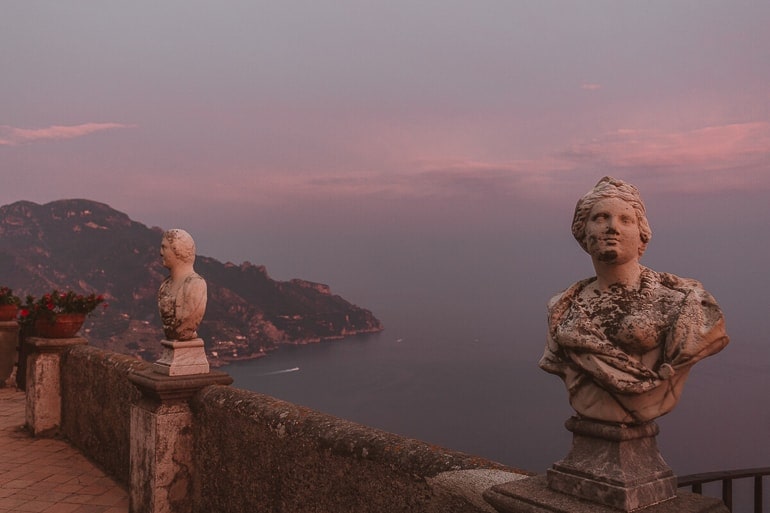
Recommended by Laura from What’s Hot?
Ravello is a lesser-known Italian town that you need to add to your itinerary if you’re visiting the Amalfi Coast.
It sits high above the coastline and its extraordinary beauty has earned it UNESCO World Heritage status.
Think small cobbled streets, authentic local Italian cafes, plazas with small churches, and the sea right at your feet.
It’s a small town so it’s very doable in as a day trip or even just an afternoon. There are a couple of beautiful churches and sanctuaries worth checking out but the crown jewel is Villa Cimbrone.
This stunning villa dates back over a thousand years and you’ll feel like you’ve gone back in time.
The Villa’s terrace, Terrazzo dell’Infinito (Terrace of Infinity) looks over the sea and is bordered by ancient statues. If you can visit at sunset, you’ll be in for a romantic treat as the pink sunset from here is one of the most beautiful I’ve ever seen.
If you’re staying down by the sea on the Amalfi Coast then you’ll want to get the bus up here.
It is possible to walk from one of the towns below, such as Minori, but whilst the path is not long in terms of distance, it is very, very steep.
I would recommend walking your way down though as the views are stunning!
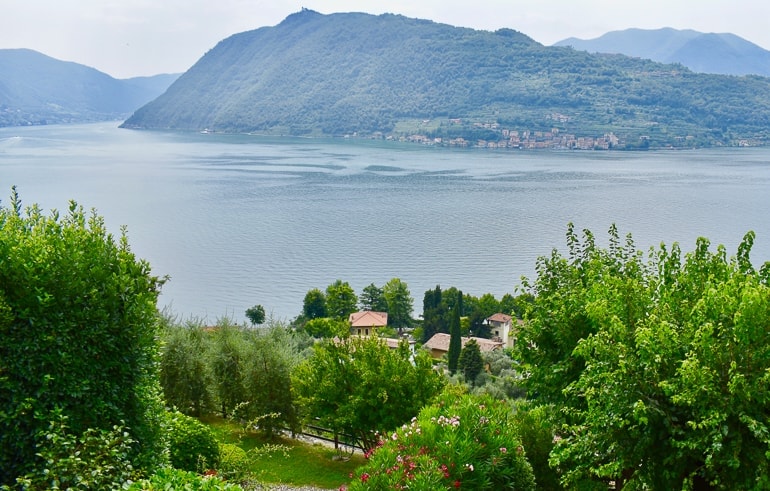
Recommended by Sherrie from Travel By A Sherrie Affair
The Italian lakes are known throughout the world; however, many are only familiar with Lake Garda, Lake Como, and Lake Maggiore.
Lago d’Iseo is the 4th largest lake in Italy and is located close to Lake Garda, only one and a half hours from Milan, two and a half hours from Venice.
Cool, beautiful water with mountain views makes this lake in Italy a perfect place to visit or live.
Our experience of seeing Lago d’Iseo for the first time was love at first sight. Lago d’Iseo is not as touristy as the other lakes.
It is surrounded by the Franciacorta wine region and with views that are spectacular! In the middle of the lake sits an island called Mont Isola, Europe’s largest lake island.
Voted the 3trd best European destination for 2019, this island is only accessible by boat but filled with fun villages to explore.
Lago d’Iseo has relaxing restaurants and shopping that surround the island in several different villages. The drive around the entire lake is fun with winding roads and tunnels through mountains.
Hikers will love the challenge of hiking by using the old Roman pathway and seeing the magnificent views.
Lago d’ Iseo is often referred to as the pearl of Italy and we discovered and love its beauty, so much we decided to purchase a villa ourselves!
Civita di Bagnoregio
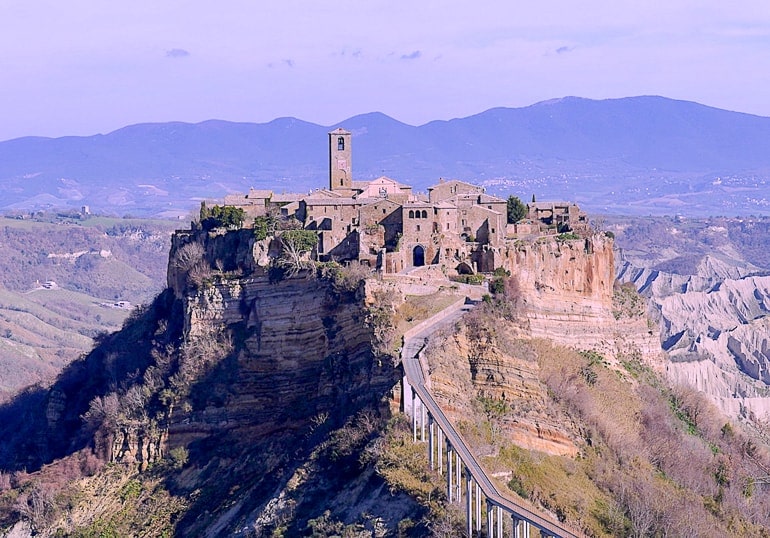
Recommended by Annalisa from Travel Connect Experience
Civita di Bagnoregio is a tiny town in Central Italy in between the regions Toscana and Umbria. The city has about 2500 years of history, but today counts only ten dwellers.
Geological studies are controlling the slow and continuous hollow of the ground which gained the town the name “the fading city”.
Civita rises dramatically on a tuff spur in the middle of a valley of typical clay rocks called “calanchi”, and it’s said to have inspired Japanese illustrator Miyazaki’s hanging city “Laputa”.
To reach the city walls, you’ll have to walk on a 300 mt long bridge which builds anticipation for what you will see inside the only gate.
The medieval town is perfectly preserved and offers breathtaking views of the surrounding valleys.
You’ll have the feeling you are strolling around an abandoned city, even if there are a few restaurants and shops, a church, and two museums.
You can get there taking a train to Viterbo or Orvieto and the public bus “Cotral” to Civita di Bagnoregio. The entrance fee is around €5. This destination can be a day trip from Rome .
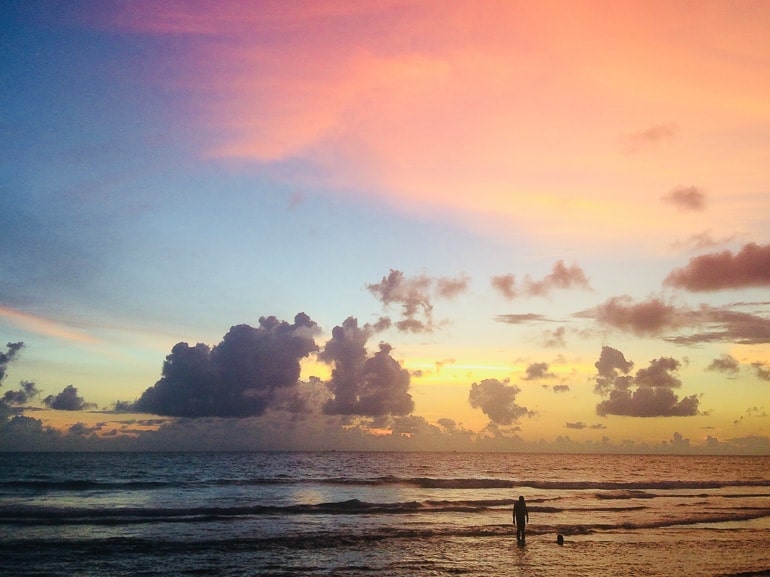
Recommended by Louis from The Northern Boy
Do you want to visit one of the most awesome places in Italy – Lake Garda. This stunning lake in Italy is one of the most stunning locations I ever saw.
It is probably one of the most popular places to see in Italy and it’s no wonder with its picturesque setting.
I spent 4 nights in Lake Garda attending a wedding in what was a surreal setting. Also, I can say I got to see some of the best things of what Lake Garda offers.
If you’re visiting Lake Garda, my recommendation is to stay at one of the Euro camps. It’s the cheapest and most fun. It’s also perfect for those of you on a family holiday.
Whilst staying on this epic lake in Italy, you have to drive around the amazing roads and discover some of the history this region offers.
All around the lake you can find little villages that have unique settings and places to visit. For example, you could find yourself visiting an ancient church or one of the amazing restaurants dotted around Lake Garda.
My personal top tips are:
- Stay on a euro camp
- Visit here during summer
- Try and make your way to Lake Como
Things to Consider When Visiting Italy
Before you start trip planning, you should consider a few details for your trip – from weather and climate to language, currency, and more!
General Information About Italy
Italy is located in southern Europe – it’s a very long country shaped like a high-heeled boot.
Because of its unique shape and place in Europe, Italy has a bunch of different geographical features from the Italian Alps (mountains) in the north, tranquil lakes in the middle, and a drier, more rocky coast at the bottom as it enters the Mediterranean Sea.
Italy has a very long and fascinating history – with Ancient Rome having played a significant role in shaping the continent of Europe.
The language spoken in Italy is Italian – but you can get by with English in most tourist areas like Rome, Venice, and Florence.
However, it’s always good to take the time to learn a few simple words like hello – “Buongiorno”, please – “per favore”, thank you “grazie”, and goodbye “ciao”!
Today, Italy is part of the EU and the Schengen Zone. The currency used in Italy is the Euro which makes it easy if you are also travelling to other countries in the region!
Speaking of money, since Italy is so popular – do watch your pockets and your belongings when travelling.
There are lots of tourist traps to be aware of in Rome, Venice, and other popular centres (speaking from experience here).
Best Time of Year to Visit Italy
The answer to the question “What is the best time to visit Italy” is: it depends. It really depends on which places you plan to visit and what activities you want to do.
Italy is a pretty big country with various geographical differences between the north and south.
The best time to visit the Italian Alps in the north is different from the best time for Tuscany, the lake district or the Adriatic coast as it extends south into the Mediterranean Sea.
That said, the summer months from late May to the end of August are the peak time to visit most areas of the country.
The weather is generally consistently hot and sunny. However, while it’ll be nice outside, the crowds will be absolutely atrocious in the city centres.
Even smaller, popular rural towns and lakes will have their share of humans during these months.
We’d suggest (if you can) travelling in the shoulder season from March to mid-May and then again in September and October.
The weather (especially in the south) will still be warm and pleasant and the crowds will not be at their peak.
Obviously, if you want to ski in the Alps, then aim for January or March for the least precipitation but still cold temps and good conditions. Basically: summer in Italy is crazy busy. Period.
Getting Around Italy
If you aren’t staying in one place when you visit Italy, you’ve got options to get around the country. You could fly – but the countryside is beautiful and worth seeing!
That said, the trains in Italy are pretty good. You can learn about the train system, plan journeys, and book tickets at the official ItaliaRail website .
The country is also well-connected via buses – with FlixBus a top choice for cheap, safe, and reliable transport between larger centres.
If you want to have the freedom to roam, you might consider renting a car in Italy and driving yourself across the country. Driving is done on the right and the highways are pretty good to get you large distances in a hurry.
Smaller, more rural and country roads are also good – but as in lots of countries, the smaller, more “off the beaten path” you get, the less reliable the roads can be.
Once you are in a city, you might take the public transport system to get around – and each city has unique ways to get around.
In Venice, you can make use of the water taxis . In Rome, you might opt for more of a hop-on hop-off bus ticket to get around and learn as you go.
You might be best just wandering on a walking tour to explore the Colosseum and the city !
Accommodations In Italy
If you are looking for places to stay in Italy, you will certainly have your pick!
The country is full of a healthy mix of hotels, guesthouses, apartments, hostels, private villas, and more. It really depends on where you are looking to stay.
Many cities specialize in hotels while the more rural areas or areas by the lakes or coast have holiday apartments and villas for rent. To each their own!
If you are planning a trip to Italy, you can check for accommodations in Rome , Florence , Milan , and Venice – just to get you started.
You might also be looking to backpack around the country and stay on a tighter budget, in which case you can find hostels in Italy here .
In a post on unique hostels across Europe, you can read about a recommended B&B hostel – Mosi Firenze , which is located in Florence!
And there you have it – a rundown of some of the top attractions in Italy! In the end, the country is loaded with amazing sights, attractions, towns, and vibrant cities.
It can be overwhelming to plan a trip! Just keep in mind your interests and your timelines and we have no doubt that you will put together an Italian trip that works perfectly for you!
- Compare flights on Skyscanner
- Check for Hotel Deals or Book A Hostel
- Get A Rental Car (depending on the destination)
- Research plug types and possibly get a travel adapter
- Go over our packing list
Pin it for later!
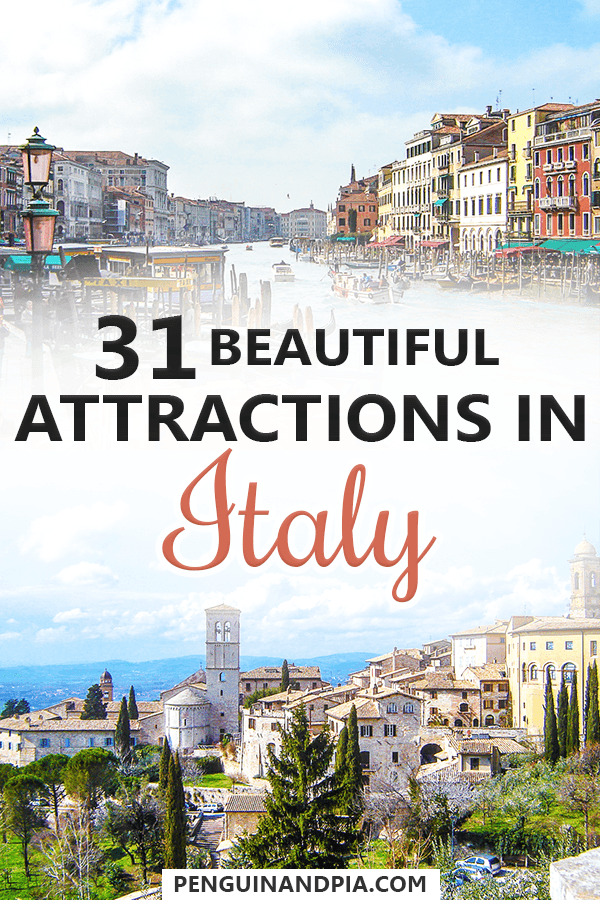
As an Amazon Associate we earn from qualifying purchases.
Destinations
Privacy policy
Disclaimer & Affiliate Disclosure
Terms of use
© 2024 Creativlier Media Inc.

- Chat with us
- +44(0)20 86660407
- [email protected]

Italy Destinations – Top 10 Tourist Attractions in Italy
“Dolce far niente!”… Well, when you arrived in Italy, please stop for 5 minutes and admire the beauty of everything that surround you, famous shopping streets, natural reserves, alpine lakes, beautiful beaches, breathtaking monuments which are included in the UNESCO World Heritage Sites, fine dining and culture… you’ll feel like you stepped off the roller […]
“Dolce far niente!”… Well, when you arrived in Italy, please stop for 5 minutes and admire the beauty of everything that surround you, famous shopping streets, natural reserves, alpine lakes, beautiful beaches, breathtaking monuments which are included in the UNESCO World Heritage Sites, fine dining and culture… you’ll feel like you stepped off the roller coaster’s life. ?
It’s not easy to make a top 10 of tourist attractions in Italy, but we hope in this article we’ll cover the most amazing popular sights for a charming holiday in Italy. Let’s explore the Italy’s map!
10. The Island of Capri
Here, you can arrived only by ferry, with departures from Naples or Sorrento . The top attraction of the Capri Island is Grotta Azzura , a few minutes journey and you will enter into the magnificent BLUE world! Capri is the perfect place for those who want a relaxing holiday, stylish atmosphere, a mixture of beautiful scenery, culture and history, all wrapped in a mild climate.
9. Grotta Palazzesse
Situated on the cliffs of Polignano a Mare, 30 km from Bari (Apulia), Grotta Palazzesse is one of the top restaurants in the world for its extraordinary location. If you want to make a stunning surprise to your lover, come here together and impress him with a romantic dinner in the sound of waves for an unforgettable experience.
8. Lake Como
7. leaning tower of pisa.
Leaning tower of Pisa is the most famous tilted building in the world with a height of 56 meters and a weight of 14,453 tons. It’s very funny when you see how people are trying to support the tower for making an amusing picture. J Due to poor quality of soil, the tower began to lean towards the south-east. In December 2001, the tower has been declared stable and secure for 300 years, reopened for public access.
6. Cinque Terre
A holiday in Cinque Terre is like a trip back in time… ancient architecture, pastel facades, slightly discolored, flowers, local people that seems to expect something quiet. The “Five Lands”, included in the UNESCO World Heritage Sites, are recognized for their beauty and especially for the stubbornness “in fighting with modern times”. The famous resorts of Portofino and Santa Margherita Ligore as well as the sandy beaches of Viareggio and Versilia are within easy reach.
Pompeii was a Roman city near Naples, in the Italian region of Campania. Following the eruption of Vesuvius in AD 79, the city of Pompeii was destroyed and covered by a thick layer of ash and pyroclastics. Pompeii was rediscovered in 1748 by chance, after first Herculaneum, another village destroyed by the same eruption of Vesuvius, was discovered in 1738. Archaeological research has revealed a huge amount of detailed information about urban life in the Roman Empire. Today, Pompeii is one of the most important attractions of Italy.
4. Florence
When you look at the architecture’s city, you’ll see the excellence of builindings, the art of the great masters from Michelangelo to Leonardo da Vinci, the magical atmosphere which will captive your heart. Take a morning dip in your pool and explore the beauty of this town… will exceed your expectations.
3. Roman Forum, Colosseum
The Roman Forum was the center of political life in the Roman Empire, evidenced by many remains, temples and churches: Temple of Saturn, Temple of Vespasian and Titus, Basilica Aemilia, Forum Main Square, Basilica Iulia, Temple of Caesar, Regia, Temple of Castor and Pollux, Temple of Vesta. Just one of these amazing Italy destinations. Each of these relics has its own history, which makes the Roman Forum a place where you really need to get here if you are on vacation in Rome and interested in Roman civilization. Also, Colosseum remains the beauty of Antiquity and the most impressive building of the Roman Empire.
2. Amalfi Coast
This is the perfect location for those who want to admire the beautiful views of the surroundings and catch the Mediterranean sea breeze. The nearest town is Sorrento , ideal for a passeggiata , an evening promenade before dinner and an excellent starting point for your journey. Do not leave the town without trying limoncello , a traditional liquer made from the peel of lemons. Beware! It contains at least 35% alcohol, so do not overdo it! J This drink can be enjoyed after a delicious dinner in one of the restaurants which offers you a spectacular view over the bay, Vesuvius, Capri and Naples, one of the remarkable attraction that can be admired in Italy.
Can you imagine a great lunch with a view like this? Romantic gondolas, palazzi , ancient bridges, monuments and a glass of white wine for a special atmosphere. Venice is the gem of any tour in Italy! For the art lovers, the Peggy Guggenheim Collection is not to be missed; located inside the Palazzo Venier dei Leoni, it holds important artworks from the 20th Century. Nearby are other important museums, such as the Galleries of the Accademia and Ca’ Rezzonico.
If you wish to experience breathtaking sunsets, spectacular views, perfect moments and ancient monuments, escape to Italy this year and visit one of the 10 tourist attraction listed above. Start with… what your heart says!
TOURIST MAKER
- Travel Guides »

100 Best Places to Visit in Italy
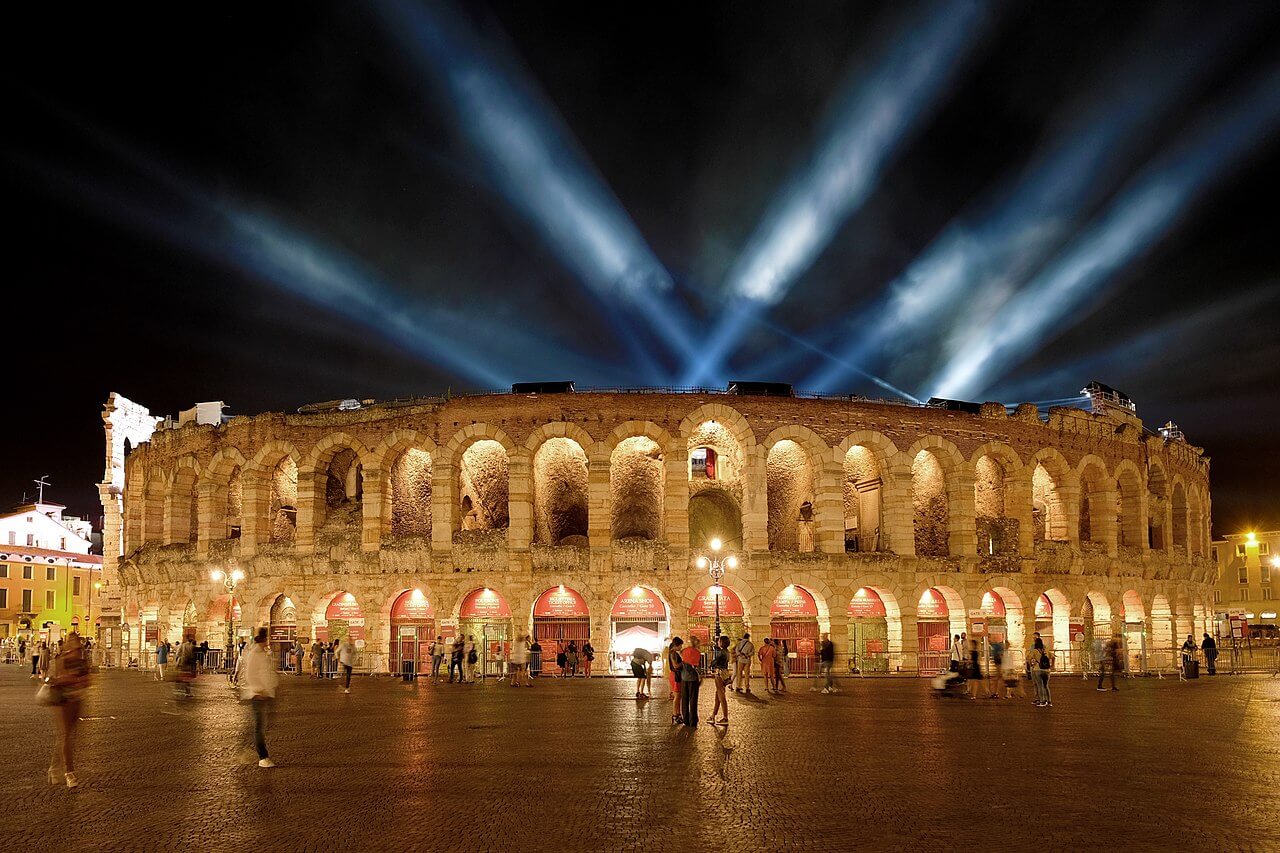
Italy is known for its rich history, beautiful architecture, ancient historical monuments, uniquely delicious cuisine and superb climate.
Not surprisingly, in 2019, it is among the five most visited countries in the world.
The only problem is that a short vacation is not enough to see all the beauties of the Apennine country.
To make you better prepared for your adventure, we have selected 100 of the most exciting places to visit:
1. Tropea (Calabria)

If you travel to Calabria, Tropea (6,462 residents) is a must visit place.
It was founded in antiquity, approximately 2000 years ago. In addition to its fantastic traditional cuisine, it is famous for its beautiful golden sandy beaches and azure sea.
The Old Town is a scenic place, built on the steep coastal cliffs.
One of the most important landmarks in the town is Cattedrale di Maria Santissima di Romania, built in the 12th century.
While here, you can join a boat trip to the Aeolian Islands, included in the UNESCO World Heritage List.
2. Gallipoli (Apulia)

Gallipoli (20,604 residents) is a charming town in the southeastern part of Italy.
It lies on the quiet west coast of the “heel” of Italy’s “boot”.
Gallipoli is known for its beautiful golden beaches and clear turquoise waters.
They are among the most attractive not only in Puglia (Apulia in English) but in Italy as a whole.
The beaches attract visitors from late April till late October.
The biggest attraction is the Old Town, located on a small island just off the coast. It is connected to the mainland coast by a convenient bridge.
The Old Town is known for its narrow and shady cobbled streets as well as for its low white two- and three-story buildings.
3. Porto Cesareo (Apulia)

Because of its fantastic white soft beaches and azure shallow waters, Porto Cesareo (5,448 residents) is one of the top destinations to spend your holidays in the South of Italy.
Together with Sicily, the region of Apulia experiences the longest and warmest summers in the country as well as the most enjoyable and mild winters.
Porto Cesareo is known for its almost tropical lifestyle. After a long day on the beach, you can enjoy your vacation, relaxing with a glass of outstanding Italian wine and fantastic Mediterranean food in some of the cozy restaurants in the town.
4. Termoli (Molise)

Molise is one of the lesser known regions of Italy but it is deeply recommended to visit.
The most attractive place in the region is the beautiful coastal town of Termoli, which is known for its 12th century Romanesque cathedral as well as for its pristine Blue Flag golden beaches.
Since the region of Molise is quite small, you will be able to easily explore some of the other lovely small towns in the vicinity.
The most recommended are Campobasso (known for the majestic medieval Monforte Castle) and Isernia (known for its astonishing cathedral).
5. Gran Sasso e Monti della Laga National Park (Abruzzo)

Located on the Adriatic coast of Central Italy, the region of Abruzzo is well-known for its outstanding natural beauty.
Most of the region’s territory is protected within wildlife sanctuaries and national parks.
Gran Sasso e Monti della Laga National Park is one of the most beautiful.
Established in 1991, it covers approximately 2,014 km 2 (778 mi 2 ) and is considered one of the largest in Europe.
It is known for its alpine landscape, snow capped mountain ridges and deep glacial valleys.
Here you can find a number of species of wild animals, including wild boars, foxes, wolves, brown bears and many others.
6. Eremo di San Domenico (Abruzzo)

Exploring the beautiful and unspoiled region of Abruzzo, don’t miss to stop by Eremo di San Domenico.
The hermitage is situated at the foot of a cliff, not far from the village of Villalago.
The small building was completed during the 10th century. Since then, the stone structure has remained practically unchanged.
7. Giulianova (Abruzzo)

The small coastal community of Giulianova (approximately 24,000 people) is located in the northern part of the region of Abruzzo.
Being a popular holiday destination, it is known for its beautiful architecture, tempting coastal promenade, busy yacht marina, lovely golden beaches and fantastic restaurants.
The modern Giulianova was established during the 15th century, while the first settlement in the area dates from the 3rd century BC.
8. Perugia (Umbria)

Known for its incredible culinary heritage (the chocolate, for example), Perugia is a city that should definitely be on top of your bucket list.
Founded in the 4th century BC, the city acquired its current appearance in the 13th century.
Today you can enjoy some of the most preserved medieval stone-paved streets in Europe, at least if you visit the old part of the city.
Among the major tourist attractions are the beautiful Perugia Cathedral (Cattedrale Metropolitana di San Lorenzo, completed in the late 16th century) and the medieval church of San Pietro.
9. Gubbio (Umbria)

Gubbio (34,000 residents) is located in the northern parts of Umbria.
It is dominated by 14th and 15th century buildings. Most of its medieval stone-paved streets have remained practically unchanged since the medieval period.
The town is known for the seven bronze Eugubine Tables, which were discovered here in 1444.
10. San Marino

Although at first glance San Marino looks like a not very big city, it is actually an independent state, which is also the third smallest in Europe after Monaco and the Vatican City State.
It consists of a few small towns, the biggest of which is the capital city San Marino.
It is situated at the foot of a mountain, and according to travelers, it is one of the most beautiful and well-preserved cities in Europe.
Established on September 3, 301 AD, the microstate is considered the oldest republic in the world.
It has a population of 33,785 residents (as of 2018), about 4,071 of which live in the capital.
San Marino is known for its incredible castles, the most impressive of which is Fortress of Guaita, situated on top of a mountain. The fortress was designated as a UNESCO World Heritage Site in 2008.
11. Polignano a Mare (Apulia)

Polignano a Mare (18,024 residents) is a very beautiful small town in the region of Apulia.
It lies on the southeast coast of Italy, in the metropolitan area of the city of Bari.
It is known for its fantastic bars and restaurants, souvenir shops and historical buildings, but mostly for the cozy Cala Paura Beach.
Nestled between the coastal cliffs of a narrow cove, it is known for its turquoise waters.
It is covered with a mixture of large grain golden sand and small pebbles.
The beach is one of the most beautiful in the area but is often too crowded in summer.
12. San Giulio Island (Piedmont)

One of the most recommended spots in the North of Italy is Isola San Giulio (or San Giulio Island).
You will find it within Lake Orta, only about 400 meters off the east coast of the lake.
Despite its small territory (it is only 275 meters or 902 feet long), the island offers a number of places to visit and see.
Here you can see dozens of beautiful historical stone buildings, the most popular of which is the basilica San Giulio. Built during the 12th century, it is well-known for its lavish interior decoration.
13. Arena di Verona (Veneto)

Completed in 30 AD, Arena di Verona is one of the world’s best examples of an ancient amphitheater.
Situated in the very heart of the city, the majestic Roman structure is very well preserved and still welcomes visitors (up to 15,000 people).
Every summer numerous opera performances and concerts are held here.
14. Noto Cathedral (Sicily)

Completed in 1776, the Minor Basilica of St. Nicholas of Myra (better known simply as the Noto Cathedral) is among the most beautiful religious temples in Italy.
It is known for its wonderful Sicilian Baroque architecture and pale elegant limestone facade.
One of the most dramatic events in the history of the cathedral was its sudden and unexpected collapse on March 3, 1996. 11 years later, the beautiful structure was completely restored. It was officially reopened on June 15, 2007.
15. Porta Sempione (Lombardy)

The Arch of Milan, officially known as Porta Sempione, is one of the symbols of the leading economic center in Italy.
Completed in 1838, the neoclassical triumphal arch is impressive. It is approximately 25 meters high (more than 82 feet) and nearly 24 meters wide (almost 79 feet).
It is located not far from the largest and most beautiful city park of Milan – Parco Sempione and the wonderful Sforza Castle.
16. Villa Aldobrandini (Lazio)

Villa Aldobrandini is located on the outskirts of the small and beautiful town of Frascati in the region of Lazio, not far from the bustling and lively Italian capital.
The villa, which is actually a not very large but extremely elegant palace, was completed in the second half of the 16th century and is well known for its lush gardens.
17. Villa Torrigiani (Tuscany)

Villa Torrigiani is located in the picturesque countryside of Toscany, on the outskirts of the small town of Lucca.
The small palace in the late Renaissance style is among the most beautiful and recommended places to visit in the region.
Completed in the second half of the 16th century, the building is distinguished by its multicolored facade, which is a result of the variety of building materials used in the process of construction.
18. Villa Cimbrone (Campania)

Villa Cimbrone is one of the major sights of the beautiful Amalfi Coast in the Campania region.
Built in the 11th century, the building is a complex mix of influences and architectural styles from around the world, making it even more special.
Complemented by elegant gardens that are open to the public, the building today serves as an elegant hotel.
It is located high above the topaz-blue waters of the Mediterranean Sea, on the outskirts of the small town of Ravello.
19. Villa San Michele, Capri

Villa San Michele is the major attraction on the small and beautiful Italian island of Capri.
Built in the traditional Caprese architecture in the late 19th century, it is famous for its elegant beauty and lush gardens.
As it is situated 327 meters above sea level, the villa reveals breathtaking views of the entire island. It was built by the Swedish physician Axel Munthe.
20. Villa Rufolo

Known for the exceptional beauty of its gardens, Villa Rufolo was built in the 13th century and later completely renovated in the 19th century.
It is popular for its Moorish architectural style, and nowadays, it is considered one of the most unique and beautiful in Italy.
It is located in one of the highest parts of the town of Ravello, so it reveals a stunning view of the Amalfi Coast.
21. Villa d’Este

In the countryside of Lazio, not far from the cosmopolitan capital of Italy, you will find a lovely small town which enjoys the reputation of being one of the most beautiful in the region.
Its name is Tivoli, and it is known for one of the most sophisticated Italian villas.
Villa d”Este was completed in the late 16th century. As a real architectural masterpiece, this wonderful little palace was listed as a UNESCO World Heritage Site in 2001.
Villa d”Este is known not only for its late Renaissance mannerist architecture but also for its wonderful gardens, which are considered among the most beautiful in Europe.
22. Cappello di Venere (Campania)

Cappello di Venere is a beautiful waterfall in southern Italy.
It is located in the south-eastern parts of the region of Campania, on the outskirts of the small town of Casaletto Spartano.
As it is nestled amidst lush vegetation, the area of the waterfall offers a very good opportunity to escape the summer heat in the South.
Cappello di Venere (the Hair of Venus in English) is one of the most relaxing spots in Campania, and in addition, it is easily accessible from the town within a few minutes walking.
23. The Bridge of Angels (Lazio)

The Bridge of Angels (or as it is better known in Rome as Ponte Sant’Angelo) is one of most beautiful bridges across Europe.
Approximately 135 metres (443 ft) long and 7 metres (23 ft) high, it was completed in 123 AD by Emperor Hadrian.
The pedestrian bridge is decorated by 10 wonderful sculptures of angels, all of them unique and different from each other.
24. Genoa Cathedral (Liguria)

Cattedrale di San Lorenzo is one of the most recommended architectural monuments to visit in Italy.
Located in the old part of Genoa, not far from the harbour, it was built in the early 12th century and consecrated in 1118.
Its majestic bell tower was built in the 16th century.
The medieval structure combines elements of Mannerist, Gothic and Romanesque architecture styles. It is famous for its rich interior, elegantly decorated ceiling and unique frescoes.
25. Camogli (Liguria)

Blessed with a wonderful Mediterranean climate, Camogli is a small tourist town with an ancient history.
It is located on the Golfo Paradiso on the Italian Riviera, not far from the cosmopolitan center of Genoa.
Today Camogli has a population of about 5,332 residents and is a real magnet for tourists during the summer season.
It is famous for its lively marina, colorful houses, silver pebble beach, azure sea and emerald mountain slopes.
26. Palatine Hill (Lazio)

Located in the very heart of one of the most ancient cities in the world, Palatine Hill is the birthplace of the Roman Empire.
Today it is one of the most visited parts not only in Rome, but in Europe and in the world.
The Palatine Hill is extremely rich in ruins of ancient buildings and is a real open-air archeological museum.
Most of the ruins are of buildings completed at various stages in the 1st millennium BC.
Right next to the Palatine Hill is the Arch of Constantine. It was built by order of Constantine I. Completed in 315 AD, its construction took 3 years.
Being one of the most visited triumphal arches in the world, it attracts approximately 7 million visitors per year.
27. Levanto (Liguria)

Levanto is a small community with a population of about 5,597 residents.
Nestled among the emerald green coastal hills of Liguria, the town is a very attractive place during the summer months.
Numerous music festivals are held here every year from June to September.
One of the main attractions for tourists is the church of Sant’Andrea, which dates from the 13th century. Part of the municipality falls within the Cinque Terre National Park.
28. Portovenere (Liguria)

With a population of only 3,763 people, Portovenere is among the most ancient towns in Liguria.
It was founded in the 1st century BC and is a great example of the beauty of the famous Italian Riviera.
In 1997, Portovenere (along with several small neighboring towns) was included in the UNESCO’s World Heritage List.
It is easily recognizable by its colorful buildings, painted in yellow, orange, peach and other warm shades.
29. Pantheon of Rome (Lazio)

The Pantheon of Rome is an ancient temple completed in 125 AD.
Today, this majestic structure serves as a Catholic church under the name Basilica of St. Mary.
The construction of the Pantheon of Rome began during the reign of Emperor Trajan and was successfully completed during the rule of Emperor Hadrian.
An interesting feature is the oval opening in the ceiling, which has never been covered. Since the structure has no windows, this is the only source of daylight.
30. Doge’s Palace (Veneto)

Doge’s Palace is an elegant Venetian palace that has significantly contributed to Venice’s reputation as an elegant, refined and romantic place.
Completed in 1340, it is located on the legendary Piazza San Marco, in the lagoon of Venice.
The building is famous for its Gothic architecture and is among the most significant landmarks of the city.
31. Piazza Navona (Lazio)

Built in the 1st century AD, Piazza Navona is one of the most famous and visited squares in Rome.
Its popularity as a city center grew in the 15th century, when the city market moved here.
Today the square is famous for its two elegant fountains, created in the 16th century – Fontana del Moro and Fontana del Nettuno (the fountain of Neptune).
32. Trieste Lighthouse

Constructed in 1927, Trieste Lighthouse is one of the most visited landmarks in the Adriatic city.
Vittoria Light (its official name) is a 67.85 meters (222.6 ft) tall stone tower, which ranks among the top ten tallest in the world.
A former stone fortification serves as a foundation of the lighthouse.
On top of the structure you can see a beautiful bronze sculpture, which symbolizes the victory of Italy in World War I.
33. Santa Margherita Ligure (Liguria)

Santa Margherita Ligure is a small coastal town that enjoys a great popularity with tourists.
It has a population of only 9,639 people, but during the summer season it seems much more busy and lively.
The place is known for its traditional appearance and old buildings, its beautiful port and irresistible Mediterranean atmosphere.
34. Portofino

Nestled on the emerald coast of Liguria, Portofino is a very small town (only 439 residents) which enjoys tremendous popularity with tourists.
Known for its lovely weather and beautiful historical building, it is a magnet for visitors during the summer season.
The best time to visit Portofino is between early June and early September.
The town is a good choice for yacht-sailors as it offers a very cozy and comfortable yacht marina.
35. Madonna della Corona

If you aren’t afraid of some additional walking and climbing, Madonna della Corona (a beautiful monastery, completed in 1664) is absolutely a must for your trip.
The sanctuary is located in the region of Veneto, approximately 28.6 miles (46 km) north of the city of Verona.
The catholic monastery is nestled amidst the steep rocks, 774 meters (2539.37 ft) above sea level.
The route to the monastery passes through a very beautiful forested area. It usually takes about 2 hours and includes more than 1,500 steps to get there, although there is also a bus available, which makes the trip to the monastery much easier.
36. Assisi (Umbria)

Located in the heart of Umbria, the city of Assisi (28,299 people as of 2016) has been permanently inhabited for the past 3,000 years.
Due to its countless unique architectural monuments, Assisi was designated a World Heritage Site by UNESCO in 2000.
The most important local landmark is the Basilica of Saint Francis of Assisi, which was consecrated in 1253.
37. San Felice Arch

San Felice Arch (or Arco di San Felice in Italian) is a natural rock formation on the Adriatic coast of Italy.
You will find it not far to the south from the city of Vieste, at the bay of San Felice.
The area is known for its wonderful golden beaches and smooth sea waters so you can take advantage of the walk to the arch and to take a dip in the sea at some of the neighbouring beaches.
38. Sassi di Matera (Basilicata)

We often associate Italy with old and even medieval buildings, but what the charming ancient city of Matera has to offer is beyond our expectations.
Sassi di Matera are two very interesting historical districts that are well-known for their Paleolithic cave dwellings.
Approximately 9,000 years old, some of the dwellings were inhabited until the mid 20th century.
However, the lack of electricity and running water forced the last residents of the ancient settlement to leave their homes.
39. The Ancient Amphitheater of Taormina (Sicily)

The Ancient Amphitheater of Taormina is one of the most emblematic and recognizable places in the South of Italy.
Mostly built of red bricks, it was completed during the 3rd century BC.
As it is situated on the top of a hill, the amphitheater reveals an incredible panorama of the entire city and the coast of Sicily.
40. Santa Caterina del Sasso Monastery (Lombardy)

Santa Caterina del Sasso is a beautiful Roman Catholic Monastery.
It is located in the region of Lombardy, on the east coast of Lago Maggiore, south of the small village of Reno.
The construction started as early as the 12th century but it was completed in the 19th century.
Built on the steep coastal cliffs of the lake, the monastery is easily recognizable for its beautiful Romanesque architecture.
41. Scaligero Castle (Lombardy)

Located on the south coast of Lago di Garda, Scaligero Castle is one of the most important tourist attractions in the area.
It lies on the shore of a narrow peninsula, in the old historical village of Sirmione.
Completed in the 13th century, the classic fortress is made of bricks and stones. It is very well-preserved and is considered the most visited in Italy.
42. Montepulciano (Toscana)

Because of its old historical buildings and car-free narrow cobbled streets, Montepulciano enjoys a great reputation of being a real traveler’s paradise.
Located in Toscana, it is home to only 13,984 residents. Montepulciano is a quiet traditional town, very pleasant to walk around and a wonderful place to spend a few days in summer.
It was established in the 6th century but the area has been permanently inhabited since the 4th century BC.
43. Cala Gonone (Sardinia)

Cala Gonone is a small tourist town on the east shore of Sadinia.
It is famous for its gorgeous white sandy beaches and for the top quality of its sea waters.
The biggest attractions, however, are its numerous coastal caves. While some of them are more easily accessible than others, they all deserve your attention.
One of the most beautiful of them is Bue Marino, which is accessible only by boat. Because of the small distance (it is approximately 3.5 km south of the city) it attracts many tourists during the summer season.
44. Spiaggia di Li Cossi

Nestled in a small and sheltered cove south of Costa Paradiso, Spiaggia di Li Cossi is considered one of the most beautiful beaches in Sardinia.
As it is situated on the north coast of the island, most visitors expect to find a quiet and secluded beach.
Most of the time, however, Spiaggia di Li Cossi is quite busy because of its soft sands and pristine waters.
Even so, it is deeply recommended to visit this wonderful place, to take a dip in its clear waters and to take a few pictures of the scenic surrounding landscape.
45. Ponte di Rialto

Ponte di Rialto is the most famous bridge spanning Canale Grande in Venice and is one of the most important tourist attractions in the city.
Constructed between 1588 and 1591, it is one of the longest and oldest bridges in Venice.
Approximately 31.80 metres (104.3 ft) long, its construction was a real challenge in the 16th century.
Despite the difficulties, today it is still one of the most important connections between San Marco and San Polo.
46. Giglio Island (Tuscany)

Giglio Island (1,426 residents) is a lesser known tourist destination.
Quiet and secluded even in summer, it is a great choice if you want to feel the real taste of Italy.
The island is easily accessible by boat as it lies only 10 km off the coast of Tuscany.
The main tourist attraction is the small harbour village of Portoferraio, which is known for its old buildings in bright and warm colours, such as yellow, pink, papaya, peach and many others.
47. Val d’Orcia

Val d’Orcia covers 61,188 ha (151,200 acres) in the countryside of Siena.
It is known for its traditional Tuscan landscape, dominated by green vineyards, rolling hills and tall cypress trees.
In 2004 the area was included in UNESCO’s World Heritage List because of its centuries-old villages and cultural importance for Italy.
The area is known for some of the best wines in Europe and is one of the most important gastronomical centers in the world.
48. Saturnia (Tuscany)

The small village of Saturnia (only 280 residents) is located in the countryside of Tuscany, not far from the town of Manciano.
The area is well-known for its hot sulphurous mineral springs, which have attracted visitors since ancient times.
The springs are considered to have a number of special therapeutic properties.
The moderate temperature of the water (around 37.5°C / 99.5°F) supports the nervous system and promotes relaxation.
49. Victor Emmanuel Monument, Rome (Lazio)

Constructed between 1885 and 1935, Victor Emmanuel Monument was built in honour of the first monarch of united Italy.
It is approximately 81 m (266 ft) high and is situated on Piazza Venezia, in the very heart of Rome. The monument is a mixture of Neoclassicism and Eclectic style.
50. Scala dei Turchi (Sicily)

Scala dei Turchi is situated on the sunny coast of southern Sicily, not far from Porto Empedocle.
The area is quiet and secluded, dominated by white and extraordinary looking white coastal cliffs. They strongly remind of a staircase, which explains the name of the phenomenon.
Scala dei Turchi is a candidate for UNESCO’s World Heritage List.
51. Amalfi (Campania)

On the steep scenic shore of Campania, not far from the city of Naples, lies the main town on the Amalfi Coast.
Amalfi Town has a population of approximately 5,100 residents but the number of tourists in summer is much bigger.
The settlement is known for its old buildings, small pebble beaches and limpid emerald waters.
In 1997 it was included in UNESCO’s World Heritage List.
The main tourist attractions here are Villa Rufolo and the incredible 9th century Cathedral, which is a complex mixture of architectural styles.
52. Cinque Terre (Liguria)

Cinque Terre covers approximately 4,511.54 ha (17.4192 sq mi) in south-east Liguria (the eastern-most part of the Italian Riviera.
It is considered one of the most popular upscale tourist destinations in Italy and is well-known for its five wonderful small coastal towns – Riomaggiore, Monterosso al Mare, Vernazza, Corniglia and Manarola.
The area is popular for its scenic coastline, lovely small silver beaches and emerald waters.
The biggest attraction, however, is the mixture of multicolored buildings in beautiful warm shades, situated directly on the rugged rocky coast.
The area is permanently inhabited at least since the 11th century.
It was included in UNESCO’s World Heritage List in 1997.
Because of its location, not surprising, Cinque Terre is a well-known gastronomic destination.
53. La Scala (Lombardi)

Opened in 1778, La Scala Opera House and Theater in Milan is one of the most famous opera houses in the world.
It is known for its fine Neoclassical architecture. The building was designed by the talented architect Giuseppe Piermarini (born on July 18, 1734 in Foligno, in the province of Perugia).
The opera house is situated on a square with the same name in the very heart of Milan.
54. Miramare Castle (Friuli-Venezia Giulia)

Trieste is a very beautiful city, and the most important tourist attraction here is the Miramare Castle.
It is an impressive 19th century building that was constructed by order of Ferdinand Maximilian of Habsburg.
The castle is situated amidst a wonderful coastal park (22 hectares / 54 acres).
Here you can see a great variety of exotic tropical plants from around the world.
55. Victor Emmanuel Gallery (Lombardi)

Milan enjoys the reputation of being one of the world’s fashion capitals.
One of the most prestigious shopping destinations and the oldest shopping center in the world is Victor Emmanuel Gallery.
Situated in the central part of Milan, it was completed in 1878.
Here you will find numerous upscale boutiques, cafes and restaurants.
The gallery is known for its entirely covered glass-and-iron ceiling, unique frescoes and for its sophisticated mosaics.
56. Milan Cathedral (Lombardi)

The Cathedral of Milan (Duomo di Milano) is one of the most remarkable buildings in Italy.
Situated in the very heart of Milan, it is 108 meters (354 ft) high and is a mixture between Gothic and Renaissance architecture.
Its construction started as early as 1386 but the building was completed in 1965. Bricks and marble are the main materials used in the construction of the Roman Catholic church.
The cathedral is the seat of the Archbishop of Milan.
57. Maremma (Toscany)

The beauty of Toscany is remarkable and the area of Maremma is a very good example.
Situated in the coastal part of the region, it covers approximately 5,000 km 2 (2,000 mi 2 ).
It is a mixture between forested lands, romantic countryside and coastal sceneries.
In the past the area of Maremma was mostly covered by marshlands which, however, were drained by order of Fernando I de Medici.
58. Sorano (Toscany)

If you travel around Tuscany, don’t miss to stop by the small town of Sorano (3,464 residents).
This is a lovely historical settlement in the southern part of the region, in the province of Grosseto.
Established around the 3rd century BC, the town is famous for its beautiful Orsini Castle.
Officially called Rocca degli Orsini, it was completed during the 14th century.
59. San Gimignano (Toscana)

San Gimignano (7,780 residents) is a small medieval town, situated not far from Siena, in the region of Toscany.
It is known for its impressive stone towers, protective medieval stone wall and for its centuries old buildings and narrow cobbled streets.
Dominated by Gothic and Romanesque architecture, the old part of the town was included in UNESCO’s World Heritage List in 1990.
60. Elba Island (Toscana)

Elba Island is one of the most beautiful places in Tuscany, and at the same time, it is one of the lesser-known tourist destinations in Italy.
Being the biggest one of all 7 islands in the Tuscan Archipelago, Elba is a mixture of old historical towns, sapphire-blue waters, and lovely beaches.
Founded in 1548, the most famous of all towns is the capital Portoferraio. The most popular tourist attraction is the lighthouse, which was built in 1548 too.
61. Santa Maria del Fiore (Toscany)

Santa Maria del Fiore, also known as the Florence Cathedral, is one of the most recognizable churches in the world.
It was completed in 1436 and is a mixture between Gothic and Renaissance architecture.
It is 114.5 metres (376 ft) high and is one of the largest cathedrals ever built.
It is known for its huge red-orange colored dome as well as for its 84.7 metres (277.9 ft) tall bell tower.
In 1982, Santa Maria del Fiore was included in UNESCO’s World Heritage List.
62. Spiaggia la Cinta (Sardinia)

Spiaggia la Cinta is a 3.5 km (2.18 mi) long stretch of superb white sand (one of the longest on the island).
Located in north-eastern Sardinia, it is one of the most popular beaches in Italy.
You will find it right next to the north of the coastal town of San Teodoro.
Because of its turquoise shallow waters, Spiaggia la Cinta is a magnet for visitors.
Despite its huge popularity, the central part of the beach is usually very quiet and secluded. It welcomes fewer visitors due to its more distant location and more difficult accessibility.
63. La Maddalena Archipelago (Sardinia)

La Maddalena Archipelago is located right off the northern coast of Sardinia.
It is known for its wonderful small coves, turquoise waters and cozy white-sand beaches.
It is a popular place for yachting, swimming, snorkeling and kayaking.
The islands offer some very cozy little towns and villages to visit.
The archipelago and the surrounding waters fall within the limits of Arcipelago di La Maddalena National Park, which was included in UNESCO’s World Heritage List in 2006.
64. Saint Mark’s Basilica (Veneto)

Saint Mark’s Basilica, officially called Patriarchal Cathedral Basilica of Saint Mark, is located at Piazza San Marco in Venice.
Completed in the 11th century, it is known for its unique appearance, which is the result of the mixture of Italian and Venetian Gothic architecture with strong Byzantine influence.
The belltower (Saint Mark’s Campanile) is very impressive too. It rises 98.6 metres (323 ft) above Piazza San Marco and was rebuilt in 1903.
65. Porto Pino (Sardinia)

Known for its white sandy dunes and crystal clear sapphire waters, Porto Pino is the best place to visit if you need a truly secluded and quiet beach.
The stretch of sand is enormous and in the eastern part you will easily find some place just for you and your family or friends.
As long as Italy is a very popular tourist destination, Porto Pino is a great example of how many wonderful unspoiled places are still waiting to be found.
66. Cala Mariolu (Sardinia)

Cala Mariolu is a fantastic secluded beach which is known for its crystal clear turquoise waters.
It is covered with a mixture of small white pebbles and white coarse sand.
It is quite difficult to reach as it lies at the foot of steep coastal cliffs on the east shore of Sardinia.
The easiest way to get there is to rent a boat in Cala Gonone, which lies 18 km north from Cala Mariolu.
67. Ponte Vecchio (Toscana)

Constructed in 1345, Ponte Vecchio is considered one of the most recognisable bridges in Europe.
Spanning the Arno River, it is one of the must-visit sights in the central part of Florence.
It is known for its extraordinary design that resembles an old traditional residential building.
From inside, the bridge is a popular shopping street. Here you can find galeries, work craft shops, jewelry and many others.
68. Spiaggia di Cala Pira (Sardinia)

Spiaggia di Cala Pira is one of the must-visit beaches in Sardinia.
It is located on the south-east coast of the island and is known for its white soft sands and sapphire-blue crystal clear sea.
As the coastal waters are quite shallow, the beach is very popular with people who travel with their kids.
The surrounding area is very quiet and sparsely populated so Cala Pira is rarely overcrowded, even if you travel in the height of summer.
69. Cala Goloritze (Sardinia)

Cala Goloritze is considered the most beautiful pebble beach in the world.
It is located on the east coast of Sardinia, not far from the mountain historical town of Baunei and to the north of Santa Maria Navarrese.
It is quite popular for its incredibly clear waters and underwater visibility of almost 50 meters in quiet and sunny weather.
Cala Goloritze lies at the foot of steep coastal cliffs which cast dense shade during the late afternoon hours.
70. Chia Beach (Sardinia)

Being one of the most preferred beaches in Sardinia, Chia Beach is known for its irresistible tropical appearance.
It is located on the southern tip of the island and is a mixture of shallow turquoise waters and snow white sands.
Although the entire area is known for its fantastic beaches and sapphire blue waters, Chia Beach is considered one of the best.
You will find it in the vicinity of the villages of Chia and Setti Ballas.
In addition to the beautiful view and soft sands, here you can also enjoy a lovely coastal lake, which attracts a number of waterfowl species.
71. Spiaggia di Porto Giunco (Sardinia)

Spiaggia di Porto Giunco is considered by many one of the most fantastic beaches in Italy.
It is situated on the southeastern coast of the island of Sardinia and is known for its irresistible soft white sands.
The water in the sea is crystal clear and really tempting because of its turquoise shades.
The beach attracts visitors between May and October, with the peak of the season between June and August.
72. Lake Church (South Tyrol)

If you are traveling around the region of South Tyrol, don’t miss to stop by the extraordinary Lake Reschen (or Reschensee).
The artificial lake was completed in the summer of 1950 and is 28 meters deep (almost 92 feet).
The lake is famous for the submerged church from the 14th century, whose belltower can still be seen above the lake surface.
73. Braies Lake and the Dolomites (Trentino and South Tyrol)

If you are planning to travel across the northern parts of Italy, the Dolomites should be one of the first places to visit.
Reaching 3,343 meters above sea level (10968 ft), parts of the mountains are former coral reefs (yes, surprisingly!).
Don’t miss to stop by Braies Lake which is one of the most beautiful lakes in the Dolomites in South Tyrol.
Being surrounded by wonderful pine forests and rugged mountains, it is a good choice if you want to escape the heat in July and August.
Although the water in the lake is too cold for swimming and bathing, it is a great choice if you are looking for a quiet place to enjoy some boating and finishing.
The view of the mirrored emerald water is almost therapeutic and walking around is a very good way to beat stress.
74. Lake Como (Lombardi)

Located in the Italian Alps, not far from Switzerland, Lake Como is the 3rd largest lake in Italy.
Because of its topaz blue waters, lovely historical villages and green mountain slopes, Lake Como is a wonderful place to spend your summer vacation.
Here you will find some of the most beautiful villas in the world, most of which are known for their outstanding Renaissance architecture and gorgeous tropical gardens.
75. The Roman Forum (Lazio)

In antiquity, the Roman Forum (an important public square) was the most significant place in the Roman Empire.
In modern times, you can still see the ruins of various government buildings scattered around the ancient public venue.
Most of the structures were built over a wide period of time between 8 century BC and 4 century AD.
As part of the Historic Center of Rome, the Roman Forum was included in UNESCO’s World Heritage List in 1990.
76. Capri Island (Campania)

Situated only 5.5 km (3.42 miles) off the coast of Campania in Tyrrhenian Sea, Capri is a popular tourist destination.
It attracts thousands of day trippers from Naples and other destinations in Campania every day but is also a prestigious place to spend your summer vacation.
Capri is a very green island that is known for its dramatic coastline, cozy pebble beaches and clear emerald waters.
The biggest attractions, however, are the Blue Grotto, the Gardens of Augustus and Villa San Michele.
77. Trevi Fountain / Rome (Lazio)

There is a saying that if you throw a coin into the Trevi Fountain in Rome, you will come back again one day.
The fountain was designed by the talented artist and architect Nicola Salvi and is considered one of the most remarkable landmarks in Italy.
Completed in 1762, it is known for its wonderful marble sculpture of Neptune.
78. The Colosseum / Rome (Lazio)

The Colosseum is probably one of the most popular monuments of the ancient world.
Its construction started between 70 and 75 AD during the rule of Emperor Vespasian and completed in 80 AD during the rule of Emperor Titus.
The giant structure, which could hold up to 80,000 spectators, was built as a gift for the Roman people and served as the most important entertainment venue in Rome.
This is where gladiator contests and other important public events were held.
79. Mount Etna (Sicily)

Located in the central part of Sicily, Mount Etna is 3,329 m (10,922 ft) high.
This is the highest active volcano in Europe (not counting the Teide volcano on the Spanish Canary Islands).
According to historical data, the volcano has destroyed dozens of towns and villages over the centuries.
In modern times, Etna is a popular year-round tourist attraction, with the peak of the visits in July and August.
80. The Spanish Steps / Rome (Lazio)
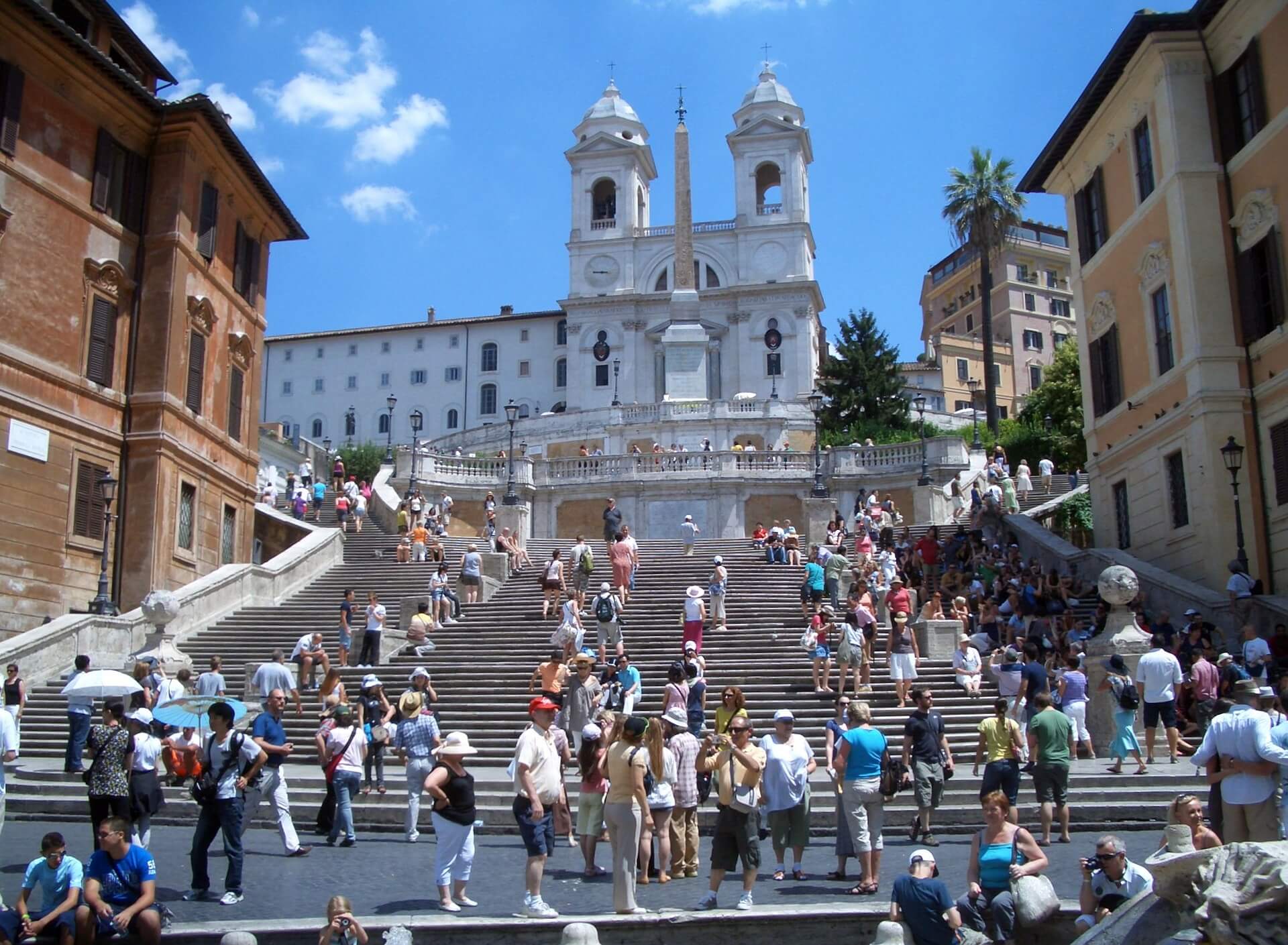
The famous Spanish Steps in Rome were constructed between 1723 and 1725.
The stairway consists of 135 steps and is situated between Piazza di Spagna (a beautiful small square) and Triniti dei Monti Church.
The project was funded by the famous French diplomat Étienne Gueffier.
It is important to know that tourists and locals are banned from eating and drinking at the steps for hygienic and aesthetic reasons.
The stairway was renovated between October 2015 and September 2016.
81. Lago Maggiore (Piedmont, Lombardy)

With a depth of 372 meters (1220.5 feet) Lago Maggiore is the second deepest in Italy.
It is located in the Italian Alps but part of the lake lies on the territory of Switzerland.
The coast of the lake is dotted with a number of wonderful historical towns and villages.
According to many, it is the most popular summer destination in the Alps.
Its cozy little beaches attract swimmers and sunbathers, especially in July and August.
Along the coast of Lago Maggiore you will find a number of fabulous Renaissance villas with fantastic gardens.
One of the most important attractions, however, is Isola Bella (in the region of Piedmont), which is known for the outstanding Palazzo Borromeo.
This is a wonderful palace situated amidst one of the most fascinating gardens in the country. It was built in the 13th century and was the home of one of the most influential aristocratic families in the region.
82. Piazza San Marco / Venezia (Veneto)

Constructed in the early 9th century, Piazza San Marco is the most visited and popular square in Venice.
Between 1172 and 1178 the square was reconstructed, and then it acquired its present appearance.
Because of its insignificant altitude (less than 1 meter above sea level), Piazza San Marco experiences frequent floods and often remains under 30 or 40 cm (around 1 – 1.3 ft) of water.
83. Lago di Garda (Lombardy, Veneto, Trentino Alto-Adige)

Lago di Garda is the largest Italian lake. It covers 370km² (142.8m²) and its maximum depth reaches 346 m (1,135 ft).
It is located at the southern foot of the Italian Alps, in the northern parts of Italy.
It lies on the territory of three Italian regions – Veneto, Lombardi and Trentino Alto-Adige.
Lago di Garda is an attractive tourist destination and is one of the top spots for practicing outdoor activities and water sports in the country.
There are some really nice beaches, and although the water can be a bit cold, it is always clear.
84. The Vatican

The Vatican is definitely one of the major tourist attractions in Europe.
Start your tour with St. Peter’s Square (Piazza San Pietro). Designed by Gian Lorenzo Bernini, it is situated in the heart of the Vatican and is one of the most visited and famous squares in the world. Completed in 1667, it welcomes approximately 50,000 people per day, although it has a capacity of 300,000 people! It is decorated with a 40-meter-tall Egyptian obelisk, brought by Emperor Caligula.
Another beauty in the Vatican is the Sistine Chapel, which serves as the Pope’s official residence. It was constructed by order of Pope Sixtus IV, between 1473 and 1481. Very beautiful from outside, the building is a real masterpiece from inside. The ceiling was painted personally by the great Michelangelo. The building complex is part of the Apostolic Palace and welcomes up to 20,000 visitors per day.
Don’t miss also the St. Peter’s Basilica. Built in an elegant Renaissance style, it was completed in 1626, after 120 years of construction. With its impressive height of 136.6 meters (448 ft), it is the largest church in the world today. In 1984, it was designated as a UNESCO World Heritage Site.
85. Vesuvius and Pompeii (Campania)

Being the only active volcano in mainland Europe, Vesuvius is an important tourist attraction.
It is located in the vicinity of Naples, and its last eruption was in 1944.
In modern times, Vesuvius is often associated with one of the most catastrophic volcanic eruptions in history. It happened on August 24, 79 AD and completely buried and destroyed the city of Pompeii.
Being an important archaeological site, Pompeii was included in UNESCO’s World Heritage List in 1997.
86. Cala Brandinchi (Sardinia)

Cala Brandinchi is one of the most irresistible Italian beaches.
It is covered with soft white sands and the water in the sea reminds of the Bahamas.
Its beauty is hard to explain in words and in addition, it is family friendly because of its shallow pristine waters.
Despite being a bit isolated, Cala Brandinchi is a vibrant place in summer. It is located half an hour drive south-east from Olbia, and the area has some very good villas and hotels to stay in.
87. Lampedusa (Sicily)

Lampedusa is one of the lesser known Mediterranean islands.
It lies south of Sicily and attracts lovers of yachting, snorkeling and diving from across Europe.
The island is known for its rich variety of marine species as well as for some of the most clear waters in Europe.
If you visit Lampedusa, don’t miss the area of the Rabbit Island (Isola dei Conigli), popular for its underwater visibility of 40+ meters.
88. Palazzo Ducale di Urbino (Marche)

Urbino (14,786 residents) is a walled medieval city in the Italian region of Marche.
It is known for its 15th century castle, built by order of Duke Federico III da Montefeltro.
The castle is situated on the top of a hill in the southern part of Urbino.
It is surrounded by old historical buildings and narrow cobbled streets.
The Renaissance castle was included in UNESCO’s World Heritage List in 1998.
In modern days the palace houses the National Gallery of the Marche (Galleria Nazionale delle Marche).
89. The Old Town and the Two Towers of Bologna (Emilia Romagna)

Founded in the 6th century BC, Bologna is a well-known gastronomic destination.
It is popular for some of the most delicious pizza, pasta, lasagna, ice cream and other treats in the country.
The Old Town of Bologna offers a good choice of restaurants to enjoy the culinary heritage of the city.
After dinner, you can take a walk around the Old Town. It is dominated by beautiful Renaissance buildings, but the main tourist attractions are the Two Towers that were constructed between 1109 and 1119.
90. The Devil’s Bridge in Cividale del Friuli (Friuli Venezia Giulia)

Il Ponte del Diavolo or the Devil’s Bridge is one of the most popular old bridges in Italy.
You will find it in the town of Cividale del Friuli (11,547 residents as of 2007), in the region of Friuli-Venezia Giulia.
The small town near the Slovenian border is a charming place, but the main attraction is the 50-meter-long stone bridge from the 15th century, which spans the Natisone River.
91. Lago Blu (Aosta Valley)

Lago Blu is a small glacial lake in the Italian Alps, not far from the Swizz border.
You will find it nestled in a deep glacial valley, close to the mountain ski center Breuil-Cervinia.
The lake lies almost 2,000 meters (6,562 ft) above sea level and is known for the outstanding view of the Matterhorn.
Although most people visit Breuil-Cervinia in winter because of the ski slopes and winter sports, you should come during the summer season if you want to enjoy the turquoise waters of the like.
In the area you will find some really wonderful walking trails to explore, which is the best way to enjoy the outdoors in Aosta Valley.
92. Positano (Campania)

Positano is one of the most extraordinary looking towns in Italy.
It consists of colorful (yellow, orange, pink, red etc.) two and three-storey buildings, situated directly on the steep slopes of Amalfi Coast.
It is quite a small settlement (only 3,800 residents) but is a busy and diverse tourist destination.
It is a popular shopping and party hub and attracts visitors for its irresistible lifestyle.
93. Leaning Tower of Pisa (Tuscany)

The Leaning Tower of Pisa is one of the symbols of Italy.
The construction of the 56-meter-tall tower started in 1173 and finished in 1372.
The campanile was one of the tallest structures in the world for its time.
Since the tower is very heavy and the ground in the area is quite soft, its tilt reached 5.5 degrees in 1990 . In 1993 started stabilising work which reduced the tilt to 3.97 degrees.
The Leaning Tower of Pisa was included in UNESCO’s World Heritage List in 1987.
94. Castel Sant’ Angelo

You will find one of Rome’s most emblematic buildings on the river bank of Tiber, at the very heart of the Italian capital.
Constructed between 123 and 139 AD by order of the Roman Emperor Hadrian, the castle was initially created to serve as a mausoleum for the emperor and his family.
Later, it served as a pope’s residence.
In modern days, Castel Sant’ Angelo is a museum, and it is considered one of the most recommended to visit in the city.
95. Rimini (Emilia-Romagna)

Founded in 268 BC, Rimini (151,200 residents) is a thriving tourist center on the Adriatic coast.
Known for its fantastic golden beaches, it attracts tens of thousands of visitors during the summer season.
Here you can enjoy hundreds of great restaurants and nightclubs.
If you just need to walk around, the narrow streets of the Old Town or Rimini are an exciting place. The old historic center is a mixture of different architectural styles.
Some of the oldest existing buildings in the city were constructed during the early 13th century and are known for their beautiful Roman-Gothic architecture.
96. The Canals of Venice (Veneto)

The islands of Venice were settled in the 5th century, and the rapid population growth led to the need for more space very soon after.
With digging of the canals (most of them up to 5 meters deep), the islands were drained which naturally increased their usable land.
Another decision of the residents of Venice, to construct their buildings on solid wooden pillars, allowed the city to grow additionally even beyond its natural limits.
Nowadays, the Canals of Venice are one of the most popular tourist attractions in the world, with the Grand Canal being the most visited and largest of them.
Walking around, it is hard to imagine that some of the buildings were constructed between the 10th and 13th century and are still completely functional.
97. Cefalù (Sicily)

Cefalù (13,777 residents as of 2007) is a lovely historical town which lies on the north coast of Sicily, not far from Palermo.
Nestled between the beach and a giant rock, it was founded in 1131.
It is known for its scenic location and is a great background if you want to take some unique and extraordinary pictures.
Here you will find some wonderful churches, the most beautiful of which is the Cathedral of Cefalù.
98. Sant’Andrea della Valle (Lazio)

If you want to visit a church whose interior will leave you speechless, you should definitely stop by Sant’Andrea della Valle.
Consecrated in 1650, the construction of the Renaissance basilica took 60 years.
It is known for its rich interior decorations and paintings as well as for its huge dome, which is still one of the largest ever built.
You will find the Roman Catholic church in the Italian capital Rome.
99. Sori (Liguria)

Founded in the 7th century BC, Sori is part of the metropolitan area of Genoa and is one of the favourite places of the residents of Genua on summer weekends.
Sori is a mix of colorful old buildings, cozy silver beaches and clear emerald waters.
It is a wonderful place to enjoy the delicious Italian cuisine, including fantastic wines and local cheese.
It is also known as the hometown of Picasso and the place to see one of the beautiful Ligurian churches Santa Margherita.
100. Subterranean Naples

Naples is a wonderful city but one of the most recommended places to visit is actually invisible for your eyes while walking around.
It comes to the Underground Naples – a huge labyrinth of tunnels located underneath the Old Town.
You will run out of words facing the tunnels, some of which were built in 5th – 4th century BC.
You might also like

15 Best Places to Visit in Arizona
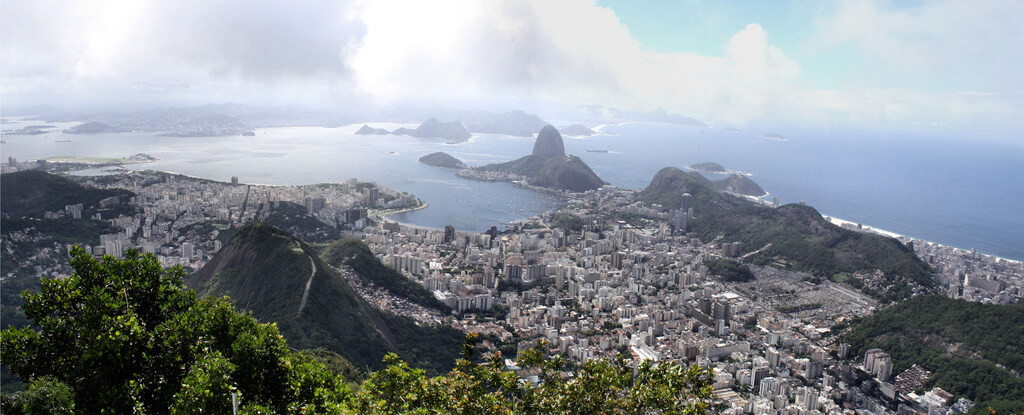
Is it Expensive to Live in Brazil?

Best Places to Live in Florida

34 Best Things to Do in Florianopolis and Santa Catarina Island (Brazil)

22 Best Things to Do in Lefkada (Greece)
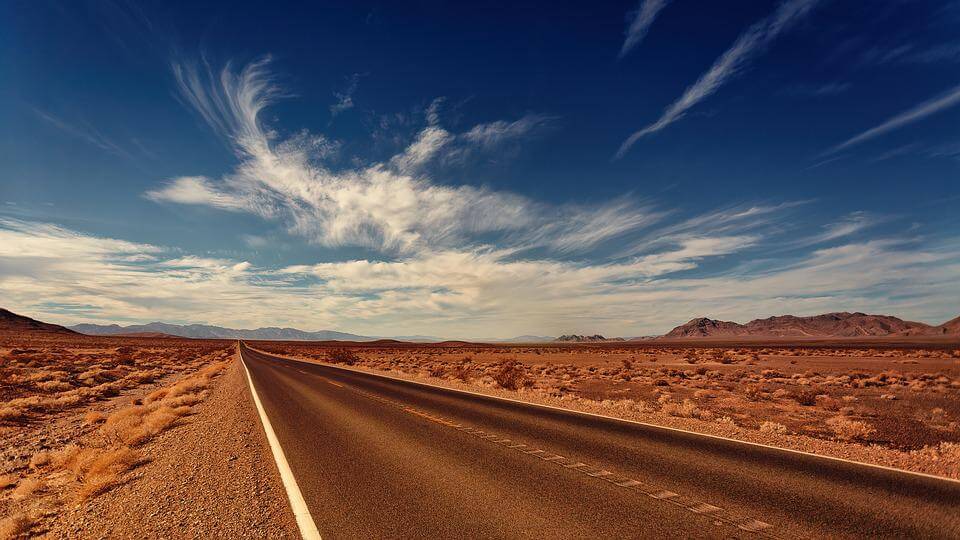
26 Best Places to Visit in Nevada
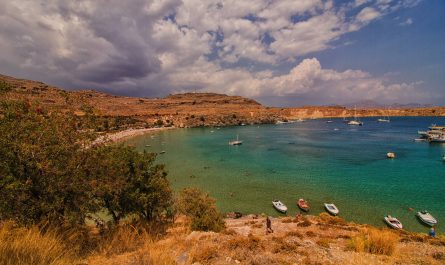
10 Best Beaches in Rhodes (Greece)

30 Best Things to Do in São Luís (Brazil)

8 Best Languages to Learn (Proven Tips)

Touropia Travel
Discover the World
25 Top Tourist Attractions in Rome
By Mike Kaplan · Last updated on May 4, 2024
Ah, Rome. The city where hope springs eternal. It is a city that is proud of its ancient glorious heritage, a city that once expanded its empire throughout Europe, Africa and Asia. Rome is a city drenched in history and Christianity. First-time visitors may be easily overwhelmed by all this magnificent city has to offer. After all, one can find history and art on almost every street corner. That’s why visitors may want to do their homework to narrow down what they want to see and do before they get on a plane or train bound for the Italian capital.
Rome is divided into several districts with its center, the Colosseo district, containing the most ancient attractions like the Colosseum, Capitoline Hill and the Roman Forum. On the outskirts of the center is Old Rome, featuring the Pantheon, stunning cathedrals, plazas and Renaissance architecture.
Map of Rome
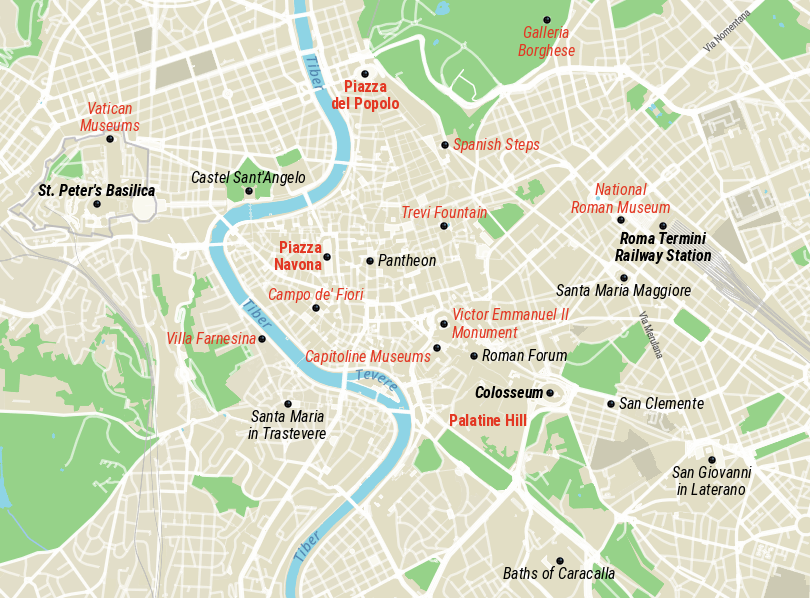
Unfortunately, it’s not possible to see all the top tourist attractions in Rome in a few days or even a few months. Wise travelers won’t even attempt to see everything in one trip. To ensure they’ll return to Rome, they’ll toss a coin into the Fountain of Trevi. Legend has it that those who do will return to Rome again.
25. Baths of Caracalla
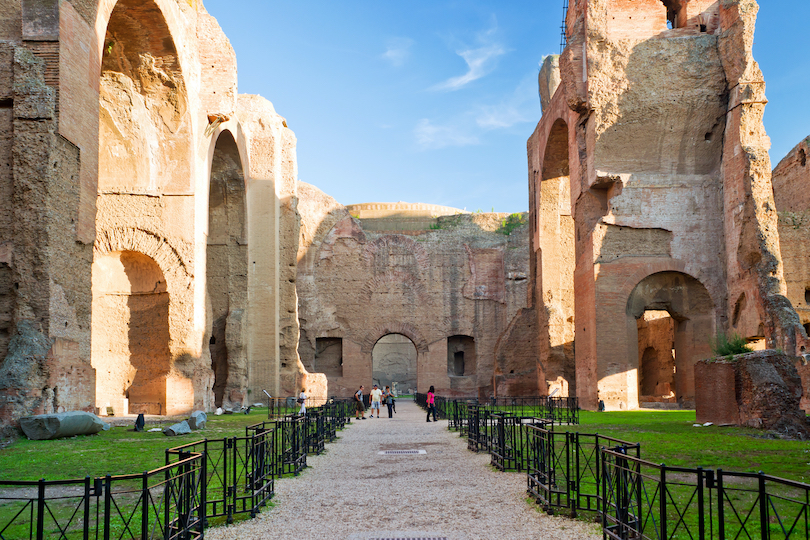
The Baths of Caracalla, the second largest public baths in Rome, were built by Emperor Caracalla in the third century for political propaganda purposes: The emperor simply wanted people to like him.
The baths were functional for over three hundred years. Negligence, looting and an earthquake turned the complex into ruins but their sheer size and ingenuity continues to impress visitors.
24. Villa Farnesina
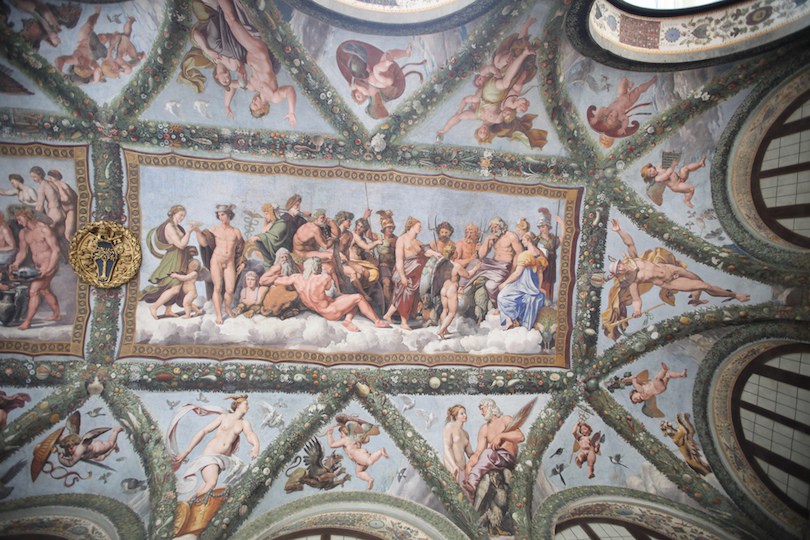
Visitors who want a peek at how the wealthy lived during the Renaissance may want to visit Villa Farnesina , a villa located in the Trastevere district. The Villa Farnesina is well known for the frescoes depicting the myths of Cupid and Psyche that were painted by Raphael.
Works by various other artists were commissioned by a banker who was also a papal treasurer, and who had the villa built in 1506.
23. Appian Way
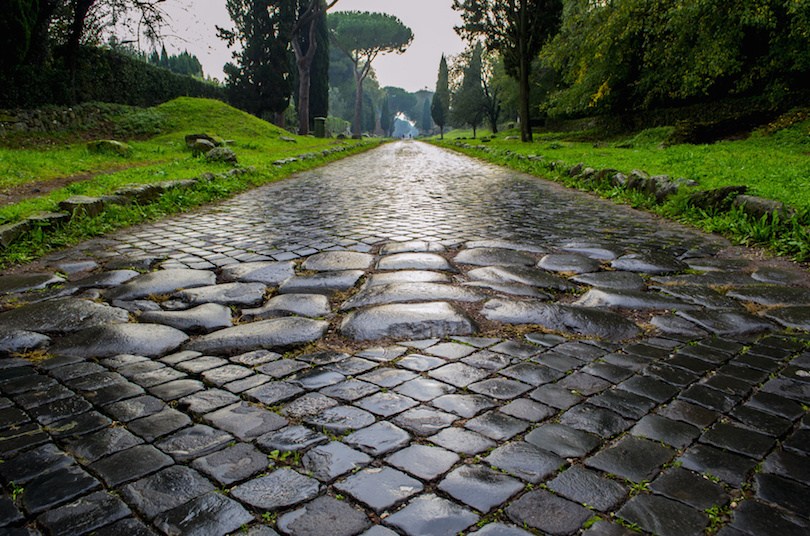
The Appian Way is the most famous ancient road in Rome, connecting the city with Brindisi in southeastern Italy. Named after Appius Claudius Caecus, a Roman censor, it was originally a military road.
Many historical monuments can be found along the first 8 km (5 miles) of the 560 km (350-mile) stone road today. This old highway has heavy vehicle traffic at the beginning, but is safe for pedestrians after a couple of miles.
22. National Roman Museum
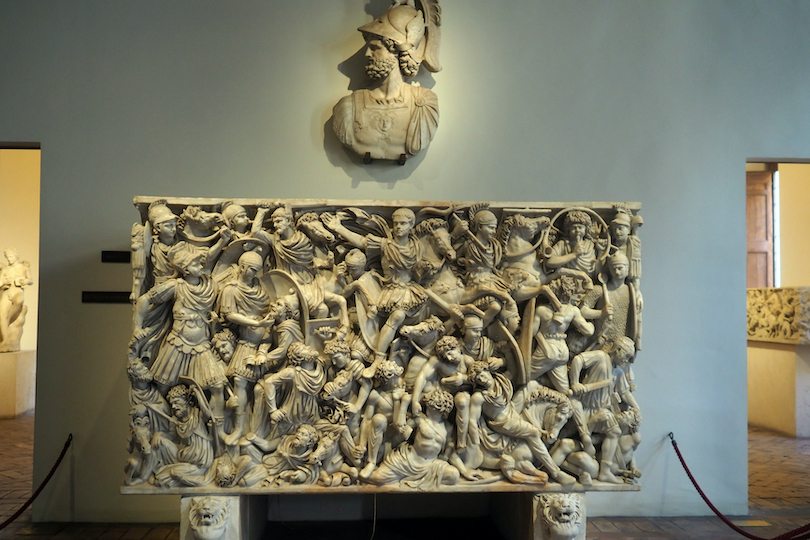
If you want to soak in as much of Rome’s history, heritage and culture as possible, then don’t miss the National Roman Museum, or the Museo Nazionale Romano .
This Roman museum does not house its entire collection in one spot. Instead, exhibits are located in multiple destinations throughout the city. Find amber, Roman artifacts and jewelry within the incredible Palazzo Massimo alle Terme, admire breathtaking use of marble and stunning sculptures within the Palazzo Altemps and get an up-close look at Roman baths at the restored historic site of the Baths of Diocletian.
21. Victor Emmanuel II Monument
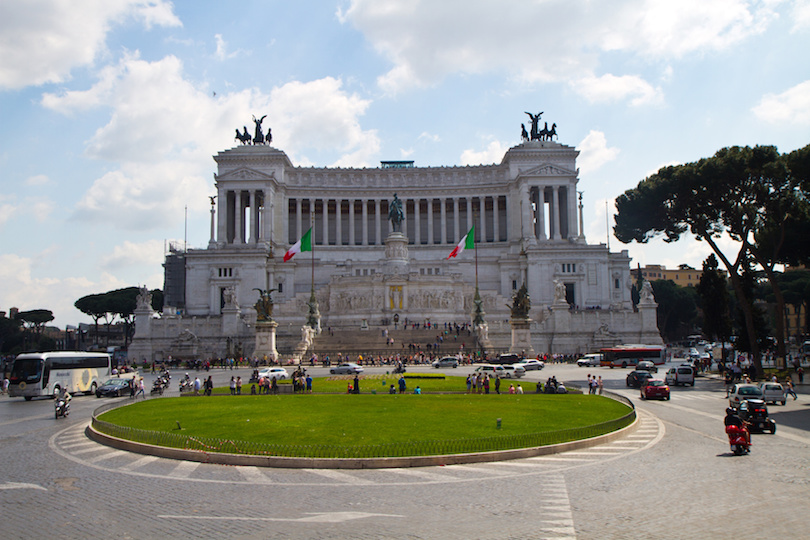
Built in honour of Victor Emmanuel, the first king of a unified Italy, this bombastic monument may appear to be solid white marble but actually contains many rooms inside. It was designed by Giuseppe Sacconi in 1885 and completed in 1925.
There are two permanent museums, one on Italian Reunification and one on emigration from Italy, as well as other spaces that host rotating exhibitions. The Victor Emmanuel Monument is not exactly known as one of Rome’s most beautiful structures but it is nevertheless well worth the visit, even if only for the great views from the top.
20. Piazza del Popolo
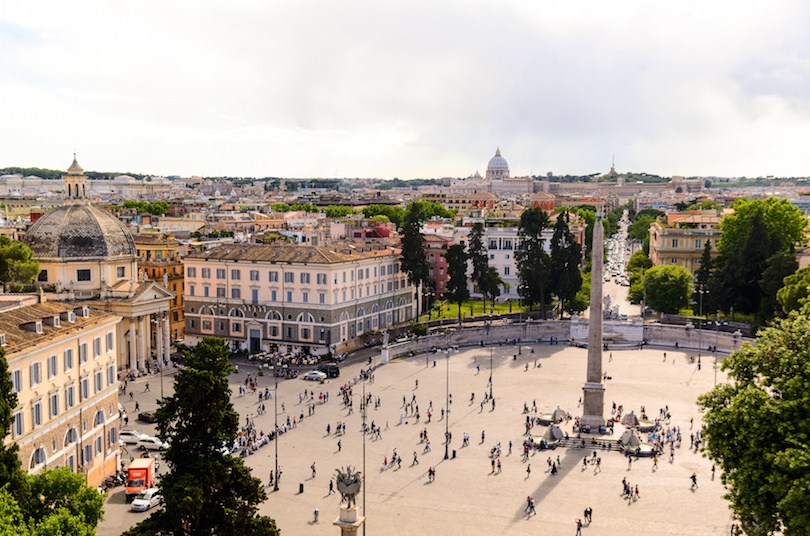
The Piazza del Popolo is a large oval square in northern Rome that has been around since the days of the Roman Empire. At one time, it was the start of the most important road north.
Three churches border the square but the eye-catcher is an obelisk from ancient Egypt. On the north side the square is dominated by the Porta del Popolo, which leads to the Via Flaminia, a road connecting Rome with the Adriatic coast.
19. Santa Maria in Trastevere
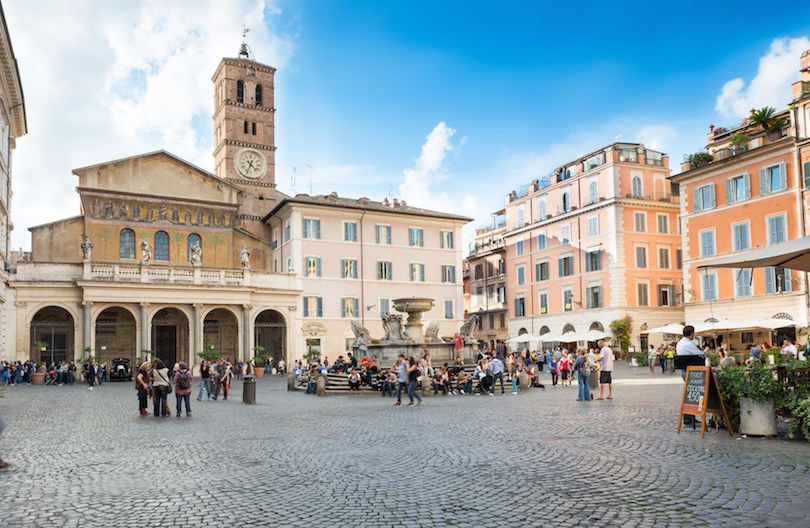
Santa Maria in Trastevere is one of the oldest churches in Rome, with most historians believing it was first built in the 4th century. The church has impressive mosaics from the 12th and 13th centuries; it has been enlarged and restored over the years.
Located in the popular Trastevere neighborhood, its atmospheric piazza is enhanced by the mosaics on the façade, especially at night when the church and its tower are illuminated.
18. Ostia Antica
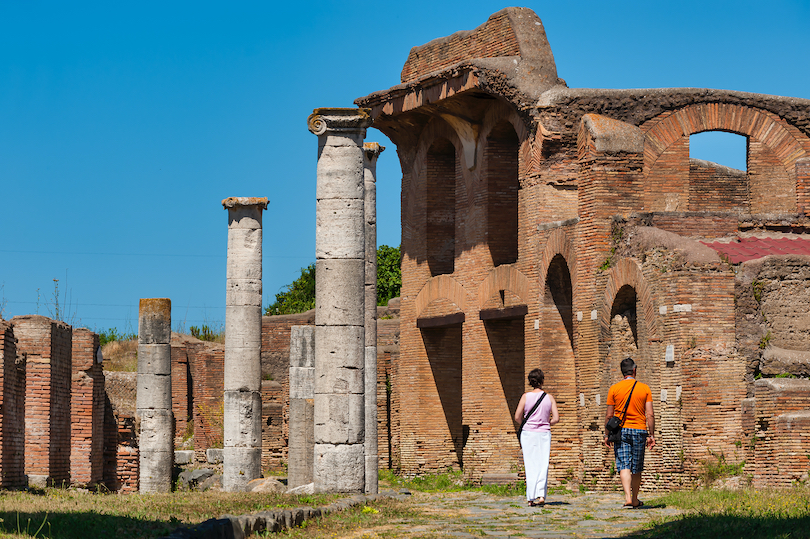
Ostia Antica is an important archeological site that once was the seaport for Rome. It is located less than 20 miles from Rome at the mouth of the River Tiber. The site has well-preserved ancient buildings, some of which date back to the fourth century BC.
Ostia Antica is known for the outstanding frescoes and mosaics on these old buildings, as well as ancient public toilets that turned bathrooms into a social setting.
17. Basilica of San Clemente
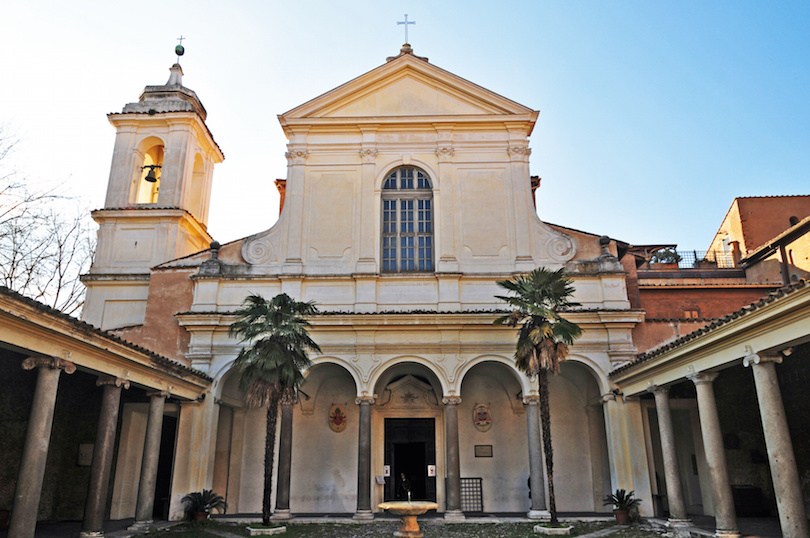
Located just a few blocks from the Coliseum, the 12th century Basilica of San Clemente is built on top of a 4th century Church and older Roman temple. The present church is noted for its fabulous frescoes and mosaics.
For an admission fee, it is possible to explore the excavations of the lower two levels, which is a fascinating journey into the history of Rome.
16. Capitoline Museums
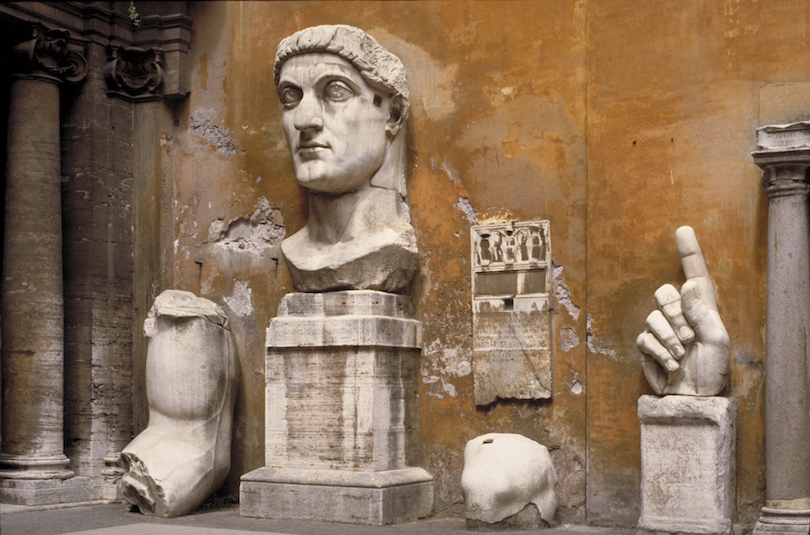
It may have taken the Romans 400 years to build the Capitoline Museums , after they were designed in 1536 by Michelangelo, but the wait was worth it. This outstanding collection of art and archeological museums, which started with a papal donation in the 15th century, can be found at Piazza del Campidoglio atop Capitoline Hill. The collections include medieval and Renaissance art, old Roman statues and jewels.
15. Palatine Hill
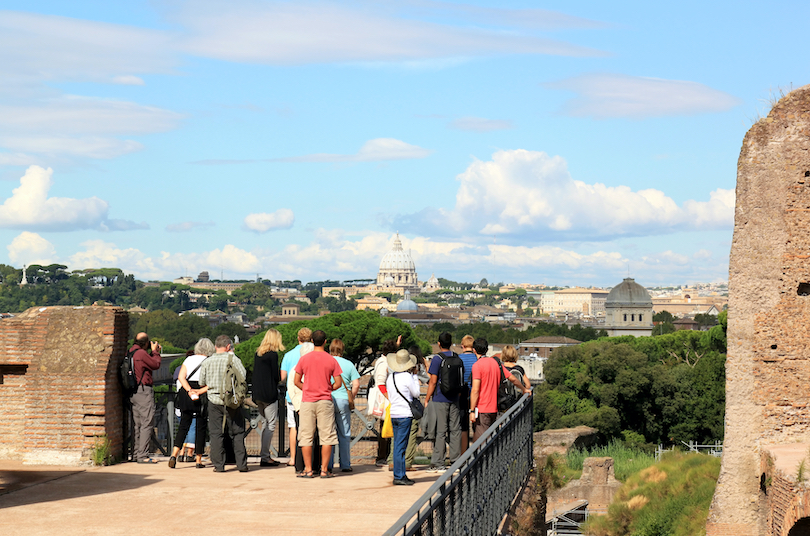
Palatine Hill, one of the Seven Hills of Rome, has links to Roman mythology, as it was here a wolf allegedly found the twin boys Romulus and Remus, and cared for them until a shepherd rescued them.
Even if this legend is not true, Palatine Hill is still the place where Rome was founded. Today only ruins remain but during the Imperial era, the hill was completely built up with large palaces.
14. San Giovanni in Laterano
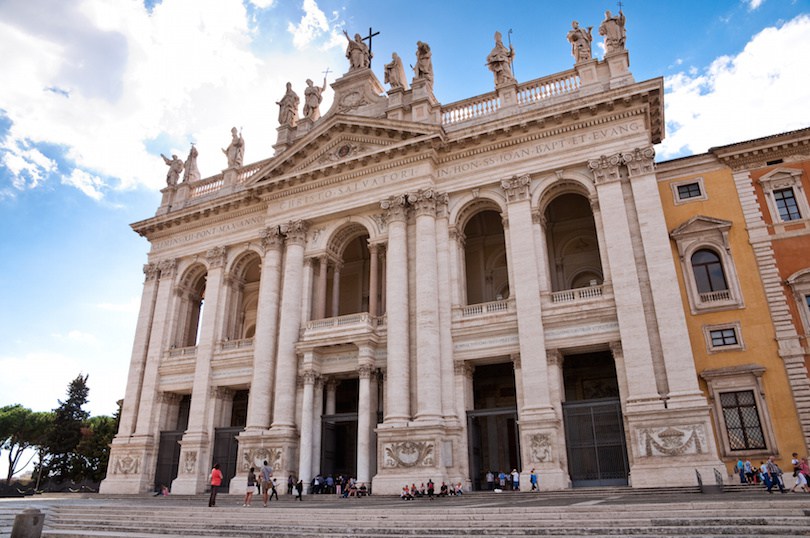
San Giovanni in Laterano (St. John Lateran) is one of four major basilicas in Rome. Dedicated to John the Baptist and John the Evangelist, it is the home cathedral for both the archbishop of Rome and the pope.
It is believed to be the first Catholic church built in Rome. Its exterior doesn’t seem as ornate as other churches, but inside it’s beautiful decorated, with wall ornaments, columns, mosaics and paintings.
13. Galleria Borghese
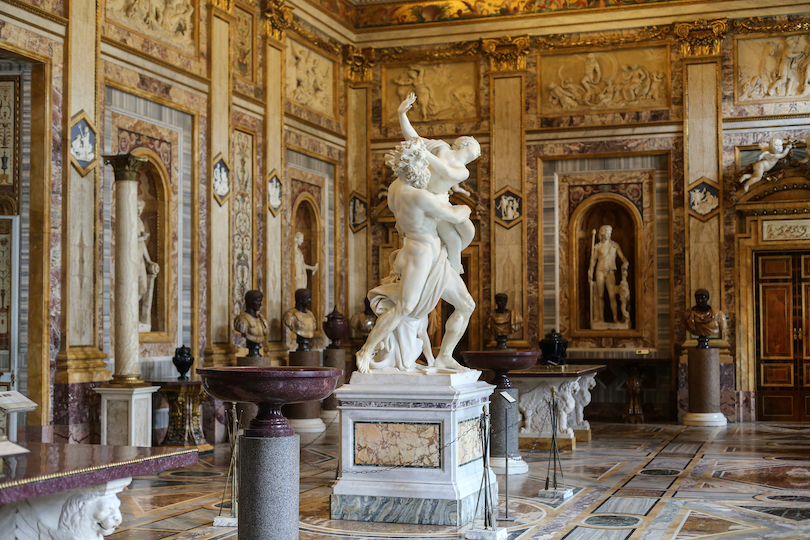
The Galleria Borghese is an art gallery that was built as a party house by Cardinal Sciopione Borghese in the 17th century. A nephew of Pope Paul V, the cardinal also was a patron of the arts.
The galleria today houses many pieces of paintings, sculptures and other antiquities from his collection. Paintings by Titian, sculptures by Bernini, and the National Museum of Musical Instruments can be seen here.
12. Basilica di Santa Maria Maggiore
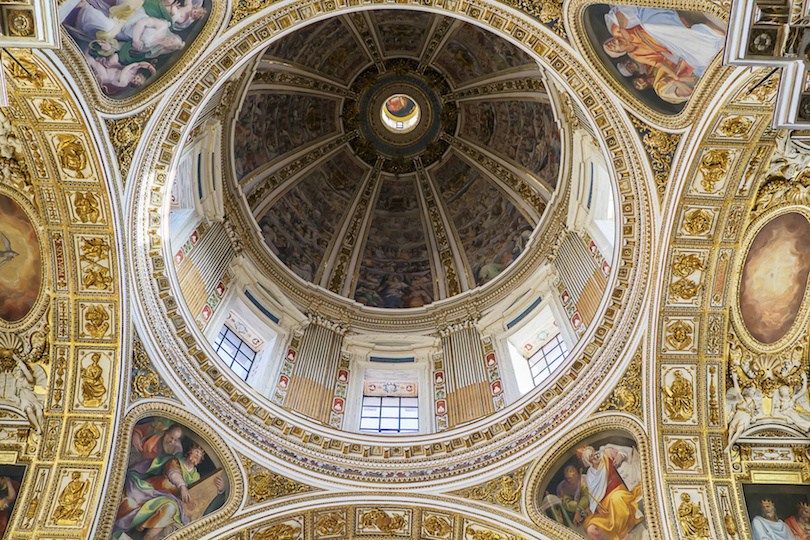
Founded in the 4th century, the Basilica di Santa Maria Maggiore (St. Mary Major) is considered one of the most important Catholic churches in Rome. Its 18th-century exterior conceals one of the best-preserved Byzantine interiors in the city.
Travelers who are in Rome on August 5 may want to attend the Miracle of the Snows celebration when thousands of white petals are dropped from the ceiling.
11. Saint Peter’s Square
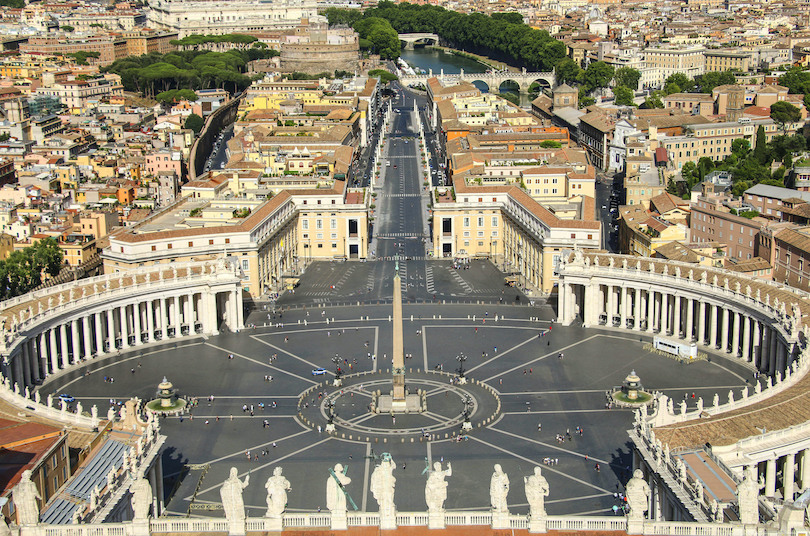
Located in Vatican City, St. Peter’s Square is the most famous square in Rome. Hundreds of thousands of people gather here to hear messages from the pope. Created in the 17th century by Bernini, the square has an elliptic shape, surrounded on two sides by colonnades before St. Peter’s Basilica.
Statues sit atop the colonnades. At the center of the ellipse stands an Egyptian obelisk that was transported from Egypt to Rome during the reign of Emperor Augustus.
10. Campo de’ Fiori
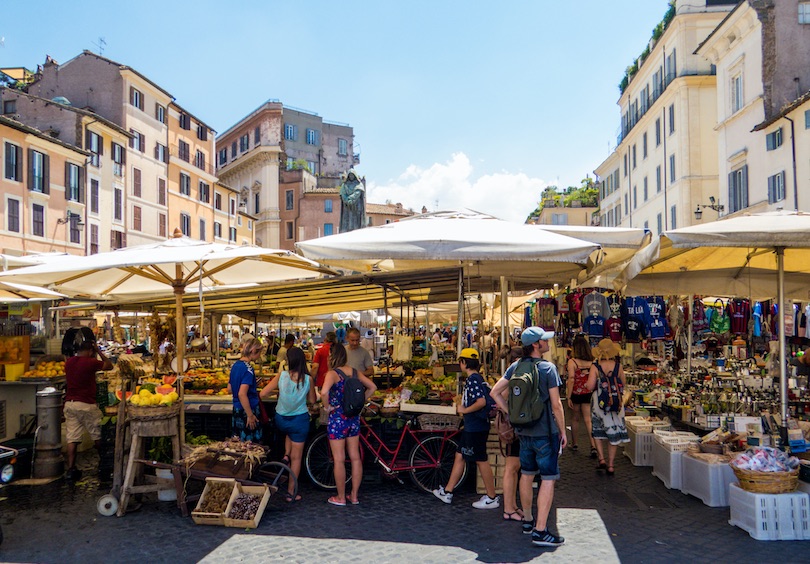
Campo de’ Fiori is a rectangular square south of Piazza Navona used as a marketplace during the day, and party central for college students and tourists at night. The name means “field of flowers” and was first given during the Middle Ages when the area was actually a meadow.
Today the market is a lively place, especially when the daily vegetable market is held here (every morning except Sundays). Visitors can buy fresh produce at the market, as well as fish, meat, flowers and spices. The square is surrounded by cafes and restaurants, making it a good place to eat after shopping or just wile away the afternoon.
9. Piazza Navona
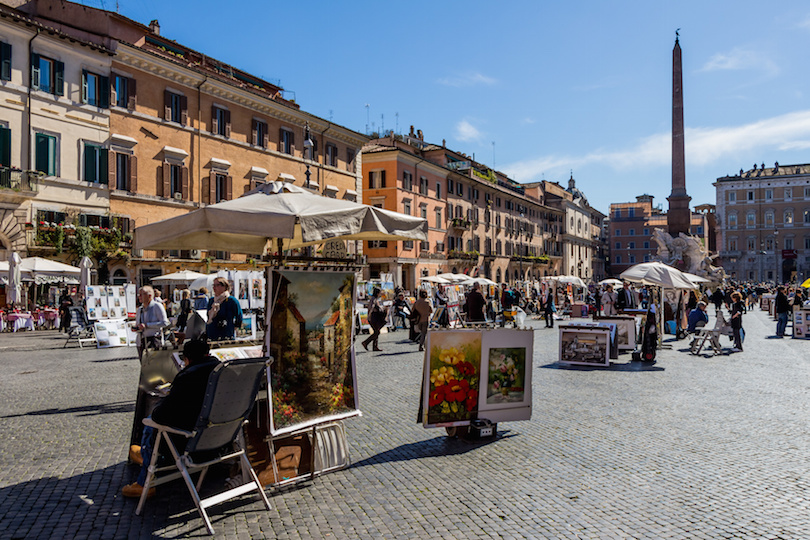
One of the most famous of Rome’s many squares, Piazza Navona was established towards the end of the 15th century, and preserves the shape of the Stadium of Domitian that once stood here.
Built by Emperor Domitian in 86 AD, the stadium, which had a larger arena than the Colosseum was mainly used for festivals and sporting events. The buildings surrounding the square stand where the spectators once sat.
Today, the square features no less than three magnificent fountains and is an immensely popular place to sip a cappuccino, shop, and watch street performers.
8. Castel Sant’Angelo
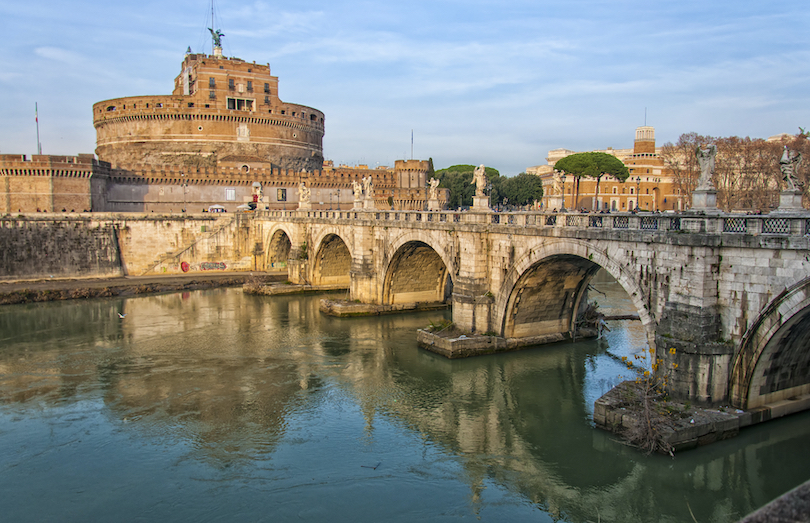
Castel Sant’Angelo was built to be a mausoleum for the Emperor Hadrian and his family. Built in 123 BC, it later was turned into a fortress and castle by the popes. It was once Rome’s tallest building.
The ashes of other emperors were buried there, but scattered when the Visigoths invaded in 410. It also served as a prison, but today the castel is a museum. Among the most well known sights in Rome, film buffs will recognize it as a setting from “Angels and Demons”.
7. Roman Forum
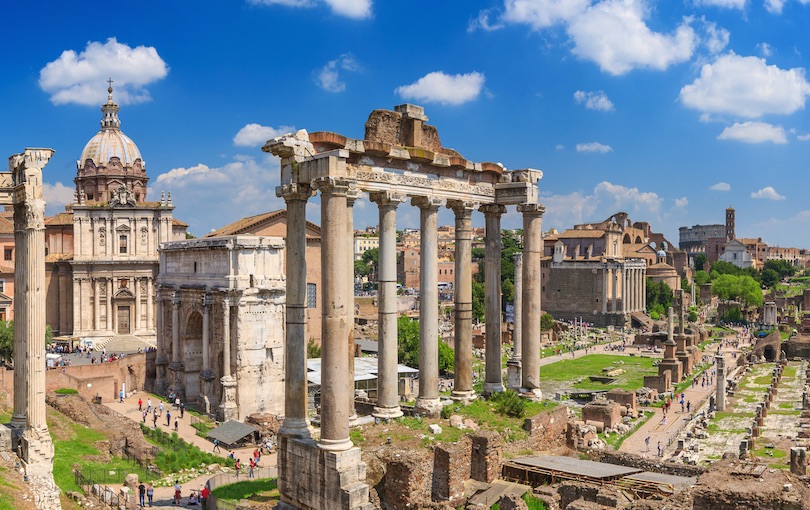
Located in the small valley between the Palatine and Capitoline Hills, The Roman Forum (or Forum Romanum in Latin) was for centuries the teeming heart of ancient Rome: the site of triumphal processions and elections, venue for public speeches, and nucleus of commercial affairs.
The Forum today is a sprawling ruin of architectural fragments and includes the Arches of Septimius Severus and Titus, the Temple of Antoninus Pius and Faustina and the Temple of Saturn.
6. Spanish Steps
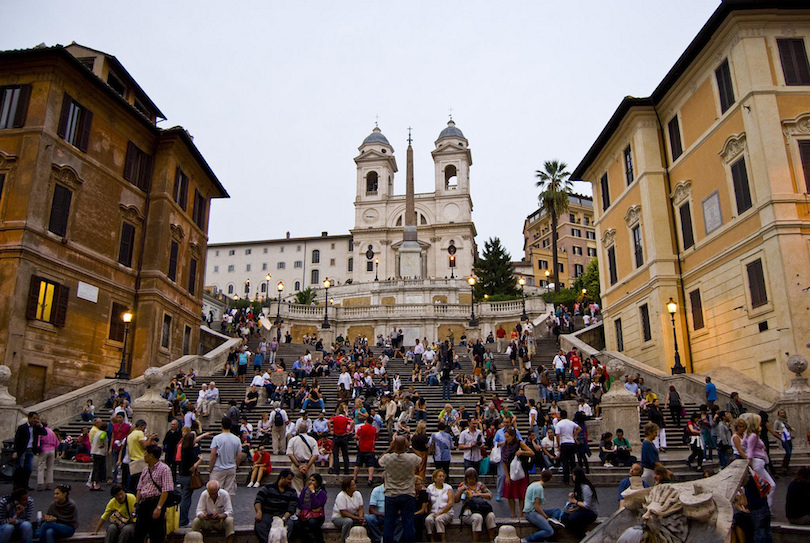
A truly monumental stairway of 135 steps, the Spanish Steps were built with French funds between 1721‑1725 in order to link the Bourbon Spanish embassy to the Holy See with the French church, Trinità dei Monti.
The steps are usually very crowded attracting tourists as well as locals who use it as a gathering place. Each year in May the steps are decorated with pink azaleas. At the foot of the Spanish Steps is the Piazza di Spagna (Spanish square) and the Fontana della Barcaccia, a sober fountain designed by Gian Lorenzo Bernini.
5. Trevi Fountain
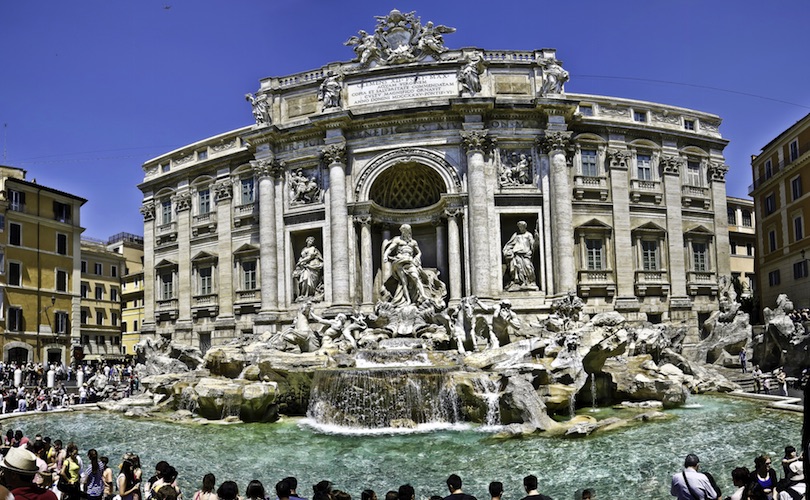
Completed in 1762 to a design by Nicola Salvi, this world famous Baroque fountain features a mythological sculptural composition of Neptune, god of the sea, flanked by two Tritons.
The location of the Trevi fountain marks the terminus of the ancient Aqua Virgo aqueduct and is so named on account of its position at the junction of three roads (tre vie).
The fountain was the setting for an iconic scene in Fellini’s film Dolce Vita starring Anita Ekberg and Marcello Mastroianni. Since than, it has become one of the most popular tourist attractions in Rome. The legend says that one who throws a coin in the fountain shall one day return to Rome.
4. Vatican Museums
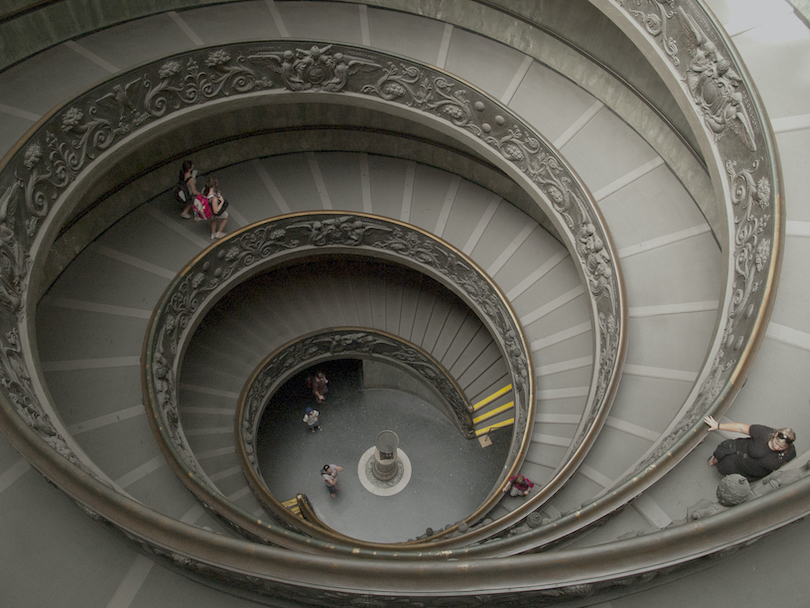
The Vatican Museums began in the 16th century with a collection of sculptures by Pope Julius II. Today, they encompass several museums inside the Vatican City and include some of the world’s most important relics. Attractions of the museums include the spiral staircase, the Raphael Rooms and the exquisitely decorated Sistine Chapel. Michelangelo painted the chapel ceiling between 1508 and 1512.
Today the ceiling, and especially The Last Judgment, are widely believed to be Michelangelo’s crowning achievements in painting. To keep the massive crowds under control, the museums have 4 itineraries that range from one and a half hours to more than 5 hours. All itineraries end in the Sistine Chapel.
3. Pantheon

One of the best preserved Roman buildings, The Pantheon was built in 126 AD as a temple for all the Roman gods. The temple has served as a Roman Catholic Church since the 7th century. Eight graceful granite Corinthian columns extend across the front of this circular building, with lesser columns in back.
Though it is 2,000 years old, the Pantheon’s famous dome remains the world’s largest unreinforced concrete dome. It is believed Marcus Agrippa built the Pantheon to be his private temple. The current building was reconstructed by Emperor Hadrian in the second century.
2. St. Peter’s Basilica
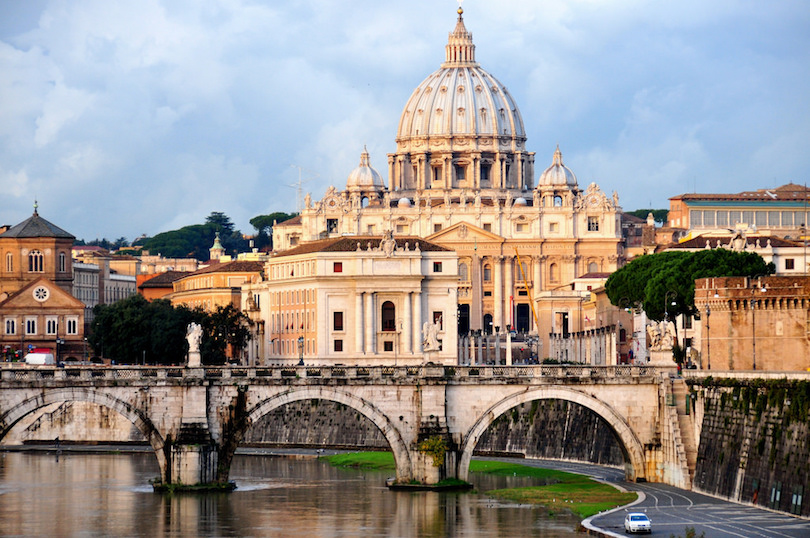
The center of the Catholic world and a major tourist attraction, the Basilica of St. Peter is a huge church: with an interior height of 120 meter (400 feet), the space shuttle, together with its booster rockets, could fit inside, as could the Statue of Liberty.
The basilica stands on the traditional site where Peter, the apostle who is considered the first pope, was crucified and buried. Construction on the current building began in 1506 and was completed in 1615. Many famous artists worked on the complex and its surroundings: Michelangelo designed the dome while Bernini designed the great St. Peter’s Square.
1. Colosseum

The Colosseum is another of Rome’s major tourist attractions. Its construction was started by emperor Vespasian of the Flavian dynasty in 72 AD and was finished by his son Titus in 80 AD.
The elliptical amphitheater could hold up to 50,000 people who turned out to watch gladiators do battle, people be publicly executed and enjoy other forms of entertainment. This stone and concrete structure, built in the first century, was the largest amphitheater in the Roman Empire. It is considered one of the Romans’ greatest architectural and engineering feats.
Share this post:
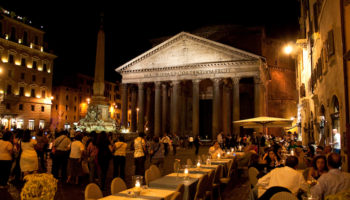
How to Spend 3 Days in Rome: The Perfect Itinerary
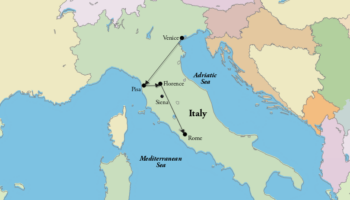
How To Spend One Week in Italy: DIY Itinerary
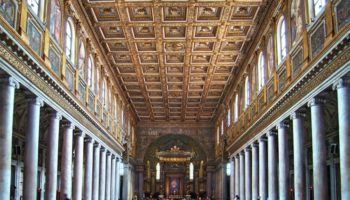
8 Most Beautiful Churches in Rome

Rome Alone: 8 Things to Do Solo in Rome
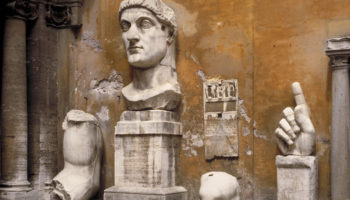
10 Best Museums in Rome
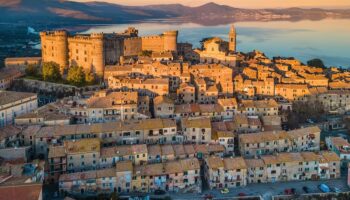
14 Best Places to Visit in Lazio, Italy
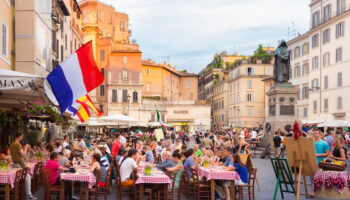
Best Time to Visit Rome: Month-by-Month Guide
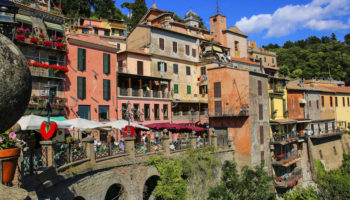
11 Best Day Trips from Rome
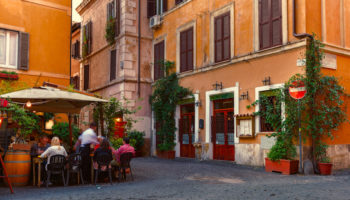
Where to Stay in Rome: Best Neighborhoods & Hotels
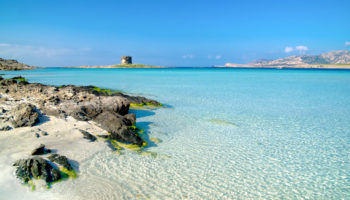
Where to Stay in Sardinia: Best Towns & Hotels
Reader interactions.
October 1, 2017 at 5:15 am
Rome is really majestic! I would love to see these beautiful architectures soon.
May 22, 2014 at 10:50 am
this is so nice
February 1, 2014 at 2:29 am
it is very nice to see Italy, the famous pantheon, koloseum and a lot of other places to see. When i visit it i saw a lot. Bravoo Italy, the most beautiful place in the world.
Leave a Reply Cancel reply
Your email address will not be published. Required fields are marked *
This site uses Akismet to reduce spam. Learn how your comment data is processed .
Free Things to Do
Shopping in Milan
Performing Arts Guide
Must-Try Food in Milan
Milan's Top Restaurants
Nightlife in Milan
Best Time to Visit
Weather & Climate
Neighborhoods to Know
Milan's Airports
Public Transportation
48 Hours in Milan
Day Trips From Milan
Top Things to Do
The 19 Best Things to Do in Milan
What to See and Do in Milan, Italy
:max_bytes(150000):strip_icc():format(webp)/martha_bio-56a3c8865f9b58b7d0d3b5fe.jpg)
TripSavvy / Christopher Larson
Here are the top things to do and top tourist attractions in Milan, Italy. You'll find most of these places located on our Milan Transportation Map showing the three Metropolitan lines and major stops of interest to the tourist.
Visit the Duomo
TripSavvy / Angelina Pilarinos
Milan's Duomo, or cathedral, is the largest Gothic cathedral in the world. Construction began in 1386, but it took nearly 500 years to complete. More than 130 spires and over 3,000 statues adorn the Duomo's roof; take an elevator (or climb the stairs) to the rooftop for a close-up view. You'll also catch some magnificent views of the city below. Below, Milan's Piazza del Duomo, the square where the cathedral sits, is the hub of the city's historic center. The square is also home to a statue of Vittorio Emanuele and the Palazzo Reale housing the Duomo Museum and Contemporary Art Museum.
Go See Da Vinci's Last Supper
The 15th-century Convent of Santa Maria della Grazie houses Leonardo Da Vinci's famous fresco, The Last Supper . Although the building was bombed in 1943, the fresco survived. To see the iconic mural, you must book in advance, sometimes more than two months ahead of time.
Tour the Castello Sforzesco
Milan's castle, Castello Sforzesco, is near the city center and, unlike many castles, you don't have to climb a hill to get to it. The castle is home to several different museums, displaying paintings, furniture, and other cultural and historic artifacts, including works by da Vinci and Michelangelo, including the latter's final sculpture, the Rondanini Pietà . But even if you don't want to visit a museum, the castle is an excellent place to wander around—its courtyard serves as a local park. You can see castle artifacts and architecture details. There's also a collection of musical instruments and the Egyptian and Prehistoric sections of the Archeology Museum.
Listen to Opera at La Scala
Teatro alla Scala, or La Scala, is one of Italy's top historic opera houses . Renovated in 2004, La Scala first opened in 1778 and has been the opening venue for many famous operas. Attending an opera in La Scala is a top experience for opera fans, but you'll need to book in advance. If you can't make it for a performance, La Scala's museum has a collection of musical instruments and portraits and busts of musicians. You can even view the auditorium from boxes and the backstage area.
Take a Guided Tour of Milanese Landmarks
Select Italy's Discovering Milan's Masterpieces is a three-hour tour that includes seeing the Last Supper , the Sforzesco Castle and Sculpture Museum with Michelangelo's Pieta, the Cathedral (and rooftop when Last Supper tickets are not available), and La Scala Opera House.
Admire the Galleria Vittorio Emanuele II
Galleria Vittorio Emanuele II, built in 1867, is a huge glass-roofed shopping arcade lined with elegant shops, bars, and restaurants. Inside are mosaics with the symbols of the cities forming the newly united Italy. Some people consider it good luck to stand on the testicles of the bull of Turin. The galleria is built in a cross-shape and links the squares of the Duomo and La Scala.
Visit Basilica Sant'Ambrogio
Basilica Sant' Ambrogio, one of Milan's oldest churches, is an 11th-century church built on the site of a fourth-century church. Sant' Ambrogio is Milan's patron saint, and you can see him in a crypt along with second-century martyrs. The church is an excellent example of Romanesque architecture and inside are many interesting relics, carvings, and mosaics. Be sure to see the gold altar.
Go Shopping (And Window Shopping!)
Milan is known as Italy's top fashion city, and it's an excellent place to shop for designer clothes, shoes, and accessories. Good shopping streets include Via Dante between the Duomo and Castle, Corso Vittorio Emanuele II near Piazza Della Scala, and via Monte Napoleone near the Duomo. For exclusive fashions, head to the area around via Della Spiga called the Quadrilatero d'Oro or Golden Quadrangle that also includes Via Montenapoleone, Via Andrea, Via Gesù, Via Borgospesso, and Corso Venezia. Corso Buenos Aires has less expensive shops and chain stores, many of them even open on Sundays. Of course, if you don't want to spend lots of money, window shopping is entertaining too.
See Incredible Art at the Brera Picture Gallery
Pinacoteca di Brera is Milan's top art museum, housing a collection of more than 600 works from the 14th through the 20th centuries, including works by top artists such as Raphael, Piero Della Francesca, and Bellini. The gallery was started in the 19th century and is housed in a 13th-century convent.
Take a Walk in the Parco Sempione
When you get tired of museums, crowds, and shopping head to one of Milan's parks. One of the best is Parco Sempione, between the castle and Porta Sempione, which spans 116 acres and is home to an aquarium, a sports stadium, and a medieval castle. Many of the city's best attractions, like the Palazzo dell’Arte, are located in Parco Sempione.
Enjoy a Day Outside the City
Milan is central to many fascinating smaller cities and towns as well as to the lakes of Northern Italy and makes an excellent base for visiting them by train. The breath-taking Lake Como is just 30 miles north of the city; you can take a train or drive. The tiny town of Bellagio is well worth a visit: Here you can walk along the lake's shorelines, visit ancient churches, and dine at mom-and-pop restaurants.
Watch a Soccer Game at San Siro Stadium
Like much of Europe, football (aka soccer to Americans) is tremendously popular in Milan. The city is home to San Siro Stadium, one of the largest in Europe. It's where A.C. and Inter, Milan's two teams, both play and well worth a visit. The stadium can host more than 80,000 people.
Have an Espresso at Wes Anderson's Café
Fans of the eclectic filmmaker shouldn't miss Bar Luce, a café designed by the director for Fondazione Prada. While the café channels the 1950s and 1960s, popular Italian aesthetics inspire the retro furniture and color palette, and you'll see some resemblance's to Anderson's film sets. Don't forget to take an Instagram next to the vintage pinball machine!
Visit the Cimitero Monumentale
This isn't your typical cemetery. Even if you're the type who doesn't care for visiting a graveyard, you owe it to yourself to check out Milan's "Monumental Cemetery." This substantial open-air museum houses hundreds of tombs, including many belonging to some of the country's most important citizens. The designs vary: You'll see everything from four-poster beds to marble pyramids, as families have competed over the years for the most elaborate mausoleum.
See the Royal Palace of Milan
Milan's Royal Palace served as the seat of the city's government for decades and is now an essential cultural center in the town. The palace spans more than 75,000 square feet and hosts a number of various exhibitions each year, showcasing fashion, art, design, and more. It's also home to valuable painting, many on loan from other international institutions. During your visit, see the museum of the palace, which is divided into four different parts of Milanese history: Neoclassical, Napoleonic, Restoration, and Italy's unification.
Walk Around the Navigli District
This canal-crossed district is irresistibly gritty but is also home to some of Milan's coolest bars, galleries, and restaurants. Visit the Miradoli Arte Contemporanea for a showcase of Italy's best young artists, before having an outdoor aperitivo at Ugo. If you visit the neighborhood on the last Sunday of the month, don't miss the Mercatone dell’Antiquariato (flea market), held along the Navigli Grande.
Visit Sant Ambrogio
Among the oldest buildings in Milan, this church was built in 379 A.D. by St. Ambrose. Today, it's still beautiful, with two large towers flanking the front façade and a series of ornate arches surrounding the central courtyard. Be sure to go inside, where you'll see original mosaics and frescoes.
Learn About Leonardo da Vinci's Incredible Achievements
Many know that da Vinci was a legendary genius, but few places underscore that more than the Leonardo da Vinci National Museum of Science and Technology. The museum features incredible models of cars and flying machines created from his drawings, as well as a robust archive of his blueprints and sketches.
Head to the Top of the Torre Branca
When you visit the Parco Sempione, you'd be remiss to skip the Torre Branca, an observation tower that stretches more than 350 feet tall. Famed architect Gio Ponti designed the tower, which was built in 1933. Now, you can take an elevator to the top where, on a clear day, you'll not only see the city beneath you, but also the Alps and Apennines.
Your Trip to Milan: The Complete Guide
20 Best Things to Do in Florence, Italy
Galleria Vittorio Emanuele II: Planning Your Trip
The 10 Most Elegant Cities in the World
48 Hours in Milan: The Ultimate Itinerary
The Top Neighborhoods to Explore in Milan
Free Things to Do in Milan
Lombardy Cities Map and Travel Guide
The Most Beautiful Castles in Italy
Where to See Leonardo da Vinci Artwork in Italy
Milan's Top Museums, Galleries, and Churches for Art Enthusiasts
The 15 Best Destinations in Italy
Getting Around Milan: Guide to Public Transportation
Nightlife in Milan: Bars, Clubs, & Live Music
The Best Time to Visit Milan
January and February Events in Milan

22 Top-Rated Tourist Attractions in Florence, Italy
Written by Barbara Radcliffe Rogers Updated Dec 27, 2023 We may earn a commission from affiliate links ( )
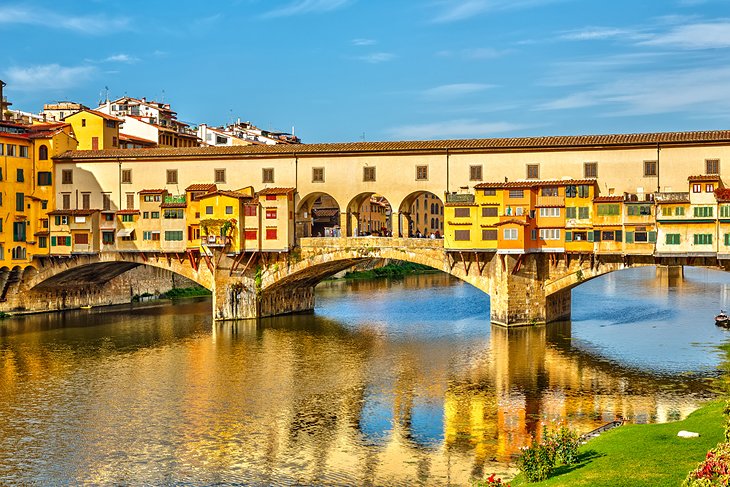
It would take weeks to see everything Florence has to offer. Almost any one of its dozens of churches would be the prize tourist attraction of a smaller city. Some of its sights are among Italy's best-known icons — Ponte Vecchio, Michelangelo's David , Brunelleschi's Dome — and the entire city is a showcase of the Italian Renaissance, the humanist artistic movement that broke Europe out of the Dark Ages.
But even among such an illustrious collection of palaces , churches , museums , and landmarks, some stand head and shoulders above the rest. As you consider all the things to see and do in Florence and plan your days of sightseeing, you won't want to miss the highlights that have made Florence one of Europe's most popular cities.
You'll be sure to find the best places to visit by using this handy list of the top attractions and things to do in Florence.
1. Cathedral of Santa Maria del Fiore and Piazza Duomo
2. battistero di san giovanni (baptistery of st. john), 3. see florence from piazzale michelangiolo, 4. uffizi palace and gallery, 5. piazza della signoria and the loggia dei lanzi, 6. galleria dell'accademia (academy gallery), 7. san lorenzo and michelangelo's medici tombs, 8. palazzo vecchio (palazzo della signoria), 9. santa croce, 10. ponte vecchio, 11. palazzo pitti (pitti palace), 12. santa maria novella, 13. san miniato al monte, 14. bargello palace national museum, 15. stroll through boboli gardens, 16. explore the oltrarno and take a break in piazza santo spirito, 17. palazzo medici-riccardi, 18. mercato centrale: florence's food market, 19. bardini museum and gardens, 20. brancacci chapel, 21. museo galileo, 22. shop for leather at piazza santa croce, where to stay in florence for sightseeing, tips and tours: how to make the most of your visit to florence, map of tourist attractions in florence, italy, florence, italy - climate chart, more things to see and do.
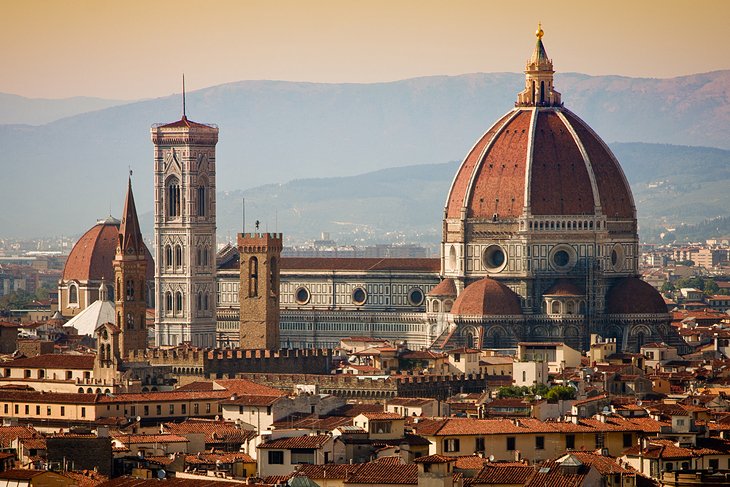
Piazza Duomo and the group of buildings that form its cathedral complex gather some of Italy's greatest artistic treasures into one relatively small area. As you tour the baptistery, the bell tower, the cathedral, and its museum, you'll see some of the best-known masterpieces of art and architecture by the greatest artists of the Italian Renaissance -- Ghiberti, Brunelleschi, Donatello, Giotto, and Michelangelo.
Begin by walking around the square to admire the intricate inlaid marble exteriors, then step inside each one to look more closely at the stained-glass works of art that greet you wherever you look.
If waiting in long lines to buy a ticket is not your idea of fun - especially on a hot day - consider the Skip the Line: Florence Duomo with Brunelleschi's Dome Climb tour. This 2.5-hour guided tour includes the cathedral, the dome, the baptistery, entrance fees, and the option to visit the Opera del Duomo Museum on your own.
- Read More: Exploring Santa Maria del Fiore Cathedral: A Visitor's Guide
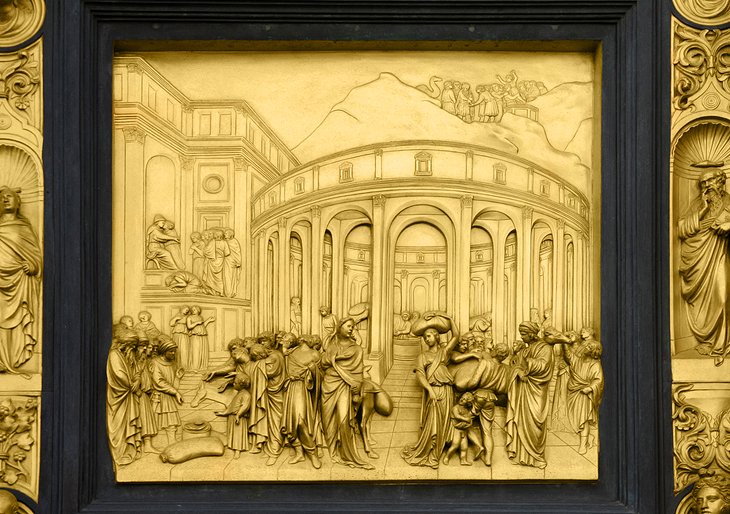
From any angle, inside or out, the 12th-century octagonal baptistery is a consummate work of art. Its marble façade, the intricate mosaics of its interior, and the art works it holds all merit a place high on your list.
But the magnificent bronze panels that Ghiberti created for the doors facing the cathedral trump them all. Nowhere has bronze been worked with such exquisite expression as in these Gates of Paradise . For a closer look, and to see some of the treasures that have been made for the baptistery, visit the Museo dell'Opera del Duomo , the cathedral's museum.
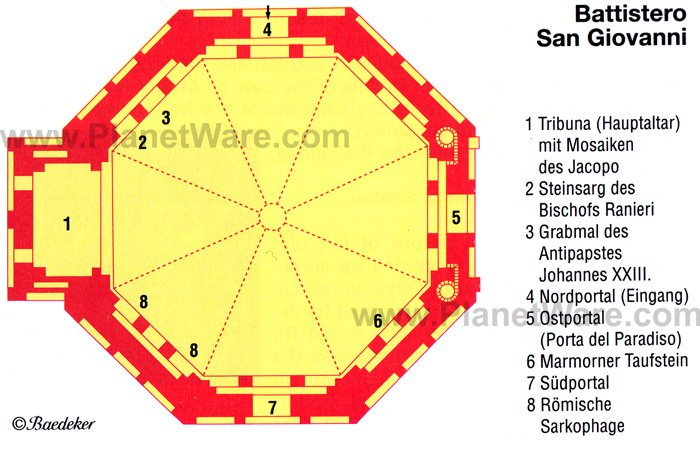
So often misspelled as Piazzale Michelangelo that even city tourism material occasionally slips up, this terrace above the city is an obligatory stop for tour buses, and the spot from which all those postcard shots of the cathedral are taken. During busy tourist seasons, the best time to enjoy it in relative peace is late afternoon or early evening; it's especially lovely at sunset.
Although you can get a 360-degree panorama of Florence from the dome of the cathedral, only from this terrace can you fully appreciate how Brunelleschi's dome dominates the city center. Nor can any other height give you this sweeping city view that encompasses the Ponte Vecchio , Palazzo Vecchio, Santa Croce, and other landmarks.
You can walk here, climbing from the riverbank through the gardens, or take bus 12 or 13. While you're here, continue up to the church of San Miniato al Monte or stay on the bus to the church and walk back down.
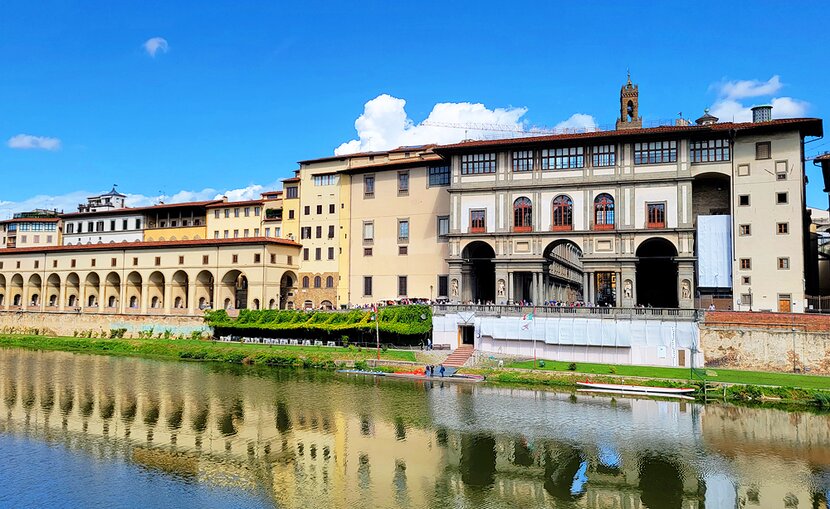
Few would argue the Uffizi's place among the handful of world's top art museums. Its collections are simply staggering in their diversity and quality, and even if art is not your main interest, you should see the highlights of the paintings here.
You'll come away understanding a lot more of how Florence's 14th- to 16th-century painters changed the face of western art, as you see the transition from the stilted Byzantine images to the life-like figures and landscapes of the Renaissance artists.
The vast building stretching along the river was one more of the Medici palaces but was intended not as a residence, but to house governmental offices, scientific studies, and part of their growing art collection. One of its loveliest spaces, the octagonal Tribuna , was commissioned especially to display the most prized paintings and jewels of Francesco I de' Medici.
You can bypass the long wait for admission and go straight to the entrance with a Skip the Line: Florence Accademia and Uffizi Gallery Tour that gives you priority access as well as a guided tour.
- Visiting the Uffizi Gallery in Florence: 12 Top Highlights, Tips & Tours
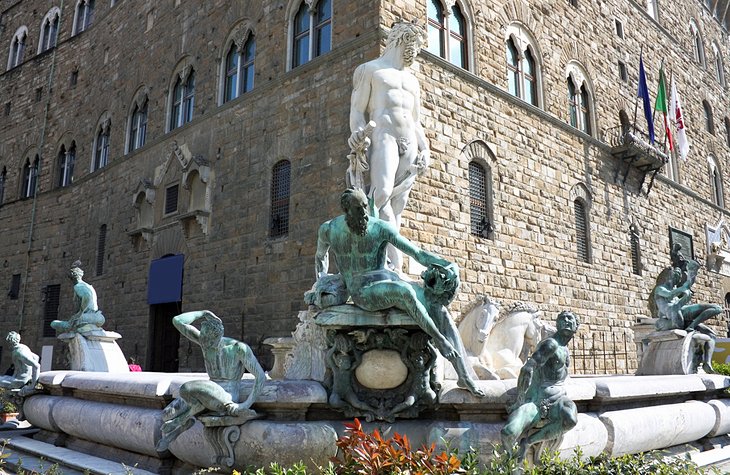
This broad square has been the center of power in Florence since its 14th-century origins - and perhaps even before, as Etruscan and Roman remains have been found below its pavement. Today, it is the social center as well, a favorite meeting place filled with tourists and locals. At its center is the Neptune Fountain , at one side the Palazzo Vecchio , still housing the city's government.
Against the wall of the Uffizi, which forms one end of the piazza, is the Loggia dei Lanzi , an outdoor sculpture gallery with several notable pieces. Most widely recognized of these is Benvenuto Cellini's best-known work, Perseus with the Head of Medusa . In front of the Palazzo Vecchio is a copy of Michelangelo's David .
- Read More: Exploring Piazza della Signoria in Florence: A Visitor's Guide
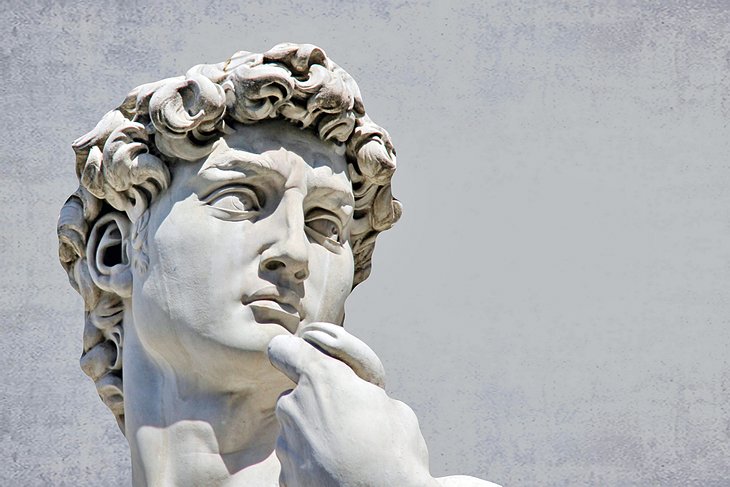
Michelangelo's best-known work, David , is copied all over Florence, but inside this art museum, you'll find the original. Unfortunately, as a result of an attack on the sculpture, it is now behind glass, but it still never fails to inspire.
The David isn't the only Michelangelo here, nor is it the only important masterpiece. In the sculptures shown in the same gallery, you can almost watch Michelangelo at work as you see the four unfinished slaves, meant for a tomb in Rome, seemingly in the process of being released from the marble.
Here, also, is his St. Matthew for Florence cathedral, also unfinished. You'll want to look in the other galleries to see highlights by 13th- to 16th-century Florentine artists, especially if you do not plan to see the Uffizi Gallery collections. Sandro Botticelli's Madonna is a highlight.
You can save time waiting in the long lines at both these outstanding art museums with a Skip the Line: Florence Accademia and Uffizi Gallery Tour that takes you straight to the entrance, as well as a guided tour.
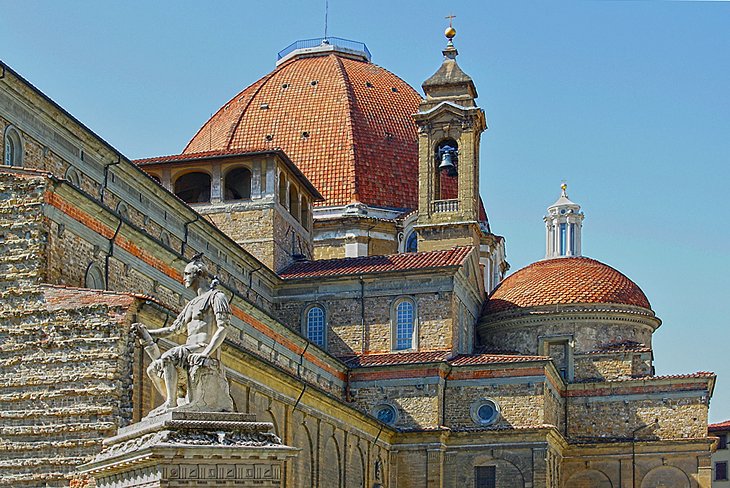
The Medici commissioned the best talent for the family church and burial chapels: Brunelleschi for the church and Michelangelo for the chapel intended to memorialize their most illustrious princes. Both artists died before finishing the work, but Brunelleschi's church was completed according to his plans.
Michelangelo's chapel, called the New Sacristy, was not; in fact, it was never completed at all. But what he did finish is considered one of the world's crowning achievements in marble sculpture. As you tour the church, the Old Sacristy , the New Sacristy , the Princes' Chapel and the Laurenziana Library, you'll find the works of other Renaissance masters, including Donatello and Lippi.
- Read More: Exploring San Lorenzo in Florence: A Visitor's Guide
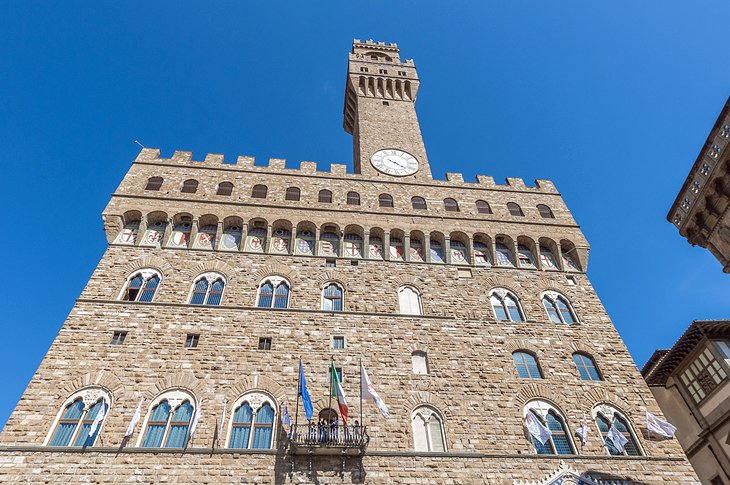
History, art, and power echo in the opulent rooms and grand galleries of this fortress-like palace in the center of Florence. From here, the city/republic was ruled, and its powerful Medici family commissioned the leading artists and architects of the day to design and decorate their offices and apartments.
Be sure to sign up early for one of the free tours, so you'll get to see some of the secret passages the Medici used to move among the rooms; return in the evening (save your ticket) to climb to the roof for sunset views of the city.
- Read More: Exploring Palazzo Vecchio (Palazzo della Signoria) in Florence: A Visitor's Guide
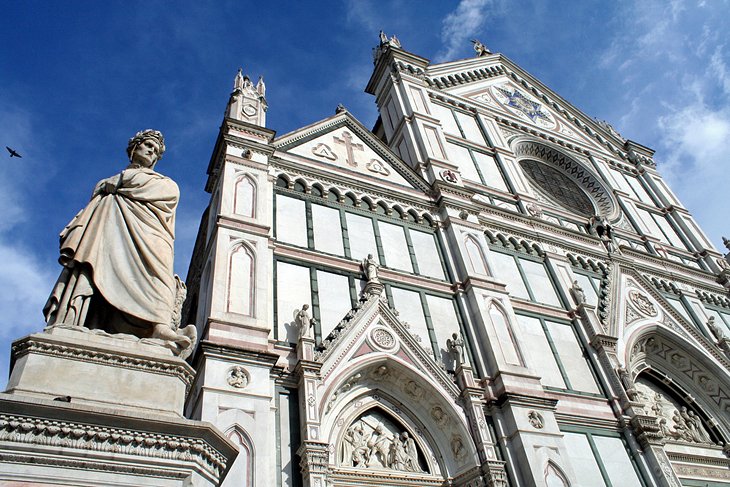
Behind the geometric marble inlay of its typical Tuscan façade, Santa Croce is both art-filled church and mausoleum for some of Florence's greatest names. Among its treasures are several landmarks of Renaissance art.
You will want to look especially for Cappella Bardi with some of Giotto's major frescoes, and in the adjacent Cappella Peruzzi, for more of them, which inspired Masaccio and Michelangelo. Donatello's Christ Crucified is considered one of the finest examples of Florentine Renaissance humanism. The frescoes in Cappella Baroncelli are the greatest work of Taddeo Gaddi.
But the most famous is Cimabue's magnificent Crucifix, one of the first to move from stiff Byzantine to naturalistic Renaissance styles, influencing the greatest artists that followed. In the nave, you'll find the tombs of Michelangelo, Galileo, Ghiberti, the composer Gioacchino Rossini, even Machiavelli.
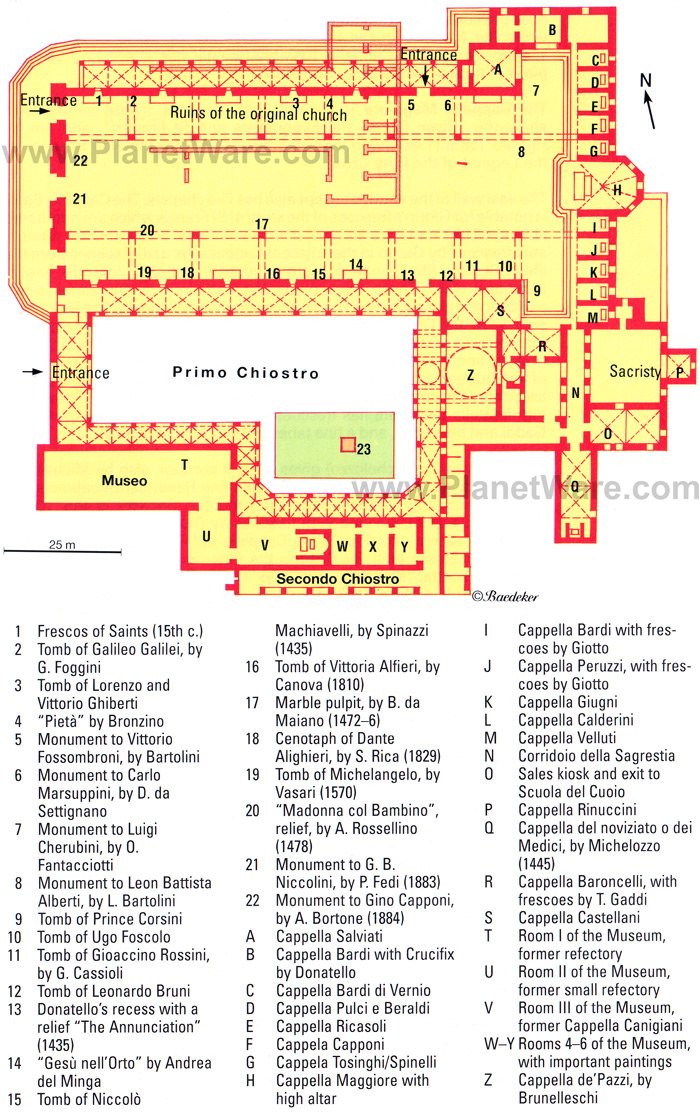
The Ponte Vecchio may well be the most widely recognized icon of Florence, and its graceful arches topped by a jumble of shops is most certainly one of the city's prettiest scenes. The bridge has traditionally been the home for the shops of Florence's talented goldsmiths, and a stroll across it still shows a dazzling array of fine jewelry.
But most tourists don't realize that another set of treasures hides above their heads. The purpose of the bridge, of course, was to link the two sides of the Arno, and the Medici needed to cross frequently between their offices in the Palazzo Vecchio and their apartments in the Pitti Palace . So they commissioned the architect Vasari to build a passageway, officially called the Percorso del Principe (Passageway of the Prince), but now more often known as the Corridoio Vasariano, Vasari Corridor .
You can see its line of evenly matched windows above the shops. It's not just a hallway; lining its walls is a priceless collection of portraits, mostly self-portraits, by artists that include Rembrandt, Leonardo da Vinci, Raphael, Michelangelo, and Velásquez.
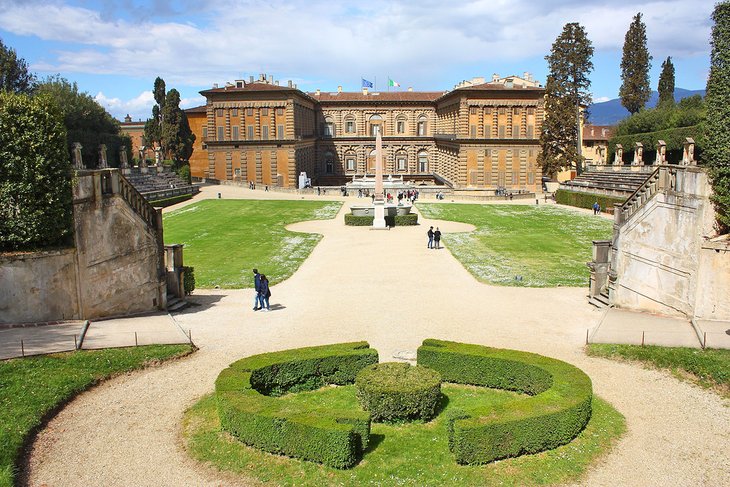
A day at the Pitti Palace complex (and you could spend a day seeing it all) gives you a little taste of the many things Florence has to offer: an outstanding art gallery, a Medici palace, Florentine craftsmanship, museums, history, royal apartments, and one of Italy's premier gardens.
If a day isn't quite what you had in mind, at least tour the palace to see the Royal Apartments and the sumptuous rooms, where you'll find paintings by Raphael, Titian, Rubens, Tintoretto, and other masters - a collection almost rivaling the Uffizi - hanging not in gallery style, but as decoration for rooms designed for entertaining and show.
- Read More: Exploring the Pitti Palace & Boboli Gardens in Florence: A Visitor's Guide
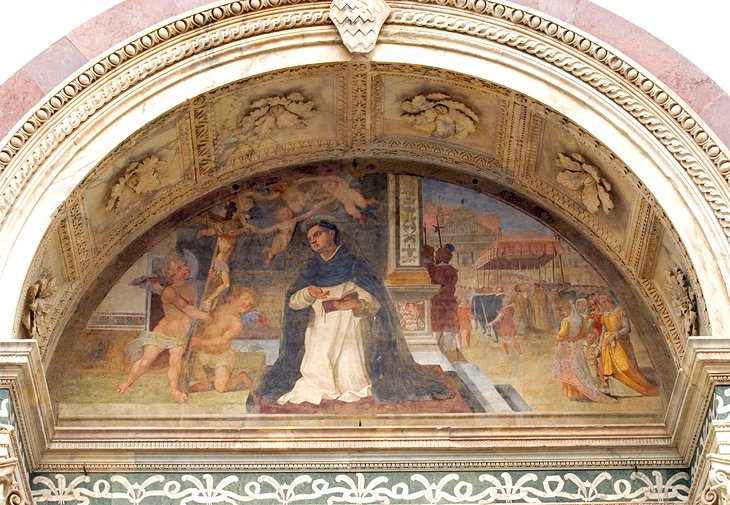
Although this Dominican church has the familiar striped façade of inlaid marble worn by several other churches in Florence , here it has been interpreted quite differently, tracing graceful curving designs, imitating windows, and highlighting rows of arches in the lower story.
The artistry continues inside, with some of the city's finest frescoes, by such masters as Masaccio, Giotto, Domenico Ghirlandaio, Lippi, Paolo Uccello. As if that weren't enough, an entire chapel is lined with Andrea di Bonaiuto's frescoes, some of the greatest artworks of 14th-century Italy.
In addition to the frescoes are a marble pulpit designed by Brunelleschi, his wooden crucifix, Vasari's Rosary Madonna, and a bronze by Lorenzo Ghiberti. Stop in at the convent's historic pharmacy, where they sell herbal balms and floral lotions.
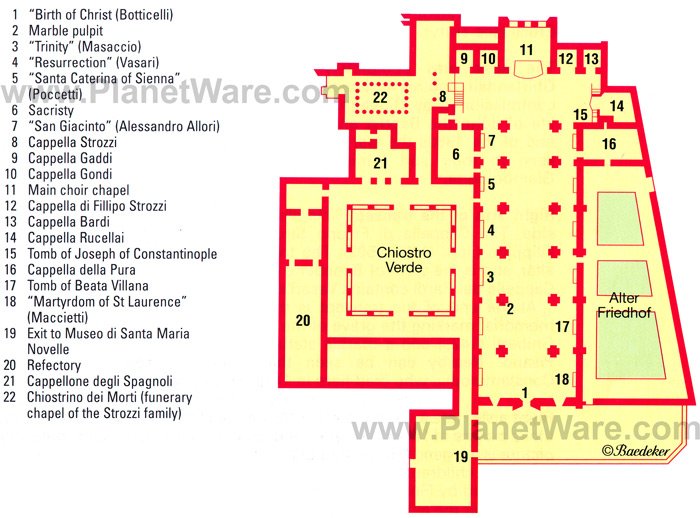
The sight of San Miniato al Monte's inlaid green-and-white marble façade is worth the short climb beyond the favorite viewpoint of Florence, Piazzale Michelangiolo (or you can stay on the bus to ride here).
This was the first time this dramatic effect was used in Florence, where it soon became the most popular façade decoration. But unlike the later facades, this one rises to a large gold mosaic. The portico effect looks back to Classical Roman architecture, and the mosaics are distinctly Byzantine inspired, both influences that blend into the new Tuscan Romanesque architectural style.
Inside, there's a spacious open nave, with a mosaic floor and painted wooden ceiling, ending at a magnificent Renaissance chapel under a glazed blue-and-white terracotta ceiling. More Byzantine-style mosaics, a 12th-century marble pulpit, and the decorated choir screen are all highlights,
Even more outstanding is the sacristy. Its walls are lined by the vibrant panels of Spinello Aretino's 14th-century masterpiece, Life of St. Benedict . It is among the most splendid rooms in Florence, and equal to those in any palace.
Address: Via delle Porte Sante, 34, Florence
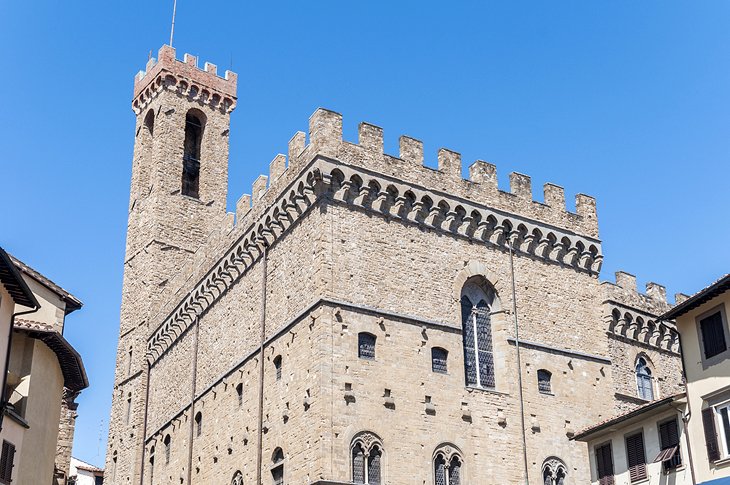
The four Michelangelo masterpieces alone are reason enough to put the Bargello Palace on your list of things to do in Florence. Works by Donatello, the della Robbias, Cellini, Brunelleschi, Ghiberti, and 14th- to 16th-century Tuscan artists fill the palace, along with a room of ivory carvings and a collection of majolica.
An entire room is filled with enamels and gold work, a Florentine specialty during the Renaissance. This emphasis on decorative arts and sculpture sets the Bargello apart from the rest of Florence's art museums .
Address: Via del Proconsolo 4, Florence
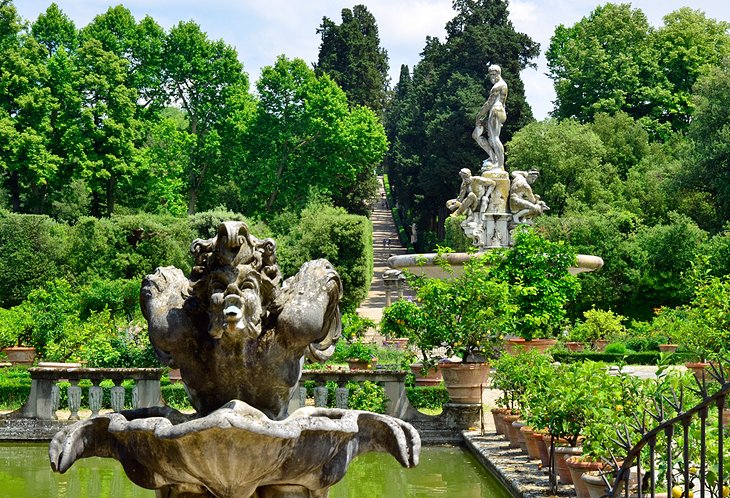
Behind the Pitti Palace, the Medicis' Boboli Gardens rise up the hillside in 111 acres of green terraces. Grand Duke Cosimo I spared no expense in their building, between 1550 and 1560, and the result became the model for royal gardens all over Europe (including Versailles ). Still beautifully manicured, the gardens climb to overlooks that reveal increasingly sweeping views over the city.
Throughout are fountains, statuary, and a faux cave complete with stalactites and stalagmites carved into the hillside, the Grotta del Buontalenti .
Other things to see include a maze, formal beds, even an amphitheater in the quarry hole left from removing stone to build the palace. At the highest point is the terrace of the Kaffeehaus, and at the top of the hill overlooking Boboli Gardens, Casino del Cavaliere houses a rich collection of porcelains owned by ruling families, including the Medici and the Savoy.
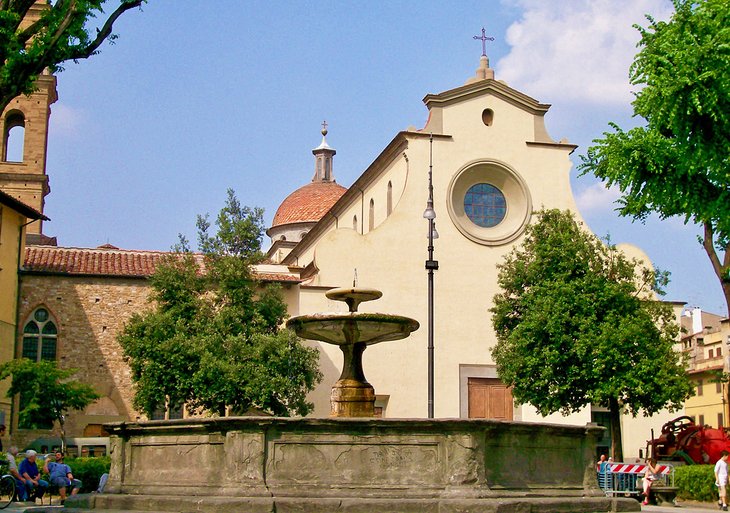
The Oltrarno is worth exploring for its atmospheric lanes and the workshops and studios of Florence's famous artists in wood, silver, and gold work; gilding; miniature mosaics; decorative papers; and leather bookbinding. You're sure to be tempted by the works for sale in the small shops, and there is no better souvenir or gift than a beautifully bound journal or a gilded wooden box.
Make your way to Piazza Santo Spirito, a lively square that's more intimate than the grander, busier ones across the river. Find an outdoor table at a café or restaurant and watch shoppers at the morning market or children playing ball after school.
Although it's not one of the best-known churches in Florence, the Basilica of Santo Spirito is one of the purest Renaissance churches and is filled with notable paintings and sculpture, especially in the transept chapels
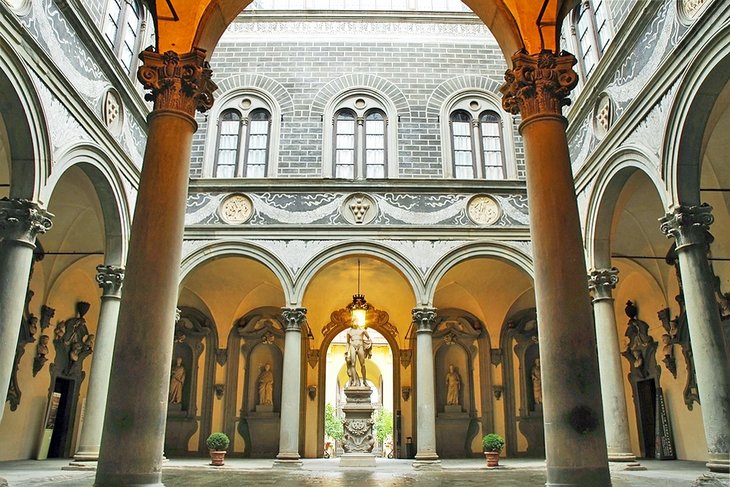
More restrained in its furnishing and décor than the showy palaces of later members of the Medici family, Palazzo Medici-Riccardi is more in line with the earlier dukes, who governed a more democratic society. Completed in 1464, it was the home of the Medicis for nearly a century until Cosimo I moved to the Palazzo Vecchio.
A staircase leads from the courtyard to the Palace Chapel, decorated with well-preserved frescoes by Benozzo Gozzoli that give a good sense of court life in 15 th -century Florence.
Although the Riccardi family, which owned the house after the Medicis, made alterations, the Medici Museum on the ground floor retains the original Medici interior. Here, also, is one of Filippo Lippi's most important works, Madonna and Child, painted in1442.
Address: Via Cavour 1 & 3, Florence
Official site: www.palazzo-medici.it
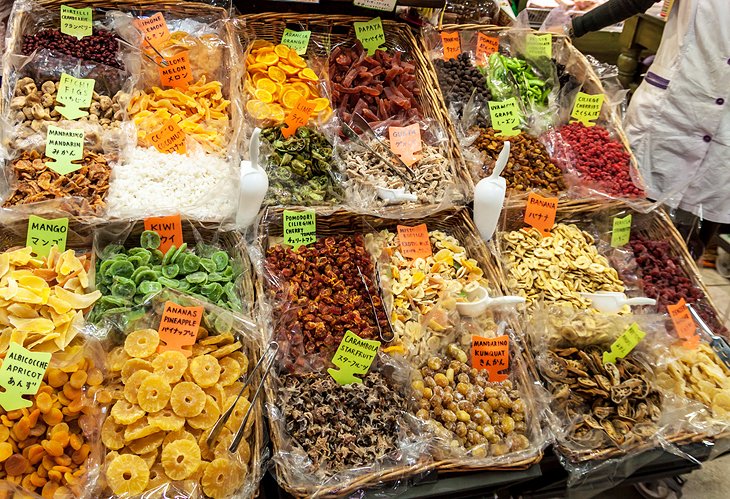
If you have begun to worry that Florence is just one giant open-air museum, it's time to meet some Florentines as they go about their daily routines. There's no better place to find them than in the enormous food market, Mercato Centrale.
To get here, you may have to run a gauntlet of street stalls selling everything from cheap plastics to "authentic Italian crafts" that are mass-produced, mostly in Asia. But once inside and immersed in the fragrance of fresh herbs, flowers, and garden produce, you'll rub elbows with women shopping for ingredients for today's dinner.
Don't overlook this as a source of welcome gifts to take home, including fine Tuscan olive oils, olives, candied fruits, and luscious nougat. On the upper floor, you'll find food courts, a good place to visit for a quick lunch.
Address: Piazza del Mercato, Florence
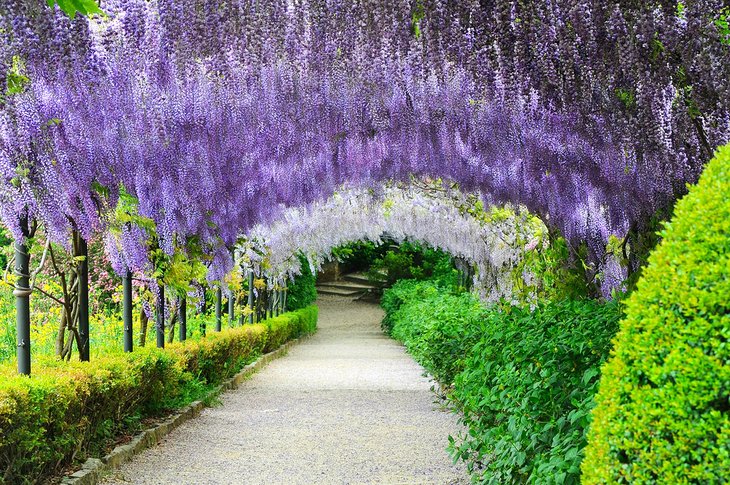
In the late 19 th century, artist and collector Stefano Bardini bought a group of buildings on a hillside in the Oltrarno, overlooking Florence. From these, which included a chapel and a former palazzo dating from the 14 th century, he created a setting for his collections of art and priceless antiquities.
To create this museum, he used architectural features salvaged from demolished medieval and Renaissance buildings. Monumental fireplaces, doors and windows, columns, carved stonework, entire staircases, paneling, carved Venetian woodwork, even entire ceilings have been retrofitted into a highly eccentric home for his equally eccentric collections.
But the resulting palazzo and its magnificent artworks are not the only attraction for tourists. After completing his museum, Bardini bought a neighboring garden overlooking the river and transformed it into an outdoor gallery to display some of his sculpture collections.
The Bardini Gardens overlook Florence, a lovely place to get away from the crowds and rest your eyes amid the greenery and flowers. The best time is in April, when brilliant purple wisteria covers the pergola and fills the air with fragrance. A long staircase, mosaic fountains, an English garden, and a terrace with a café make it a pleasant place to relax. Entrance to the garden is separate from the museum.
Bardini Gardens
- Costa San Giorgio 2, Florence
Bardini Museum
- Via dei Renai 37, Florence
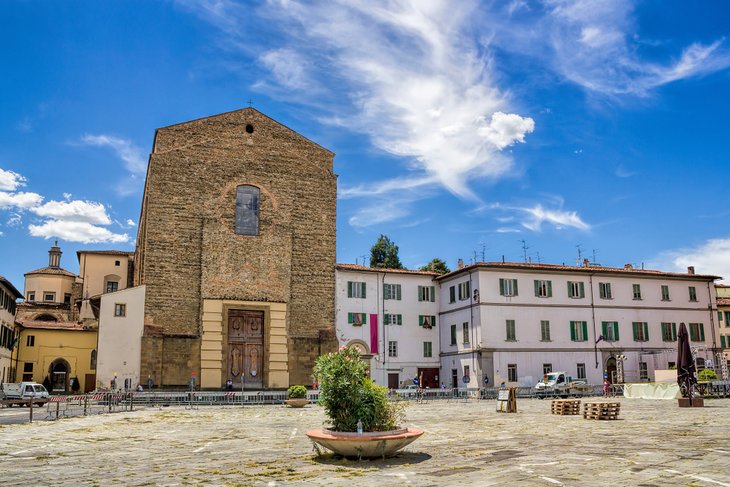
You would never guess by looking at the plain façade of Santa Maria del Carmine church that inside holds one of the great masterpieces of the 15 th century . Frescoes on the walls and ceilings of the chapel depict the life of St. Peter and Old Testament scenes by Masaccio and Masolino, who were well-known artists in the early 1400s, friends of Brunelleschi and Donatello.
The works, especially those of Masaccio, are remarkable for their vivid color and vitality, demonstrating some of the first use of perspective, and showing facial expressions that give life and energy to his figures.
Masaccio is considered the first great Italian painter of the Quattrocento period (15 th century) of the Italian Renaissance and the founder of the Early Italian Renaissance . The chapel was left unfinished by the two painters and was completed later in the 1400s by Filippino Lippi. Although the chapel is an important landmark, and a magnificent work of art, it is one of the least known treasures of Florence.
Address: Piazza del Carmine 14, Florence
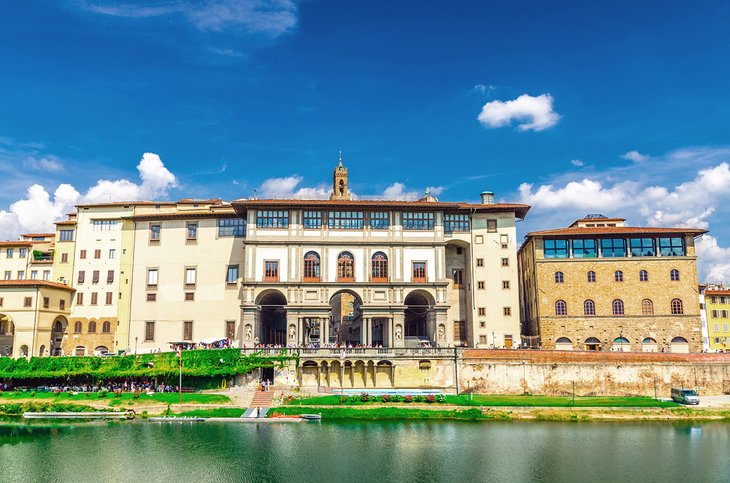
With the abundance of Renaissance painting, sculpture, architecture, and other masterpieces in Florence, it's easy to forget that the Renaissance was about more than art. Science was a major concern of the Humanists as they broke away from the confines of religion to explore their universe. And they saw art and science as connected and inseparable.
The Museo Galileo proves this, with tools of astronomy, navigation, surveying, and exploring that are priceless works of art. You'll see Galileo's own instruments, and the work of some of Florence's foremost artists in metal, wood, gold, and other arts in the collections of compasses, tools, and magnificent world globes.
Address: Piazza dei Giudici 1, Florence
Official site: https://www.museogalileo.it/en/
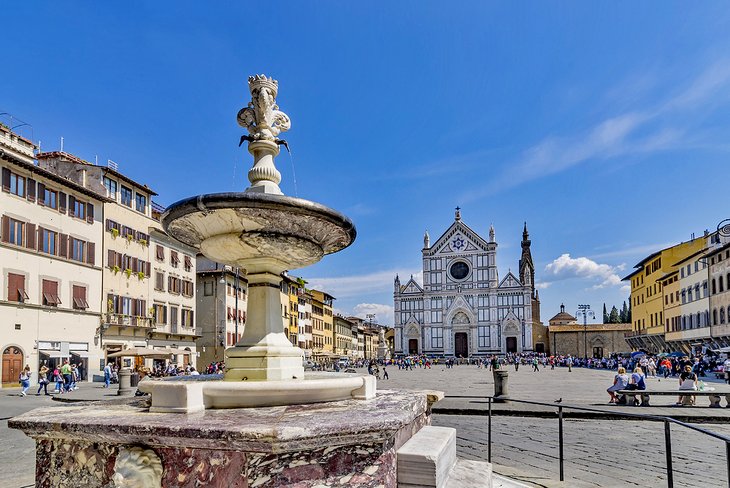
Fine leatherwork has been a tradition in Florence at least since Renaissance times, when leatherworkers had their workshops around Santa Croce, close to the tanneries along the river. That neighborhood is still the best place to shop for Florentine leather goods. To find the best quality, and at fair prices, shop at the leatherwork school or at an artisan's studio shop; some of the other shops, like the street market vendors, sell imported and imitation leather goods.
Inside the cloister of Santa Croce, the Scuola di Cuoio leatherworking school produces fine handmade leather goods, and you can watch the students fashion wallets, boxes, handbags, and leather jackets. There you'll find Francesca Gori's one-off handbags in rare and exotic leathers, designed especially for the school. You'll also find luggage, bound books, belts, jewelry boxes, and leather clothing.
Also on Piazza Santa Croce is Misuri, in a former palazzo covered in frescoes, with equally fine traditional craftsmanship and designs.
Address: Piazza Santa Croce, Florence
Official site: www.scuoladelcuoio.com
From the UNESCO-acclaimed complex of the cathedral, baptistery, and Giotto's Campanile to the museums and gardens of the Pitti Palace, on the opposite side of the Arno River, Florence's main tourist attractions lie within easy walking distance. And surprisingly, there are plenty of places to stay in the centro storico (historic center). Here are some highly rated hotels in Florence:
Luxury Hotels :
- Adjacent to the cathedral and some of the best shopping streets, Brunelleschi Hotel has recently renovated guest rooms in a historic building with a medieval tower. Superb service, views of the Duomo, and complimentary breakfast add to its appeal.
- Close to attractions but just beyond the crowded streets of the main tourist area, Four Seasons Hotel Firenze rooms have views over Florence and the gardens.
- Famed for its exceptional guest services, Portrait Firenze is on the Arno River overlooking Ponte Vecchio, a block from the Uffizi Gallery.
Mid-Range Hotels:
- Family-run Hotel Davanzati , in the historic center near Piazza della Signoria and the cathedral, offers free breakfast and a relaxing patio but no elevator.
- In the historic center, but a short walk from the busiest streets, Hotel Orto De Medici has individually decorated, soundproof rooms, some with private balconies.
- The highly popular Hotel David , on the Oltrano side of the Arno on the way to Piazzale Michelangelo, includes free breakfast and is especially handy for those driving to Florence, offering free parking.
Budget Hotels:
- In a historic home halfway between Santa Croce and Piazza della Signoria, Hotel Santa Croce has free breakfasts that include cappuccino; there's no elevator, but the staff helps with luggage.
- Free buffet breakfast and Wi-Fi, a short walk from Santa Maria Novella rail station and the major attractions, make Hotel Fiorita a good choice for budget travelers.
- In a quiet residential neighborhood a few streets from Santa Croce, Hotel Orcagna is an inviting budget option, with attractive rooms (some with balconies) and free breakfast.
- Getting Around : You can save both time and energy with a Florence City Hop-on Hop-off Tour that stops at 18 of the top attractions in the city, including the must-see view from high above the city at Piazzale Michelangiolo. You can choose a 1-, 2-, or 3-day pass for unlimited rides and 360-degree views from the open-air bus.
- Tuscany Day Trip: Rolling hills bathed in golden light and quaint hilltop villages surround the city of Florence, and the Tuscany in One Day Sightseeing Tour is a great way to see the highlights. An experienced guide will you in a luxury air-conditioned coach to Siena, San Gimignano, and Pisa. The tour includes a three-course lunch, entrance fees to Siena Cathedral, and a detailed map of all the destinations.
- Cinque Terre Semi-Private Day Trip: If you want to add another of Italy's famous attractions to your itinerary, the Cinque Terre Semi-Private Day Trip from Florence is an excellent option. See the colorful, cliff-hugging villages of this stunning stretch of coast and cruise across the water between Manarola and Vernazza. This full-day tour allows time for you to explore the villages and includes entrance fees to the coastal walking path, round-trip transportation in an air-conditioned minivan, the boat ride, and a snack. To ensure personalized service, the tour is only for small groups, with a maximum of eight people.
- Cinque Terre Day Trip with Optional Hiking : For incomparable views and one of the top experiences in Italy, hike a 5.5-kilometer stretch of the famed Cinque Terre walking path between towns on a Cinque Terre Day Trip from Florence with Optional Hiking . The tour includes time for a swim, and transport from Florence on an air-conditioned coach.
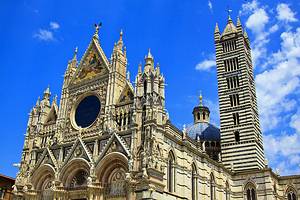
Places to Visit near Florence: Several of the best places to visit in Italy are close to the city. The beautiful medieval city of Siena to the south is crowned by one of Italy's most magnificent - and largest - cathedrals, filled with more art masterpieces than some major museums. This and a string of Medici villas are all easy day trips from Florence .
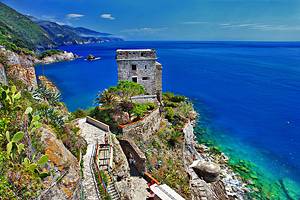
Where to Go from Florence: Pisa's famous Leaning Tower is one of the top tourist attractions in Italy , and only the beginning of beautiful Renaissance monuments and artworks to see there. Less well-known - and less crowded- is the charming, small city of Lucca , surrounded by walls so thick, there's a popular promenade along their tops. Beyond, the Tuscan coast leads into Liguria, with the five villages and magnificent scenery of the Cinque Terre .
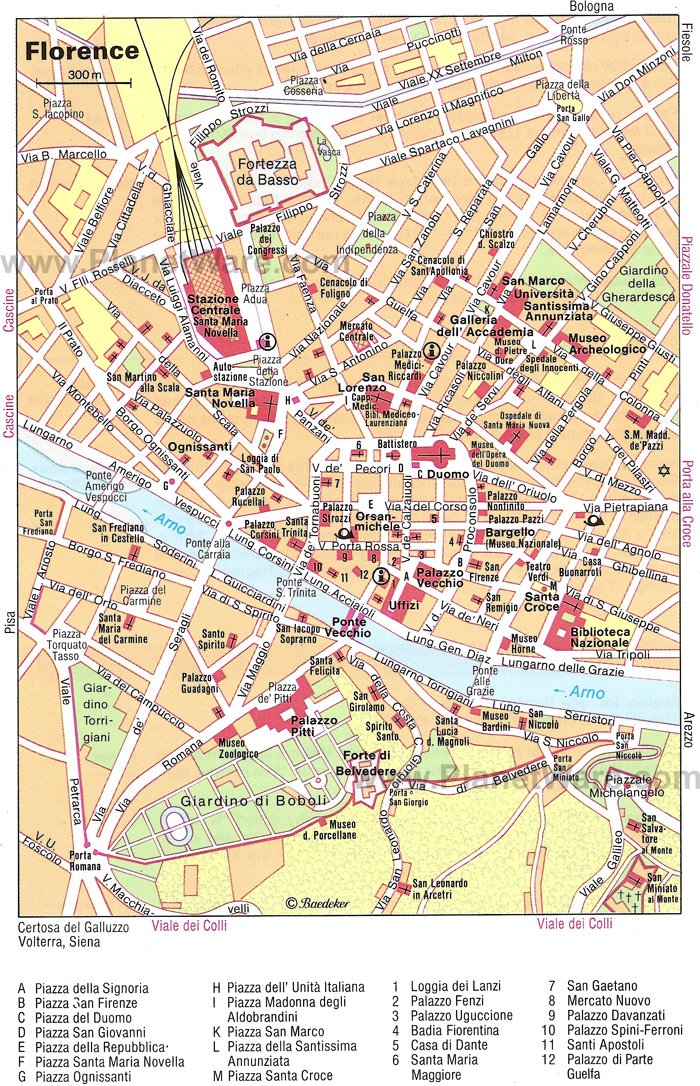
More on Italy


IMAGES
VIDEO
COMMENTS
The attractions that follow show off Italy's art, architecture, stunning landscapes, and history, as well as places to relax and enjoy Italian life. On This Page: 1. Colosseum, Rome. 2. Florence Duomo Santa Maria del Fiore. 3. The Grand Canal in Venice. 4.
La Pelosa is often compared to the Caribbean, bringing some of the tropics to Italy. Surfing, kayaking and even scuba diving are all possible things to do at or near La Pelosa. 22. Basilica of San Vitale in Ravenna. Dating back to the 6th century, the Basilica of San Vitale is a spectacular church in Ravenna.
The most visited tourist attractions in Italy are mentioned below: 10. Colosseum, Palatino, and Roman Forum. The Colosseum symbolizes Roman culture and history. It is an oval amphitheater that is located in Rome and is the biggest amphitheater to be ever built in the world. It was built between AD 72 and 80.
Cinque Terre. #5 in Best Places to Visit in Italy. Cinque Terre, located on Italy's northern Ligurian coast, is made up of five picturesque towns - Manarola, Monterosso, Vernazza, Corniglia and ...
Whatever the reason, this tiny pocket of northern Italy takes seductiveness to dizzying heights. 4. Amalfi Coast. Best for classic beauty. Italy's most celebrated coastline is a gripping strip: coastal mountains plunge into the piercing blue sea in a prime-time vertical scene of precipitous crags, sun-bleached villages and cliffs rearing up behind.
Renowned cities such as Rome, Venice, and Florence resonate with centuries of heritage, their artistic and architectural wonders drawing admirers from every corner of the globe to these amazing tourist attractions in Italy. Equally enchanting is Italy's natural beauty—from the sun-kissed coasts to serene alpine lakes and majestic mountains.
The Roman Colosseum. TripSavvy / Taylor McIntyre. View Map. Address. Piazza del Colosseo, 1, 00184 Roma RM, Italy. Phone +39 06 3996 7700. Web Visit website. Although there are other Roman amphitheaters in Italy, Rome's Colosseum is the world's largest and most visited Roman arena. Ancient Rome's huge amphitheater, built by Emperor Vespasian in ...
See ways to experience (939) 2023. 3. Duomo di Milano. 58,778. Religious Sites. Admission tickets from ₹1,841. The centerpiece of Milan, the Duomo is one of Europe's greatest architectural and cultural landmarks. As Italy's largest church and one of the largest in the world, it took over 600 years to build.
Famous tourist attractions in Italy. 1. Ancient Rome. Rome really does have it all. This is a city of contrasts, bathed in sunlight at any time of year. History is on every corner and you can glory in the sights of Ancient Rome, on the Palatine Hill and at the Colosseum, the Forum, the Pantheon and in the Capitoline Museums.
The Vatican Museum was founded in the 16th century, and today it records about 6 million visitors a year as one of the biggest tourist attractions in Italy. ... Experience the Top Attraction of the Magnificent Duomo in Italy. After St. Peter's Basilica in Rome, the Duomo Cathedral is the second-largest Catholic church in Italy. It is located ...
Duomo of Milan, Lombardy - 106,747 reviews "Oh mia bela Madunina" sang Giovanni D'Anzi in the 1930s, and the echo still resonates today. So much so that the Duomo of Milan is one of Italy's most visited attractions ever.The marvelous Gothic spires, the grandeur of the cathedral that dominates Piazza Duomo, crowned by one of the symbols of Milan, the Madonnina, attracts crowds of ...
Italy's Tourist Attractions - 10 Top Tourist Attractions In Italy. italy attractions tourist rome colosseum famous attraction. World Tourism: The Top Ten Best Tourist Spots In Italy. italy cathedral tourist milan spots tourism ten travel attractions gothic catholic wallpapers wallcoo duomo wallpaper places visit popular largest roof
Select Italy decided to help all those lucky travelers who are going to visit Italy by creating The 20 Most Visited Tourist Attractions in Italy Infographic - based on a statistical survey of the Ministry of Heritage and Cultural Activities - to give you data and insights about tourists' most visited spots of the Bel Paese. On the list ...
Speaking of Milan...this next Italian tourist attraction is a true wonder. (Locals tell us you'll find plenty of wonder in beautiful Milano!). The Milano Duomo is one of the oldest and largest cathedrals in Europe. Constructed in a decidedly Gothic style—which is different from most cathedrals in Italy—the Duomo looms over the city.
The currency used in Italy is the Euro which makes it easy if you are also travelling to other countries in the region! Speaking of money, since Italy is so popular - do watch your pockets and your belongings when travelling. There are lots of tourist traps to be aware of in Rome, Venice, and other popular centres (speaking from experience here).
The famous resorts of Portofino and Santa Margherita Ligore as well as the sandy beaches of Viareggio and Versilia are within easy reach. 5. Pompeii. Pompeii was a Roman city near Naples, in the Italian region of Campania. Following the eruption of Vesuvius in AD 79, the city of Pompeii was destroyed and covered by a thick layer of ash and ...
The biggest attraction, however, is the mixture of multicolored buildings in beautiful warm shades, situated directly on the rugged rocky coast. ... As long as Italy is a very popular tourist destination, Porto Pino is a great example of how many wonderful unspoiled places are still waiting to be found. 66. Cala Mariolu (Sardinia)
Phone +39 06 774 0021. Web Visit website. Like the majority of churches in Rome, the Basilica di San Clemente was built on top of a pagan site of worship. It's one of the best places in the city for understanding the complex "layering" of Rome, and of how buildings developed on top of other buildings.
The Appian Way is the most famous ancient road in Rome, connecting the city with Brindisi in southeastern Italy. Named after Appius Claudius Caecus, a Roman censor, it was originally a military road. ... The center of the Catholic world and a major tourist attraction, the Basilica of St. Peter is a huge church: with an interior height of 120 ...
19. Pirelli Hangar Bicocca. 20. Civica Galleria d'Arte Moderna (Modern Art Gallery) 21. Porta Nuova. Where to Stay in Milan for Sightseeing. Tips and Tours: How to Make the Most of Your Visit to Milan. Map of Tourist Attractions & Things to Do in Milan.
4.7. Galleria Vittorio Emanuele II, built in 1867, is a huge glass-roofed shopping arcade lined with elegant shops, bars, and restaurants. Inside are mosaics with the symbols of the cities forming the newly united Italy. Some people consider it good luck to stand on the testicles of the bull of Turin.
20. Brancacci Chapel. 21. Museo Galileo. 22. Shop for Leather at Piazza Santa Croce. Where to Stay in Florence for Sightseeing. Tips and Tours: How to Make the Most of Your Visit to Florence. Map of Tourist Attractions in Florence, Italy.